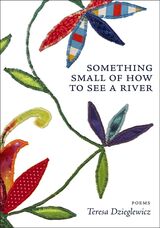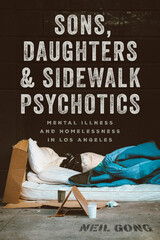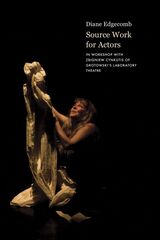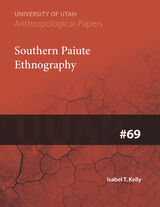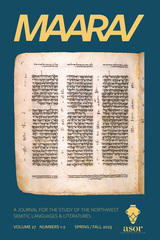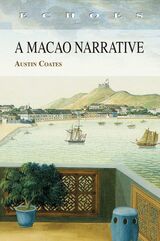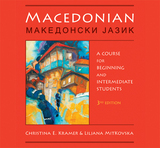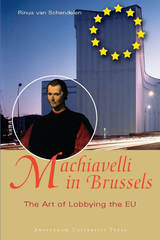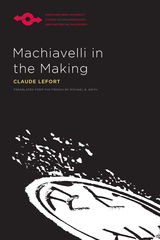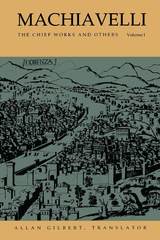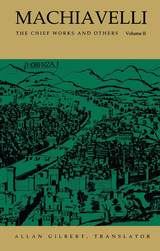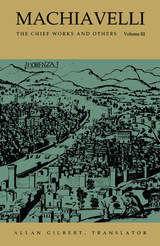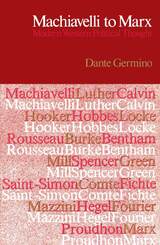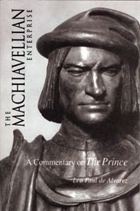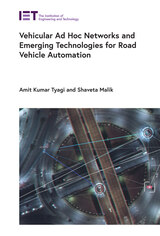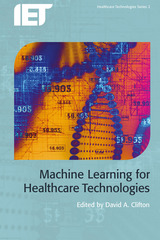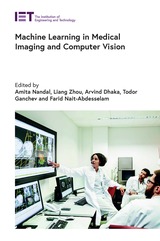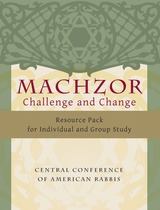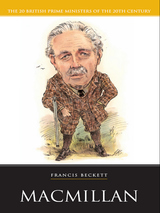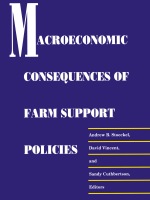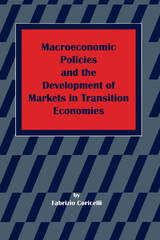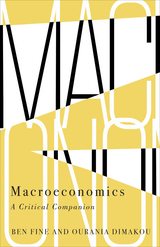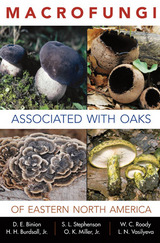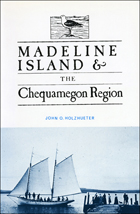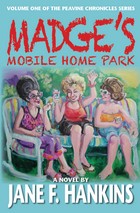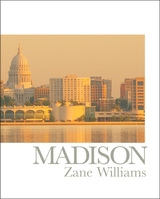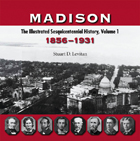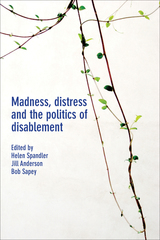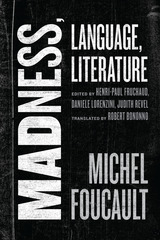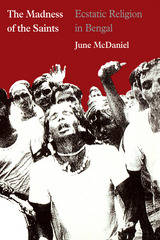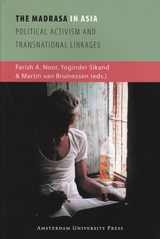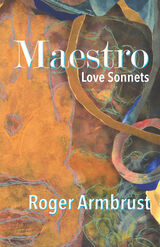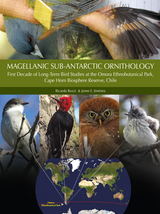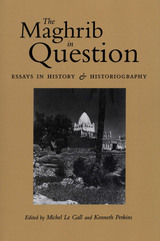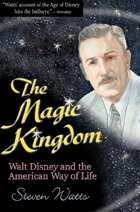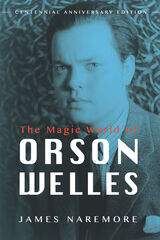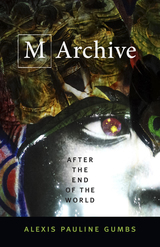 M Archive: After the End of the World
Alexis Pauline Gumbs
Duke University Press, 2018 Following the innovative collection Spill, Alexis Pauline Gumbs's M Archive—the second book in a planned experimental triptych—is a series of poetic artifacts that speculatively documents the persistence of Black life following a worldwide cataclysm. Engaging with the work of the foundational Black feminist theorist M. Jacqui Alexander, and following the trajectory of Gumbs's acclaimed visionary fiction short story “Evidence,” M Archive is told from the perspective of a future researcher who uncovers evidence of the conditions of late capitalism, antiblackness, and environmental crisis while examining possibilities of being that exceed the human. By exploring how Black feminist theory is already after the end of the world, Gumbs reinscribes the possibilities and potentials of scholarship while demonstrating the impossibility of demarcating the lines between art, science, spirit, scholarship, and politics.
M is for Monster
Sherry M. Lindquist
Arizona Center for Medieval and Renaissance Studies, 2000
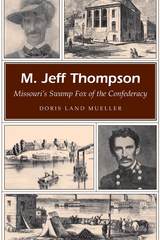 M. Jeff Thompson: Missouri's Swamp Fox of the Confederacy
Doris Land Mueller
University of Missouri Press, 2007 In the treacherous swamps of southeast Missouri, a different kind of Civil War was waged. Meriwether Jeff Thompson was one of the most intriguing but least-known Missouri participants in the Civil War. He and his troops traveled fast and light to harass Union forces, materializing out of the countryside to surprise the enemy and evading the traps set for them by Northern commanders. Early in the war, Union General Ulysses S. Grant gave Thompson the name “Swamp Fox” for his exploits in the Bootheel region. This book now tells his story—an adventure that will be appreciated by readers of all ages. Doris Mueller has produced a meticulously researched account of Thompson’s life, from his Virginia boyhood and early successes to his wartime exploits and postwar life. When the war began, Thompson left his adopted city of St. Joseph—where he had served as mayor—to fight for the Confederacy. He was elected brigadier general in the First Military District of Southeast Missouri and led poorly equipped and loosely trained men in skirmishes and raids, often using guerrilla tactics. He was captured in August 1863. After being released twelve months later in a prisoner exchange, he joined Sterling Price’s ill-fated raid into Missouri. After the war, he was one of the first Southern leaders to seek reinstatement as a U.S. citizen and worked to allay hostilities among fellow Southerners. Thompson was also known as the “Poet Laureate of the Marshes,” and Mueller includes numerous excerpts from his writings about his experiences. Her account not only provides a wealth of little-known biographical details about this important Missourian but also offers insight into the state’s unique experiences during that bloody era, personalizing events through the life of this brave soldier. Scorned by the Northern press for impudence, but beloved as a leader by his men, Thompson was courageous in battle, often to the point of recklessness, making him a constant thorn in the side of Union forces; after the war he was an oft-maligned model for reconciliation. Doris Mueller’s recounting of his life is an action-adventure story that will delight readers as it attests to his important role in Missouri’s heritage.
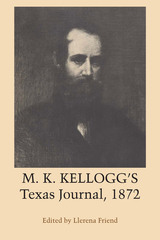 M. K. Kellogg's Texas Journal, 1872
Miner Kilbourne Kellogg
University of Texas Press, 1967 Miner Kilbourne Kellogg’s notes about his experiences with “the most completely and comfortably fitted-out expedition which ever went to Texas” is an account of the beauty, the wildness, and the dangers and inconveniences of 1872 Texas. Editor Llerena Friend provides a setting for the journal by tracing the search for mineral wealth in post–Civil War Texas; by describing the aims of the Eastern-born Texas Copper and Land Association, whose expedition the diarist accompanied; and by narrating the life of Miner K. Kellogg—artist, world traveler, writer. Friend’s annotation of the journal fills in details about the names, places, and events that Kellogg mentions. As the expedition travels across North Texas toward Double Mountain, Kellogg reveals himself not only as a man of artistic vision but also as a chronic complainer, an accomplished observer of human nature and individual personality, and a skillful interpreter of problems that beset the people in the uncivilized regions of Texas. A cultured gentleman who had traveled the world and had sat in the company of presidents and princes, this non-Texan was disdainful of the “texans” of the wilderness, for whom “Cards & vulgar slang & stories of Indian adventures form the staple of their mental exercises.” An artist, he was often unable to draw, either because of his constant illnesses and frustrations or because of the unfavorable encampments of the party. Accustomed to the amenities and comforts of life, he criticized the lack of leadership and the purpose of the expedition, and complained incessantly of the chiggers, the “want of cleanliness decency & health,” and “the infernal bacon,” which became the stock fare. Amid the complaints and derisions, however, appear vivid images of the Texas landscape, set down in word pictures by an artist’s pen: the night sky, “with a half moon now & then eclipsed by dark clouds passing over the clear starry vault of bluish grey”; the river-bank soil of “Vandyke brown color”; the mesquite trees in a melancholy and wild basin, “without a leaf upon their dead carcasses, yet still standing & clinging to the hope of resurrection from the life yet remaining in their roots”; and the “acres of the brilliant yellow Compositea & pink sabatea-like carpets spread in the morning air.” Kellogg’s watercolor sketches were unfortunately lost in travel, but his literary record, “M. K. Kellogg’s Mems, Exploring Expedition to Texas, 1872,” remains as a personal account of an abortive attempt to exploit the natural resources of the Texas frontier during Reconstruction and an artist’s picture of the life and the land of that frontier.
M-80
Jim Daniels
University of Pittsburgh Press, 1993 In M-80, his third book of poems, Jim Daniels explores the sharp edges of urban life. His characters struggle for survival in the face of rising urban violence, racial tension, and a crumbling economy. The collection is named for one of the most dangerous fireworks found on city streets – an apt metaphor for an urban world where the fuse is always lit.
 Ma'am Jones of the Pecos
Eve Ball
University of Arizona Press, 1969 "...highly entertaining and provides a valuable picture of the New Mexico frontier." —Journal of the West
"An unusual story of an American pioneer woman who used a needle, skillet, or gun, as needed, and who tended the dying during frontier wars or outbreaks of equally deadly diseases." —The Old Bookaroos
"For vivid descriptions of pioneer life in southeastern New Mexico, no work of history or fiction can match Eve Ball's dramatic story of Barbara Jones and her family...Anyone who picks it up will be reluctant to stop reading... "Few western historians have made such expert use of oral history as Mrs. Ball. Colloquial language adds color; and carefully drawn sketches of the family, their acquaintances, and the major figures in Lincoln County provide a degree of intimacy seldom found in historical works. That the resulting tale is believable and deeply moving demonstrates just how effective these techniques can be." —Southwestern Historical Quarterly
Maarav, volume 27 number 1-2 (Spring 2023)
The University of Chicago Press
University of Chicago Press Journals, 2023 This is volume 27 issue 1-2 of Maarav. Maarav—A Journal for the Study of the Northwest Semitic Languages and Literatures is devoted to the texts and verbal objects of the ancient Levant featuring Aramaic, Hebrew, Phoenician, and related languages. In addition to research on their verbal features, Maarav welcomes inquiry into their material, visual, and social aspects, their cultural horizons and relationships, and contemporary interests like the technological developments in decipherment, storage, representation, and analysis and the history and current practices of acquiring and interpreting ancient objects.
Maarav, volume 28 number 1-2 (Spring 2024)
The University of Chicago Press
University of Chicago Press Journals, 2024 This is volume 28 issue 1-2 of Maarav. Maarav—A Journal for the Study of the Northwest Semitic Languages and Literatures is devoted to the texts and verbal objects of the ancient Levant featuring Aramaic, Hebrew, Phoenician, and related languages. In addition to research on their verbal features, Maarav welcomes inquiry into their material, visual, and social aspects, their cultural horizons and relationships, and contemporary interests like the technological developments in decipherment, storage, representation, and analysis and the history and current practices of acquiring and interpreting ancient objects.
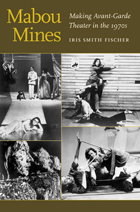 Mabou Mines: Making Avant-Garde Theater in the 1970s
Iris Smith Fischer
University of Michigan Press, 2012 The theater company Mabou Mines has for the past forty years created pathbreaking new theater by combining the latest concepts in music, visual arts, and technology with traditional forms of creative expression: puppetry, text, movement, theater design. From the beginning, the evanescence of performance and the dynamics of group work attracted the group. Most of their early pieces were never recorded, leaving little documentation of their foundational productions. Mabou Mines: Making Avant-Garde Theater in the 1970s provides this missing history, attempting to capture and describe the explorations of a group who set out to create indescribable performance. Iris Smith Fischer makes visible once again the celebrated company's least documented work, and offers accounts of the decisions and events that defined Mabou Mines' ideas and methods, particularly their creative collaborations with visual artists, musicians, writers, and dancers. Focusing on the heady days of the company's founding and first ten years, the book traces Mabou Mines' intellectual and artistic roots, frames them within the 1970s avant-garde, and outlines their significance in contemporary performance.
 Mac Runciman: A Life in the Grain Trade
Paul D. Earl
University of Manitoba Press, 2000 One of the most turbulent periods in the history of prairie agriculture is chronicled in a new book about the life and times of Alexander "Mac" Runciman, the Saskatchewan farmer who led the United Grain Growers as president from 1961 to 1981. Mac Runciman earned the respect and admiration on both sides of the great agriculture debates of the 1960s and 1970sófrom individual farmers to Pierre Trudeau, who offered Runciman a cabinet post in 1980 (Mac turned him down).Mac Runciman: A Life in the Grain Trade tells the story of how Runciman rose through the ranks of the UGG to play a central role in the fierce debates over the modernization of grain handling, subsidized freight rates, and the role of The Canadian Wheat Board. Runciman's reminiscences give new insights into the events and personalities of that critical period in Canadian agricultural history, a time in which the rural community began to question highly centralized and regulated marketing and transportation systems. The events and decisions of those years continue to reverberate in today's controversies over grain marketing and grain transportation.
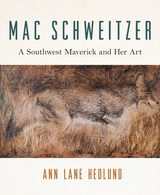 Mac Schweitzer: A Southwest Maverick and Her Art
Ann Lane Hedlund
University of Arizona Press, 2025 In Tucson during the 1950s, nearly everyone knew, or wanted to know, the southwestern artist Mac Schweitzer. Born Mary Alice Cox in Cleveland, Ohio, in 1921, she grew up a tomboy who adored horses, cowboys, and art. After training at the Cleveland School of Art and marrying, she adopted her maiden initials (M. A. C.) as her artistic name and settled in Tucson in 1946. With a circle of influential friends that included anthropologists, designer-craftsmen, and Native American artists, she joined Tucson’s “Early Moderns,” receiving exhibits, commissions, and awards for her artwork. When she died in 1962, Mac’s artistic legacy faded from public view, but her prize-winning works attest to a thriving career.
Author Ann Lane Hedlund draws from the artist’s letters, photo albums, and published reviews to tell the story of Mac’s creative and adventuresome life. Her watercolors, oil paintings, prints, and sculptures—a diverse body of work never before seen in public—range from naturalistic studies of Sonoran Desert animals to impressionistic landscapes to moody abstractions. A sharp observer of Indigenous life, she sketched and painted scenes of Navajo (Diné), Hopi, O’odham, and Yaqui people and events. These unique portrayals of the Southwest illustrate this saga of a maverick artist rediscovered.
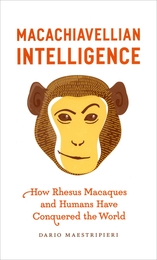 Macachiavellian Intelligence: How Rhesus Macaques and Humans Have Conquered the World
Dario Maestripieri
University of Chicago Press, 2007 Judged by population size and distribution, homo sapiens are clearly the most successful primates. A close second, however, would be rhesus macaques, who have adapted to—and thrived in—such diverse environments as mountain forests, dry grasslands, and urban sprawl. Scientists have spent countless hours studying these opportunistic monkeys, but rhesus macaques have long been overshadowed in the public eye by the great apes, who, because of their greater intelligence, are naturally assumed to have more to teach us, both about other primates and about humans as well.
Dario Maestripieri thinks it is high time we shelve that misperception, and with Macachiavellian Intelligence he gives rhesus macaques their rightful turn in the spotlight. The product of more than twenty years studying these fascinating creatures, Macachiavellian Intelligence caricatures a society that is as much human as monkey, with hierarchies and power struggles that would impress Machiavelli himself. High-status macaques, for instance, maintain their rank through deft uses of violence and manipulation, while altruism is almost unknown and relationships are perpetually subject to the cruel laws of the market. Throughout this eye-opening account, Maestripieri weds his thorough knowledge of macaque behavior to his abiding fascination with human society and motivations. The result is a book unlike any other, one that draws on economics as much as evolutionary biology, politics as much as primatology.
Rife with unexpected connections and peppered with fascinating anecdotes, Macachiavellian Intelligence has as much to teach us about humans as it does about macaques, presenting a wry, rational, and wholly surprising view of our humanity as seen through the monkey in the mirror.
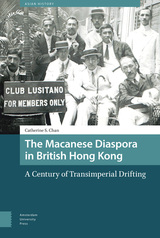 The Macanese Diaspora in British Hong Kong: A Century of Transimperial Drifting
Catherine S. Chan
Amsterdam University Press, 2021 Diaspora transformed the urban terrain of colonial societies, creating polyglot worlds out of neighborhoods, workplaces, recreational clubs, and public spheres. It was within these spaces that communities reimagined and reshaped their public identities vis-à-vis emerging government policies and perceptions from other communities. Through a century of Macanese activities in British Hong Kong, The Macanese Diaspora in British Hong Kong: A Century of Transimperial Drifting explores how mixed-race diasporic communities survived within unequal, racialized, and biased systems beyond the colonizer-colonized dichotomy. Originating from Portuguese Macau yet living outside the control of the empire, the Macanese freely associated with more than one identity and pledged allegiance to multiple communal, political, and civic affiliations. They drew on colorful imaginations of the Portuguese and British empires in responding to a spectrum of changes encompassing Macau’s woes, Hong Kong’s injustice, Portugal’s political transitions, global developments in print culture, and the rise of new nationalisms during the inter-war period.
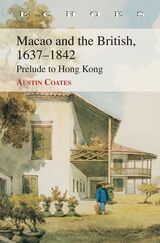 Macao and the British, 1637–1842: Prelude to Hong Kong
Austin Coates
Hong Kong University Press, 2009 The story of the British acquisition of Hong Kong is intricately related to that of the Portuguese enclave of Macao. The British acquired Hong Kong in 1841, following 200 years of European endeavours to induce China to engage in foreign trade. As a residential base of European trade, Portuguese Macao enabled the West to maintain continuous relations with China from 1557 onwards. Opening with a vivid description of the first English voyage to China in 1637. Macao and the British traces the ensuing course of Anglo-Chinese relations, during which time Macao skillfully—and without fortifications—escaped domination by the British and Chinese. The account covers the opening of regular trade by the East India Company in 1770, including the ‘country’ trade between India and China and Britain’s first embassies to Peking, and relates the bedeviling effect of the opium trade. The story culminates in the resulting war from which Britain won, as part of its concessions, the obscure island of Hong Kong. Among those who feature in this lucid and lively account are the merchant princes Jardine and Matheson, the missionary Robert Morrison, the artist George Chinnery, and Captain Charles Elliot, Hong Kong’s maligned founder.
A Macao Narrative
Austin Coates
Hong Kong University Press, 2009 Macao, 40 miles west of Hong Kong, became a place of Portuguese residence between 1555–57. In this short, lively and affectionate book, Austin Coates explains how and why the Portuguese came to the Far East, and how they peacefully settled in Macao with tacit Chinese goodwill. Macao’s golden age, from 1557 to the disastrous collapse of 1641, is vividly reconstructed. There follows the cuckoo-in-the-nest situation of the late eighteenth century when the British in Macao were a law unto themselves, until the foundation of Hong Kong and the opening of Shanghai gave wider scope for their energies. Portugal’s subsequent struggle to obtain full sovereignty in Macao, and the extraordinary outcome in 1975, brings this account to a close. Special tribute is paid to the risks Macao gallantly undertook in harbouring Hong Kong’s starving and destitute during World War II.
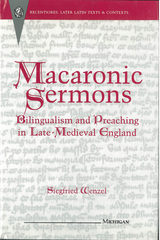 Macaronic Sermons: Bilingualism and Preaching in Late-Medieval England
Siegfried Wenzel
University of Michigan Press, 2010 Siegfried Wenzel's groundbreaking study seeks to describe and analyze the linguistically mixed, or macaronic, sermons in late fourteenth-century England. Not only are these works of considerable religious interest, they provide extensive information on their literary, linguistic, and cultural milieux. Macaronic Sermons begins by offering a typology of such works: those in which English words offer glosses, or offer structural functions, or offer neither of the two but yet are syntactically integrated. This last group is then examined in detail: reasons are given for this usage and for its origins, based on the realities of fourteenth-century England. Siefriend Wenzel draws valuable conclusions about the linguistic status quo of the era, together with the extent of education, the audiences' expectations, and the ways in which the authors' minds worked. Obviously of interest to scholars and students of early English literature, Macaronic Sermons also contains much valuable information for specialists in language development or oral theory, and for those interested in multicultural societies.
MacArthur's Japanese Constitution
Kyoko Inoue
University of Chicago Press, 1991 The Japanese constitution as revised by General MacArthur in 1946, while generally regarded to be an outstanding basis for a liberal democracy, is at the same time widely considered to be—in its Japanese form—an document which is alien and incompatible with Japanese culture. Using both linguistics and historical data, Kyoto Inoue argues that despite the inclusion of alien concepts and ideas, this constitution is nonetheless fundamentally a Japanese document that can stand on its own.
"This is an important book. . . . This is the most significant work on postwar Japanese constitutional history to appear in the West. It is highly instructive about the century-long process of cultural conflict in the evolution of government and society in modern Japan."—Thomas W. Burkman, Monumenta Nipponica
 Macau and Catholic Sacred Music Across the Sino-Western Divide
Jen-yen Chen
University of Michigan Press, 2026 For three centuries, the former Portuguese colony of Macau served as the gateway into mainland China and the locale for the development of an Asian Catholic culture that encompassed distinctive musical practices and styles. Macau and Catholic Music Across the Sino-Western Divide draws extensively upon historical documents in Chinese and Portuguese for a polylingual approach to Catholic sacred music. Jen-yen Chen follows this music from the sixteenth century through the twentieth by reading literary accounts of sound, primary source documents, and musical notation to examine the impacts of linguistic, political, and cultural divides and the ways sounds have traveled across these divides. Chen covers Chinese responses to Western sounds in Macau and southern China, illuminating the strategies for the use of sounds and musicking adopted by Jesuit missionaries; and the complexities of identity formation negotiated by Macau Catholics who confront exceptionalist historical discourses of Chinese or Portuguese “greatness.”
Drawing from sound studies and musicological methods, Chen argues that Chinese descriptions of Catholic sounds in Macau, including the ringing of church bells, the playing of the organ, and choral singing, illuminate spatial, sonic, and ideological mobilities that reconfigure Chinese and European identities. Macau and Catholic Music Across the Sino-Western Divide also extends to contemporary times to explore how present day members of Macau’s Catholic community position themselves in relation to the historical narratives often told about their city, cultivating a rich individuality of identity that refuses conformity to fixed notions of Asianness or Westernness.
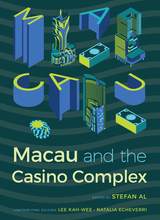 Macau and the Casino Complex
Stefan Al
University of Nevada Press, 2018 Special Award of the Jury Winner — 2018 Gourmand World Cookbook Awards
In only a decade, Macau has exploded from a sleepy backwater to the world’s casino capital. It was bound to happen. Macau, a former Portuguese colony that became a special administrative region within the People’s Republic of China in 1999, was the only place in China where gambling was legal. With a consumer base of 1.3 billion mainland Chinese deprived of casino gambling, and the world’s largest growing consumer class, international corporations rushed in to enter the games. As a result, the casino influx has permanently transformed the Macau peninsula: its ocean reclaimed, hillside excavated, roads congested, air polluted, and glimmering hotel towers tossed into the skyline, dwarfing the 19th century church towers.
Essays by a number of experts give a deeper insight on topics ranging from the myth of the Chinese gambler, the role of feng shui in casino design, the city’s struggle with heritage conservation, the politics of land reclamation, and the effect of the casino industry on the public realm. Drawings and photographs in vivid color visualize Macau’s patchwork of distinct urban enclaves: from downtown casinos, their neon-blasting storefronts eclipsing adjacent homes and schools, to the palatial complexes along a new highway, a Las Vegas-style strip. They also reveal how developers go to great lengths to impress the gambler with gimmicks such as fluorescent lighting, botanic gardens, feng shui dragon statues, cast members’ costumes, Chinese art imitations, and crystal chandelier-decked elevators. It is a book that helps readers grasp the complex process of the development of the casino industry and its overall impact on the social and architectural fabric of the first and last colonial enclave in China.
 Macaulay: The Tragedy of Power
Robert E. Sullivan
Harvard University Press, 2009 On the 150th anniversary of the death of the English historian and politician Thomas Babington Macaulay, Robert Sullivan offers a portrait of a Victorian life that probes the cost of power, the practice of empire, and the impact of ideas.
His Macaulay is a Janus-faced master of the universe: a prominent spokesman for abolishing slavery in the British Empire who cared little for the cause, a forceful advocate for reforming Whig politics but a Machiavellian realist, a soaring parliamentary orator who avoided debate, a self-declared Christian, yet a skeptic and a secularizer of English history and culture, and a stern public moralist who was in love with his two youngest sisters.
Perhaps best known in the West for his classic History of England, Macaulay left his most permanent mark on South Asia, where his penal code remains the law. His father ensured that ancient Greek and Latin literature shaped Macaulay’s mind, but he crippled his heir emotionally. Self-defense taught Macaulay that power, calculation, and duplicity rule politics and human relations. In Macaulay’s writings, Sullivan unearths a sinister vision of progress that prophesied twentieth-century genocide. That the reverent portrait fashioned by Macaulay’s distinguished extended family eclipsed his insistent rhetoric about race, subjugation, and civilizing slaughter testifies to the grip of moral obliviousness.
Devoting his huge talents to gaining power—above all for England and its empire—made Macaulay’s life a tragedy. Sullivan offers an unsurpassed study of an afflicted genius and a thoughtful meditation on the modern ethics of power.
 Macauley's Thumb
Lex Williford
University of Iowa Press, 1994 Lex Williford's seriously eccentric characters find that traveling down life's highway leads to the breakdown lane as quickly as it leads to the fast lane. Their quirky philosophy can best be summed up by Bucklin Rudd, who just lost his business and his wife after losing the last bit of his good sense: “Nothing like working half your life for something just to find out you think you're pretty damn sure you don't want it.” The ten stories in Macauley's Thumb—set variously in Texas, Old and New Mexico, Oklahoma, Arkansas, Alabama, and Illinois—explore the complicated lives of disenchanted characters who find ways to express their grief at the losses they face under impossible circumstances, losses so large and so small that no one—not even Smiling Joe's insurance—can cover them. A husband and wife, unable to speak to each other without arguing, face the dissolution of their marriage when they smuggle his mother's body out of Mexico. Two boys, confronting abandonment by their father, go to the Texas State Fair and stumble upon a way to get their mother out of bed. Thomas “Hoot” Ponder and his nephew find common ground in whiskey and storytelling amid the comedy surrounding death and dying. A chiropractor who loves science fiction movies struggles with his sexual fantasies about one of his patients, a Wal-Mart cashier who can't stop talking about her pain. In the powerful title story, Cal Macauley—driven mad by his wife's horrible death—faces mourning, regret, and the inevitability of forgetting by striking out against himself and the rattlesnakes on his mountain.
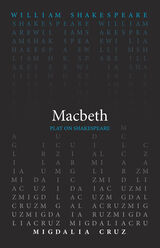 Macbeth
William Shakespeare
Arizona Center for Medieval and Renaissance Studies, 2021 In Migdalia Cruz’s Macbeth, the Witches run the world. The Macbeths live out a dark cautionary tale of love, greed, and power, falling from glory into calamity as the Witches spin their fate. Translating Shakespeare’s language for a modern audience, Nuyorican playwright Migdalia Cruz rewrites Macbeth with all the passion of the Bronx. This translation of Macbeth was presented in 2018 as part of the Play On! Shakespeare project, an ambitious undertaking from the Oregon Shakespeare Festival that commissioned new translations of 39 Shakespeare plays. These translations present the Bard’s work in language accessible to modern audiences while never losing the beauty of Shakespeare’s verse. Enlisting the talents of a diverse group of contemporary playwrights, screenwriters, and dramaturges from diverse backgrounds, this project reenvisions Shakespeare for the twenty-first century. These volumes make these works available for the first time in print—a new First Folio for a new era.
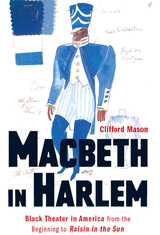 Macbeth in Harlem: Black Theater in America from the Beginning to Raisin in the Sun
Clifford Mason
Rutgers University Press, 2020 2020 George Freedley Memorial Award Special Jury Prize from the Theatre Library Association
2021 PROSE Awards Finalist, Music & the Performing Arts
In 1936 Orson Welles directed a celebrated all-black production of Macbeth that was hailed as a breakthrough for African Americans in the theater. For over a century, black performers had fought for the right to perform on the American stage, going all the way back to an 1820s Shakespearean troupe that performed Richard III, Othello, and Macbeth, without relying on white patronage.
"Macbeth" in Harlem tells the story of these actors and their fellow black theatrical artists, from the early nineteenth century to the dawn of the civil rights era. For the first time we see how African American performers fought to carve out a space for authentic black voices onstage, at a time when blockbuster plays like Uncle Tom’s Cabin and The Octoroon trafficked in cheap stereotypes. Though the Harlem Renaissance brought an influx of talented black writers and directors to the forefront of the American stage, they still struggled to gain recognition from an indifferent critical press.
Above all, "Macbeth" in Harlem is a testament to black artistry thriving in the face of adversity. It chronicles how even as the endemic racism in American society and its theatrical establishment forced black performers to abase themselves for white audiences’ amusement, African Americans overcame those obstacles to enrich the nation’s theater in countless ways.
 Macbeth: Melodramma in Four Acts. Libretto by Francesco Maria Piave
Giuseppe Verdi
University of Chicago Press, 2005 Verdi had a special fondness for Macbeth, and the first version of his opera based on Shakespeare's play is arguably the most important work of his formative years. But dissatisfied with the work of his librettist, Francesco Maria Piave, Verdi reworked the text himself and lavished the score with particular attention. The premiere in Florence in 1847 was a great success, but for the Paris premiere in 1865, Verdi made substantial changes, adding dances and an entirely new aria, duet, chorus, and death scene. Clearly, he intended that Macbeth II supersede the earlier version, and today the "Paris" version is the one generally performed.
Published in three volumes, this critical edition of Macbeth is the only one based entirely on autograph sources. Containing the later version as the principal score, it is the first edition to consult the composer's manuscripts of the revised pieces, preserved at the Bibliothèque Nationale in Paris. An appendix contains the earlier movements, and David Lawton provides a wide-ranging introduction to the opera's complex history. This critical edition of Macbeth includes here for the first time Verdi's preferred text—the version he set to music—as well as his own stage directions and thus offers the most vivid and dramatic reading to date.
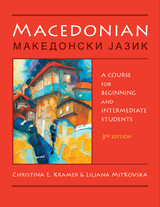 Macedonian: A Course for Beginning and Intermediate Students
Christina E. Kramer
University of Wisconsin Press, 2011 Macedonian, the official language of the Republic of Macedonia, is spoken by two and a half million people in the Balkans, North America, Australia, and other émigré communities around the world. Christina E. Kramer’s award-winning textbook provides a basic introduction to the language. Students will learn to speak, read, write, and understand Macedonian while discussing family, work, recreation, music, food, health, housing, travel, and other topics.
Intended to cover one year of intensive study, this third edition updates the vocabulary, adds material to help students appreciate the underlying structure of the language, and offers a wide variety of new, proficiency-based readings and exercises to boost knowledge of Macedonian history, culture, literature, folklore, and traditions.
Winner, Best Contribution to Language Pedagogy, American Association of Teachers of Slavic and Eastern European Languages
Macedonian Audio Supplement: To accompany Macedonian: A Course for Beginning and Intermediate Students, Third Edition
Christina E. Kramer
University of Wisconsin Press, 2012 This set of audio CDs is designed to supplement the award-winning language textbook Macedonian: A Course for Beginning and Intermediate Students, Third Edition, by Christina E. Kramer and Liljana Mitkovska. The CDs contain almost two hours of audio tracks that were recorded in Macedonia by native speakers who bring to life the characters from the textbook’s story. The set additionally includes exercises for listening comprehension and the pronunciation of individual sounds.
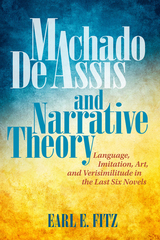 Machado de Assis and Narrative Theory: Language, Imitation, Art, and Verisimilitude in the Last Six Novels
Earl E. Fitz
Bucknell University Press, 2019 This book makes the argument that Machado de Assis, hailed as one of Latin American literature’s greatest writers, was also a major theoretician of the modern novel form. Steeped in the works of Western literature and an imaginative reader of French Symbolist poetry, Machado creates, between 1880 and 1908, a “new narrative,” one that will presage the groundbreaking theories of Swiss linguist Ferdinand de Saussure by showing how even the language of narrative cannot escape being elusive and ambiguous in terms of meaning. It is from this discovery about the nature of language as a self-referential semiotic system that Machado crafts his “new narrative.” Long celebrated in Brazil as a dazzlingly original writer, Machado has struggled to gain respect and attention outside the Luso-Brazilian ken. He is the epitome of the “outsider” or “marginal,” the iconoclastic and wildly innovative genius who hails from a culture rarely studied in the Western literary hierarchy and so consigned to the status of “eccentric.” Had the Brazilian master written not in Portuguese but English, French, or German, he would today be regarded as one of the true exemplars of the modern novel, in expression as well as in theory.
Published by Bucknell University Press. Distributed worldwide by Rutgers University Press.
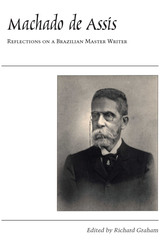 Machado de Assis: Reflections on a Brazilian Master Writer
By Richard Graham
University of Texas Press, 1999 Joaquim Maria Machado de Assis (1839-1908) never left Brazil and rarely traveled outside his native city of Rio de Janeiro, yet he is widely acknowledged by those who have read him as one of the major authors of the nineteenth century. His works are full of subtle irony, relentless psychological insights, and brilliant literary innovations. Yet, because he wrote in Portuguese, a language outside the mainstream of Western culture, those with access to his writings are relatively few. This book is designed not only to call new attention to this master but also to raise questions about the nature of literature itself and current alternative views on how it can be approached. Four essays address the question of Machado's "realism" in the five masterpiece novels of his maturity, especially Dom Casmurro. The noted contributors include John Gledson (University of Liverpool), João Adolfo Hansen (Universidade de São Paulo), Sidney Chalhoub (Universidade de Campinas), and Daphne Patai (University of Massachusetts at Amherst). Dain Borges of the University of California at San Diego says, "[This is the] only collection explicitly debating the question that polarizes contemporary Brazilian criticism of Machado de Assis: was he a sophisticated late realist, or was he a pioneering anti-realist, even a postmodernist? The [essayists] marshal their evidence and argument with virtuosity and arrive at sharply opposing conclusions."
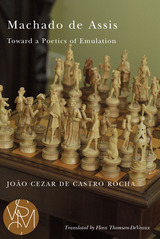 Machado de Assis: Toward a Poetics of Emulation
João Cezar de Castro Rocha
Michigan State University Press, 2015 This book offers an alternative explanation for one of the core dilemmas of Brazilian literary criticism: the “midlife crisis” Machado de Assis underwent from 1878 to 1880, the result of which was the writing of The Posthumous Memoirs of Brás Cubas, as well as the remarkable production of his mature years—with an emphasis on his masterpiece, Dom Casmurro.
At the center of this alternative explanation, Castro Rocha situates the fallout from the success enjoyed by Eça de Queirós with the publication of Cousin Basílio and Machado’s two long texts condemning the author and his work. Literary and aesthetic rivalries come to the fore, allowing for a new theoretical framework based on a literary appropriation of “thick description,” the method proposed by anthropologist Clifford Geertz. From this method, Castro Rocha derives his key hypothesis: an unforeseen consequence of Machado’s reaction to Eça’s novel was a return to the classical notion of aemulatio, which led Machado to develop a “poetics of emulation.”
 Machiavelli: A Portrait
Christopher S. Celenza
Harvard University Press, 2015 “Machiavellian”—used to describe the ruthless cunning of the power-obsessed and the pitiless—is never meant as a compliment. But the man whose name became shorthand for all that is ugly in politics was more engaging and nuanced than his reputation suggests. Christopher S. Celenza’s Machiavelli: A Portrait removes the varnish of centuries to reveal not only the hardnosed political philosopher but the skilled diplomat, learned commentator on ancient history, comic playwright, tireless letter writer, and thwarted lover.
Machiavelli’s hometown was the epicenter of the Italian Renaissance in the fifteenth century, a place of unparalleled artistic and intellectual attainments. But Florence was also riven by extraordinary violence. War and public executions were commonplace—Machiavelli himself was imprisoned and brutally tortured at the behest of his own government. These experiences left a deep impression on this keen observer of power politics, whose two masterpieces—The Prince and The Discourses—draw everywhere on the hard-won wisdom gained from navigating a treacherous world. But like many of Machiavelli’s fellow Florentines, he also immersed himself in the Latin language and wisdom of authors from the classical past. And for all of Machiavelli’s indifference to religion, vestiges of Christianity remained in his thought, especially the hope for a redeemer—a prince who would provide the stability so rare in Machiavelli’s worldly experience.
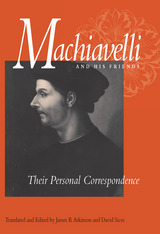 Machiavelli and His Friends: Their Personal Correspondence
Niccolò Machiavelli
Northern Illinois University Press, 1996
The intimate world of Niccolò Machiavelli comes to life in this first complete collection in English of the letters he wrote and received. Spanning his adult life from 1497 until his death in 1527, these letters to and from his friends and compatriots—some of whom, such as Francesco Guicciardini and Francesco Vettori, were among the most influential thinkers of the day—reveal his personality and present a panorama of life, people, and critical events in Renaissance Italy.
The correspondence offers valuable insight into the origins of Machiavelli's ideas on history, politics, literature, and society and the social context from which his achievements arose. Often his correspondence served as a testing ground for ideas he developed more fully in his writing. While the letters taken together show Machiavelli both living within and transcending his own time, on a more intimate level they reveal the human element that helped to shaped his thought. Machiavelli emerges as an individual with multifaceted capabilities and a multitude of roles, among them devoted humanist, political analyst, shrewd rhetorician, and practical joker.
Based on Franco Gaets's authoritative critical Italian edition of Machiavelli's correspondence, the collection includes 257 letters written to Machiavelli and 84 letters written by him. Arranged chronologically, correspondence to and by Machiavelli is interwoven so that readers may easily follow discussions between him and his associates. The translators' introduction establishes the political and cultural context of the correspondence, and headnotes introduce each section of letters. Explanatory and historical annotations illuminate people, places, and events mentioned within the letters.
Machiavelli's correspondence opens a window onto an important era in Western intellectual history, disclosing the language, thoughts, and preoccupations of some of the key people who shaped the Italian Renaissance. As the definitive edition, Machiavelli and His Friends will interest students of Machiavelli, specialists in political science and Renaissance literature and history, and general readers desiring to know more intimately one of the most fascinating personalities of the Renaissance.
Machiavelli in Brussels: The Art of Lobbying the EU
Rinus van Schendelen
Amsterdam University Press, 2002 Countless interest groups representing governments and civil societies try to lobby the European Union effectively in pursuit of the desired legislation, subsidies and more. This book describes the everyday practice of lobbying in Brussels, drawing on extensive research and the author's personal experience.
The objective of these interest groups is to influence the EU decision-making, of which they see themselves as a stakeholder. To the existing representative bodies such as the Parliament and the Council, they add their practice of lobbying for a desired outcome by making their interests present or represented at the EU level. In a roundabout way, they contribute to the EU integration and also to its democracy, so long as the following conditions are fulfilled.
Machiavelli in the Making
Claude Lefort; Translated from the French by Michael B. Smith
Northwestern University Press, 2011 Machiavelli in the Making is both a novel interpretation of the Florentine’s work and a critical document for understanding influential French scholar and public intellectual Claude Lefort’s later writings on democracy and totalitarianism. Lefort extricates Machiavelli’s thought from the dominant interpretations of him as the founder of “objective” political science, which, having liberated itself from the religious and moralizing tendencies of medieval political reflection, attempts to arrive at a realistic discourse on the operations of raw power. Lefort ultimately finds that Machiavelli’s discourse opens the “place of the political” which had previously been occupied by theology and morality.
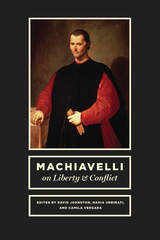 Machiavelli on Liberty and Conflict
Edited by David Johnston, Nadia Urbinati, and Camila Vergara
University of Chicago Press, 2017 More than five hundred years after Machiavelli wrote The Prince, his landmark treatise on the pragmatic application of power remains a pivot point for debates on political thought. While scholars continue to investigate interpretations of The Prince in different contexts throughout history, from the Renaissance to the Risorgimento and Italian unification, other fruitful lines of research explore how Machiavelli’s ideas about power and leadership can further our understanding of contemporary political circumstances.
With Machiavelli on Liberty and Conflict, David Johnston, Nadia Urbinati, and Camila Vergara have brought together the most recent research on The Prince, with contributions from many of the leading scholars of Machiavelli, including Quentin Skinner, Harvey Mansfield, Erica Benner, John McCormick, and Giovanni Giorgini. Organized into four sections, the book focuses first on Machiavelli’s place in the history of political thought: Is he the last of the ancients or the creator of a new, distinctly modern conception of politics? And what might the answer to this question reveal about the impact of these disparate traditions on the founding of modern political philosophy? The second section contrasts current understandings of Machiavelli’s view of virtues in The Prince. The relationship between political leaders, popular power, and liberty is another perennial problem in studies of Machiavelli, and the third section develops several claims about that relationship. Finally, the fourth section explores the legacy of Machiavelli within the republican tradition of political thought and his relevance to enduring political issues.
Machiavelli: The Chief Works and Others, 3 volume set
Allan Gilbert, ed.
Duke University Press Allan Gilbert is unquestionably the most accurate and reliable translator of Machiavelli into English; the publication of this edition is an altogether happy occasion. Students of the history of political thought owe a particular debt of gratitude to Allan Gilbert.”—Dante Germino, The Journal of Politics“A most remarkable achievement.”—Felix Gilbert, Renaissance Quarterly
Machiavelli: The Chief Works and Others, 3 volume set
Allan Gilbert, ed.
Duke University Press Allan Gilbert is unquestionably the most accurate and reliable translator of Machiavelli into English; the publication of this edition is an altogether happy occasion. Students of the history of political thought owe a particular debt of gratitude to Allan Gilbert.”—Dante Germino, The Journal of Politics“A most remarkable achievement.”—Felix Gilbert, Renaissance Quarterly
Machiavelli: The Chief Works and Others, Vol. I
Allan Gilbert, ed.
Duke University Press, 1989 From praise for the 1965 edition:Allan Gilbert is unquestionably the most accurate and reliable translator of Machiavelli into English; the publication of this edition is an altogether happy occasion. Students of the history of political thought owe a particular debt of gratitude to Allan Gilbert.”—Dante Germino, The Journal of Politics “A most remarkable achievement.”—Felix Gilbert, Renaissance Quarterly
Machiavelli: The Chief Works and Others, Vol. II
Allan Gilbert, ed.
Duke University Press, 1989 From praise for the 1965 edition:
Allan Gilbert is unquestionably the most accurate and reliable translator of Machiavelli into English; the publication of this edition is an altogether happy occasion. Students of the history of political thought owe a particular debt of gratitude to Allan Gilbert.”—Dante Germino, The Journal of Politics “A most remarkable achievement.”—Felix Gilbert, Renaissance Quarterly
Machiavelli: The Chief Works and Others, Vol. III
Allan Gilbert, ed.
Duke University Press, 1989 From praise for the 1965 edition:
Allan Gilbert is unquestionably the most accurate and reliable translator of Machiavelli into English; the publication of this edition is an altogether happy occasion. Students of the history of political thought owe a particular debt of gratitude to Allan Gilbert.”—Dante Germino, The Journal of Politics “A most remarkable achievement.”—Felix Gilbert, Renaissance Quarterly
Machiavelli to Marx: Modern Western Political Thought
Dante Germino
University of Chicago Press, 1979 According to conventional periodization, a profound break in the continuity of Western political theory occurred around 1500 and marked the beginning of "modern" political thought. In Machiavelli to Marx Dante Germino examines the scholars of this period whose works he feels have made significant new approaches to the critical understanding of our world and, consequently, to the problems of our time. Beginning with Machiavelli, the author covers major political philosophers such as Hobbes, Locke, Rousseau, and Burke and gives lucid, perceptive accounts of what they thought and taught about politics. He discusses utilitarianism, liberalism, scientism, and messianic nationalism through the writings of such influential thinkers as Bentham, Spencer, Saint-Simon, and Fichte and concludes with three of the foremost political philosophers of the nineteenth century—Fourier, Proudhon, and Marx.
The Machiavellian Enterprise
Leo Paul de Alvarez
Northern Illinois University Press, 2008
De Alvarez discovers a neglected argument in Machiavelli's masterpiece that encompasses much more than the education of a prince for the salvation of Italy. Building on a wealth of insight, he shows how Machiavelli, the "first political philosopher to turn to the many instead of the few as the basis of rule," sought to replace the domination of the Christian Rome with a civil, secular, and egalitarian state.
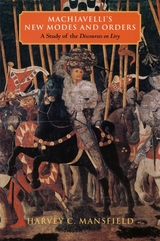 Machiavelli's New Modes and Orders: A Study of the Discourses on Livy
Harvey C. Mansfield
University of Chicago Press, 2001 Machiavelli's New Modes and Orders is the only full-length interpretive study on Machiavelli's controversial and ambiguous work, Discourses on Livy. These discourses, considered by some to be Machiavelli's most important work, are thoroughly explained in a chapter-by-chapter commentary by Harvey C. Mansfield, one of the world's foremost interpreters of this remarkable philosopher.
Mansfield's aim is to discern Machiavelli's intention in writing the book: he argues that Machiavelli wanted to introduce new modes and orders in political philosophy in order to make himself the founder of modern politics. Mansfield maintains that Machiavelli deliberately concealed part of his intentions so that only the most perceptive reader could see beneath the surface of the text and understand the whole of his book. Previously out of print, Mansfield's penetrating study brings to light the hidden thoughts lurking in the details of the Discourses on Livy to inform and challenge its readers at every step along the way.
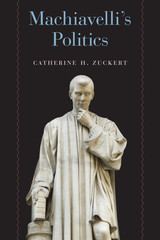 Machiavelli's Politics
Catherine H. Zuckert
University of Chicago Press, 2017 Machiavelli is popularly known as a teacher of tyrants, a key proponent of the unscrupulous “Machiavellian” politics laid down in his landmark political treatise The Prince. Others cite the Discourses on Livy to argue that Machiavelli is actually a passionate advocate of republican politics who saw the need for occasional harsh measures to maintain political order. Which best characterizes the teachings of the prolific Italian philosopher? With Machiavelli’s Politics, Catherine H. Zuckert turns this question on its head with a major reinterpretation of Machiavelli’s prose works that reveals a surprisingly cohesive view of politics.
Starting with Machiavelli’s two major political works, Zuckert persuasively shows that the moral revolution Machiavelli sets out in The Prince lays the foundation for the new form of democratic republic he proposes in the Discourses. Distrusting ambitious politicians to serve the public interest of their own accord, Machiavelli sought to persuade them in The Prince that the best way to achieve their own ambitions was to secure the desires and ambitions of their subjects and fellow citizens. In the Discourses, he then describes the types of laws and institutions that would balance the conflict between the two in a way that would secure the liberty of most, if not all. In the second half of her book, Zuckert places selected later works—La Mandragola, The Art of War, The Life of Castruccio Castracani, Clizia, and Florentine Histories—under scrutiny, showing how Machiavelli further developed certain aspects of his thought in these works. In The Art of War, for example, he explains more concretely how and to what extent the principles of organization he advanced in The Prince and the Discourses ought to be applied in modern circumstances. Because human beings act primarily on passions, Machiavelli attempts to show readers what those passions are and how they can be guided to have productive rather than destructive results.
A stunning and ambitious analysis, Machiavelli’s Politics brilliantly shows how many conflicting perspectives do inform Machiavelli’s teachings, but that one needs to consider all of his works in order to understand how they cohere into a unified political view. This is a magisterial work that cannot be ignored if a comprehensive understanding of the philosopher is to be obtained.
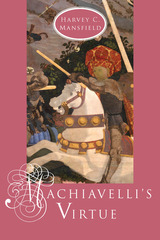 Machiavelli's Virtue
Harvey C. Mansfield
University of Chicago Press, 1996 Uniting thirty years of authoritative scholarship by a master of textual detail, Machiavelli's Virtue is a comprehensive statement on the founder of modern politics. Harvey Mansfield reveals the role of sects in Machiavelli's politics, his advice on how to rule indirectly, and the ultimately partisan character of his project, and shows him to be the founder of such modern and diverse institutions as the impersonal state and the energetic executive. Accessible and elegant, this groundbreaking interpretation explains the puzzles and reveals the ambition of Machiavelli's thought.
"The book brings together essays that have mapped [Mansfield's] paths of reflection over the past thirty years. . . . The ground, one would think, is ancient and familiar, but Mansfield manages to draw out some understandings, or recognitions, jarringly new."—Hadley Arkes, New Criterion
"Mansfield's book more than rewards the close reading it demands."—Colin Walters, Washington Times
"[A] masterly new book on the Renaissance courtier, statesman and political philosopher. . . . Mansfield seeks to rescue Machiavelli from liberalism's anodyne rehabilitation."—Roger Kimball, The Wall Street Journal
 Machine
Thomas Pringle
University of Minnesota Press, 2018 On the social consequences of machines
Automation, animation, and ecosystems are terms of central media-philosophical concern in today’s society of humans and machines. This volume describes the social consequences of machines as a mediating concept for the animation of life and automation of technology. Bernard Stiegler’s automatic society illustrates how digital media networks establish a new proletariat of knowledge workers. Gertrud Koch offers the animation of the technical to account for the pathological relations that arise between people and their devices. And Thomas Pringle synthesizes how automation and animation explain the history of intellectual exchanges that led to the hybrid concept of the ecosystem, a term that blends computer and natural science. All three contributions analyse how categories of life and technology become mixed in governmental policies, economic exploitation and pathologies of everyday life thereby both curiously and critically advancing the term that underlies those new developments: ‘machine.’
 Machine and Sovereignty: For a Planetary Thinking
yuk
University of Minnesota Press, 2024 Developing a new political thought to address today’s planetary crises
What is “planetary thinking” today? Arguing that a new approach is urgently needed, Yuk Hui develops a future-oriented mode of political thought that encompasses the unprecedented global challenges we are confronting: the rise of artificial intelligence, the ecological crisis, and intensifying geopolitical conflicts. Machine and Sovereignty starts with three premises. The first affirms the necessity of developing a new language of coexistence that surpasses the limits of nation-states and their variations; the second recognizes that political forms, including the polis, empire, and the state, are technological phenomena, which Lewis Mumford terms “megamachines.” The third suggests that a particular political form is legitimated and rationalized by a corresponding political epistemology. The planetary thinking that this book sketches departs from the opposition between mechanism and organism, which characterized modern thought, to understand the epistemological foundations of Hegel’s political state and Schmitt’s Großraum and their particular ways of conceiving the question of sovereignty. Through this reconstruction, Hui exposes the limits of the state and reflects on a new theoretical matrix based on the interrelated concepts of biodiversity, noodiversity, and technodiversity. Arguing that we are facing the limit of modernity, of the eschatological view of history, of globalization, and of the human, Hui conceives necessary new epistemological and technological frameworks for understanding and rising to the crises of our present and our future. Retail e-book files for this title are screen-reader friendly.
 Machine Art, 1934
Jennifer Jane Marshall
University of Chicago Press, 2012 In 1934, New York’s Museum of Modern Art staged a major exhibition of ball bearings, airplane propellers, pots and pans, cocktail tumblers, petri dishes, protractors, and other machine parts and products. The exhibition, titled Machine Art, explored these ordinary objects as works of modern art, teaching museumgoers about the nature of beauty and value in the era of mass production. Telling the story of this extraordinarily popular but controversial show, Jennifer Jane Marshall examines its history and the relationship between the museum’s director, Alfred H. Barr Jr., and its curator, Philip Johnson, who oversaw it. She situates the show within the tumultuous climate of the interwar period and the Great Depression, considering how these unadorned objects served as a response to timely debates over photography, abstract art, the end of the American gold standard, and John Dewey’s insight that how a person experiences things depends on the context in which they are encountered. An engaging investigation of interwar American modernism, Machine Art, 1934 reveals how even simple things can serve as a defense against uncertainty.
 Machine Art and Other Writings: The Lost Thought of the Italian Years
Ezra Pound
Duke University Press, 1996 Machine Art and Other Writings presents previously unpublished and rare writings by one of the literary giants of the modernist period, Ezra Pound. Written from the late 1920s to the early part of the 1940s, these essays, selected by Maria Luisa Ardizzone and including “Machine Art,” “How To Write,” “European Paideuma,” and “Pragmatic Aesthetics,” are typically Poundian in style—irascible, eccentric, and by turns both engaging and cryptic. Importantly, these essays from Pound’s Italian years shed light both on the sections of the Cantos written in the late 1940s and on the underpinnings of his well-known anti-Semitism.
The essays in this volume address Pound’s diverse aesthetic concerns, including his Vorticism and his criticism of Western metaphysics, his advancement of the machine as a new criterion for beauty, his encounter with the German Bauhaus movement, and his search for a type of writing ruled by mathematical rather than grammatical laws. Machine Art and Other Writings documents the wide proportions of Pound’s polemic against the abstractions of modernism and reveals the extent to which he was at odds with the metaphysical assumptions of his time. The volume, edited by Ardizzone, is the result of years of systematic and intensive study of Pound’s manuscripts, including glosses from the texts of his personal library. Proposing an unconventional approach to Pound studies that focuses on marginality and intertextuality, she subverts the canonical hierarchy of Pound’s works by revealing the power of texts considered marginalia.
General readers, students and scholars in the fields of European and American modernism, aesthetics, the history of technology, and art history, as well as Pound specialists and the many poets and writers influenced by Pound, will greet the publication of Machine Art and Other Writings with interest and anticipation.
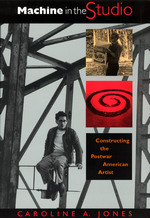 Machine in the Studio: Constructing the Postwar American Artist
Caroline A. Jones
University of Chicago Press, 1996 Taking a fresh look at the art world of the 1960s, Caroline Jones argues that far from the countercultural stance associated with the decade, the artists she examines—including Stella, Warhol, and Smithson—identified their work with postwar industry and corporate culture. Drawing on extensive interviews with artists and their assistants as well as close readings of artworks, Jones explains that much of the major work of the 1960s was compelling precisely because it was central to the visual and economic culture of its time.
"Jones manages to analyze art works in their historical, political, and conceptual context, giving them a thickness of description rarely possible in standard art history. . . . This is one of the best books on the period I have read so far. To paraphrase Clement Greenberg, it gives contemporary art history a good name."—Serge Guilbaut, Bookforum
"Though we are some 30 years past the events of the '60s, our world is still largely responding to them, as this marvelous book amply demonstrates."—David McCarthy, New Art Examiner
Machine Learning, Blockchain Technologies and Big Data Analytics for IoTs: Methods, technologies and applications
Amit Kumar Tyagi
The Institution of Engineering and Technology, 2022 Internet of Things (IoTs) are now being integrated at a large scale in fast-developing applications such as healthcare, transportation, education, finance, insurance and retail. The next generation of automated applications will command machines to do tasks better and more efficiently. Both industry and academic researchers are looking at transforming applications using machine learning and deep learning to build better models and by taking advantage of the decentralized nature of Blockchain. But the advent of these new technologies also brings very high expectations to industries, organisations and users. The decrease of computing costs, the improvement of data integrity in Blockchain, and the verification of transactions using Machine Learning are becoming essential goals.
Machine Learning for Healthcare Technologies
David A. Clifton
The Institution of Engineering and Technology, 2017 This book provides a snapshot of the state of current research at the interface between machine learning and healthcare with special emphasis on machine learning projects that are (or are close to) achieving improvement in patient outcomes. The book provides overviews on a range of technologies including detecting artefactual events in vital signs monitoring data; patient physiological monitoring; tracking infectious disease; predicting antibiotic resistance from genomic data; and managing chronic disease.
Machine Learning in Medical Imaging and Computer Vision
Amita Nandal
The Institution of Engineering and Technology, 2024 Medical images can highlight differences between healthy tissue and unhealthy tissue and these images can then be assessed by a healthcare professional to identify the stage and spread of a disease so a treatment path can be established. With machine learning techniques becoming more prevalent in healthcare, algorithms can be trained to identify healthy or unhealthy tissues and quickly differentiate between the two. Statistical models can be used to process numerous images of the same type in a fraction of the time it would take a human to assess the same quantity, saving time and money in aiding practitioners in their assessment.
 Machine Politics in Transition: Party and Community in Chicago
Thomas M. Guterbock
University of Chicago Press, 1980 Since 1932 elections and decision making in Chicago have been dominated by the Regular Democratic Organization of Cook County, led for a quarter of a century by the late Mayor Richard J. Daley. The extraordinary longevity of this Democratic machine provides the basis for this penetrating investigation into the nature of machine politics and grassroots party organization.
For three years, Thomas M. Guterbock participated in the daily activities of the Regular Democratic Organization in one North Side Chicago ward in order to discover how political machines win the support of the urban electorate. Guterbock's participant observation data, supplemented by a sample survey of ward residents' attitudes toward, and contacts with the machine, provide convincing evidence that the most widely accepted notions of how political machines work are no longer correct.
Contrary to conventional wisdom about the machine, Guterbock finds that the party does not secure votes by doing "favors" for people, nor do services rendered determine actual voting behavior. Instead, party loyalty is governed by such factors as social status, educational achievement, and bureaucratic competence. Guterbock finds that Democratic loyalists are drawn disproportionately from the ward's lowest strata. Ironically, the characteristics of these loyal Democrats contrast sharpely with the characteristics of those most likely to use party services.
What keeps the machine going, then? To answer this question, Guterbock takes us behind the scenes for a unique look inside the ward club. He shows how members develop loyalty and motivation beyond concern for their own pocketbooks. And he analyzes the public involvement of machine politicians in neighborhood affairs, describing the skillful—sometimes devious—ways in which they appeal to their constituents' sense of community. By focusing on the interplay of party loyalty and community attachments, Guterbock is able to explain the continued hegemony of Chicago's political machine and its enduring image of legitimacy.
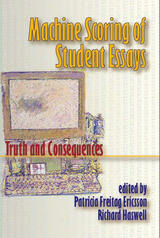 Machine Scoring of Student Essays: Truth and Consequences
edited by Patricia Freitag Ericsson & Rich Haswell
Utah State University Press, 2006 The current trend toward machine-scoring of student work, Ericsson and Haswell argue, has created an emerging issue with implications for higher education across the disciplines, but with particular importance for those in English departments and in administration. The academic community has been silent on the issue—some would say excluded from it—while the commercial entities who develop essay-scoring software have been very active. Machine Scoring of Student Essays is the first volume to seriously consider the educational mechanisms and consequences of this trend, and it offers important discussions from some of the leading scholars in writing assessment. Reading and evaluating student writing is a time-consuming process, yet it is a vital part of both student placement and coursework at post-secondary institutions. In recent years, commercial computer-evaluation programs have been developed to score student essays in both of these contexts. Two-year colleges have been especially drawn to these programs, but four-year institutions are moving to them as well, because of the cost-savings they promise. Unfortunately, to a large extent, the programs have been written, and institutions are installing them, without attention to their instructional validity or adequacy. Since the education software companies are moving so rapidly into what they perceive as a promising new market, a wider discussion of machine-scoring is vital if scholars hope to influence development and/or implementation of the programs being created. What is needed, then, is a critical resource to help teachers and administrators evaluate programs they might be considering, and to more fully envision the instructional consequences of adopting them. And this is the resource that Ericsson and Haswell are providing here.
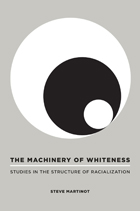 The Machinery of Whiteness: Studies in the Structure of Racialization
Authored by Steve Martinot
Temple University Press, 2010 In this follow up to his book, The Rule of Racialization—which considered the way class structure is formed in the U.S.—Steve Martinot now examines how the structures of racialization reside at the core of all social, cultural, and political institutions in the U.S. In The Machinery of Whiteness, Martinot examines how race and racism are produced in the United States, analyzing the politics of racialization, and the preponderance of racial segregation and racial deprivation that have kept the U.S. a white dominated society throughout its history. Martinot dedicates this work to expunging white supremacy from the earth. The Machinery of Whiteness investigates how “whiteness” came to be as foundational to the process that then produced the modern concept of race. Martinot addresses the instrumentalization of women as a necessary step in its formation, furthering the debates regarding the relationships of race and gender. And he addresses U.S. international interventionism, the anti-immigrant movements, and white racist populism to describe the political forms that white supremacy takes. Martinot puts these together to analyze the underlying cultural structures of racialization that have driven and conditioned the resurgence of white supremacy and white entitlement in the wake of the Civil Rights movements. This book is a call to transform the cultural structures of the U.S. to make justice and democracy, which depend on inclusion and not segregation, possible.
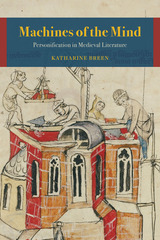 Machines of the Mind: Personification in Medieval Literature
Katharine Breen
University of Chicago Press, 2021
In Machines of the Mind, Katharine Breen proposes that medieval personifications should be understood neither as failed novelistic characters nor as instruments of heavy-handed didacticism. She argues that personifications are instead powerful tools for thought that help us to remember and manipulate complex ideas, testing them against existing moral and political paradigms. Specifically, different types of medieval personification should be seen as corresponding to positions in the rich and nuanced medieval debate over universals. Breen identifies three different types of personification—Platonic, Aristotelian, and Prudentian—that gave medieval writers a surprisingly varied spectrum with which to paint their characters.
Through a series of new readings of major authors and works, from Plato to Piers Plowman, Breen illuminates how medieval personifications embody the full range of positions between philosophical realism and nominalism, varying according to the convictions of individual authors and the purposes of individual works. Recalling Gregory the Great’s reference to machinae mentis (machines of the mind), Breen demonstrates that medieval writers applied personification with utility and subtlety, employing methods of personification as tools that serve different functions. Machines of the Mind offers insight for medievalists working at the crossroads of religion, philosophy, and literature, as well as for scholars interested in literary character-building and gendered relationships among characters, readers, and texts beyond the Middle Ages.
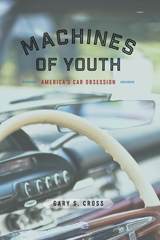 Machines of Youth: America’s Car Obsession
Gary S. Cross
University of Chicago Press, 2018 For American teenagers, getting a driver’s license has long been a watershed moment, separating teens from their childish pasts as they accelerate toward the sweet, sweet freedom of their futures. With driver’s license in hand, teens are on the road to buying and driving(and maybe even crashing) their first car, a machine which is home to many a teenage ritual—being picked up for a first date, “parking” at a scenic overlook, or blasting the radio with a gaggle of friends in tow. So important is this car ride into adulthood that automobile culture has become a stand-in, a shortcut to what millions of Americans remember about their coming of age.
Machines of Youth traces the rise, and more recently the fall, of car culture among American teens. In this book, Gary S. Cross details how an automobile obsession drove teen peer culture from the 1920s to the 1980s, seducing budding adults with privacy, freedom, mobility, and spontaneity. Cross shows how the automobile redefined relationships between parents and teenage children, becoming a rite of passage, producing new courtship rituals, and fueling the growth of numerous car subcultures. Yet for teenagers today the lure of the automobile as a transition to adulthood is in decline.Tinkerers are now sidelined by the advent of digital engine technology and premolded body construction, while the attention of teenagers has been captured by iPhones, video games, and other digital technology. And adults have become less tolerant of teens on the road, restricting both cruising and access to drivers’ licenses.
Cars are certainly not going out of style, Cross acknowledges, but how upcoming generations use them may be changing. He finds that while vibrant enthusiasm for them lives on, cars may no longer be at the center of how American youth define themselves. But, for generations of Americans, the modern teen experience was inextricably linked to this particularly American icon.
Machinic Eros: Writings on Japan
Félix Guattari
University of Minnesota Press, 2015 The French philosopher Félix Guattari frequently visited Japan during the 1980s and organized exchanges between French and Japanese artists and intellectuals. His immersion into the “machinic eros” of Japanese culture put him into contact with media theorists such as Tetsuo Kogawa and activists within the mini-FM community (Radio Home Run), documentary filmmakers (Mitsuo Sato), photographers (Keiichi Tahara), novelists (Kobo Abe), internationally recognized architects (Shin Takamatsu), and dancers (Min Tanaka). From pachinko parlors to high-rise highways, alongside corporate suits and among alt-culture comrades, Guattari put himself into the thick of Japanese becomings during a period in which the bubble economy continued to mutate. This collection of essays, interviews, and longer meditations shows a radical thinker exploring the architectural environment of Japan’s “machinic eros.”
The Machinists: A New Study in American Trade Unionism
Mark Perlman
Harvard University Press A truly authoritative study of a “model American union” (IAM has long been known as one of the most ethical and efficient), based on complete access to the organization’s files. Beginning with an interpretive history to 1953, the book analyzes IAM’s formal and informal structure and its policies with regard to other unions, employers, public, and government, isolating dynamic features of the decision making process. It includes documented evidence of the difficulties and analyzes both sides of the many controversies IAM has faced.
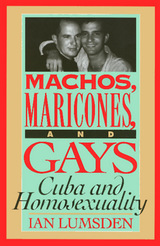 Machos Maricones & Gays: Cuba and Homosexuality
Ian Lumsden
Temple University Press, 1996 This remarkable account of gays in Cuba links the treatment of male homosexuality under Castro with prejudices and preconceptions prevalent in Cuban society before the Revolution. Ian Lumsden argues that much of the present discussion does not acknowledge the significant improvements that have occurred in the last decade. As an antidote to what he considers wide-spread misinformation, Lumsden locates the current issues surrounding homosexual identity within the broad context of Cuban culture, history, and social policy and makes revealing comparisons to the experience of homosexuals in other Latin American countries. Lumsden explores the historic roots of the oppression of homosexuals through such issues as race, religion, and gender. He considers the cultural history and current erosion of traditional "machismo," the correlation between traditional women's roles and the relationships between gay men, and homosexuality as defined by the law and as presented in typical sexual education. He addresses the international controversy over state-imposed sanatoriums for HIV/AIDS patients, and details the social scene, the varying ideals among different generations of gay Cubans, gay life and family ties, and the difference between being publicly and privately gay in Cuba. Lumsden's involvement over the years in gay culture in Cuba, his interviews with gay Cuban men, and his formidable scholarship produce a strikingly honest, accurate portrayal of the changes in homosexual life.
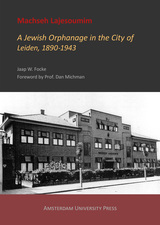 Machseh Lajesoumim: A Jewish Orphanage in the City of Leiden, 1890-1943
Jaap Focke
Amsterdam University Press, 2021 The Jewish Orphanage in Leiden was the last one of eight such care homes to open its doors in the Netherlands before the Second World War. After spending almost 39 years in an old and utterly inadequate building in Leiden's city centre, the inauguration in 1929 of a brand-new building, shown on the front cover, was the start of a remarkably productive and prosperous period.
The building still stands there, proudly but sadly, to this day: the relatively happy period lasted less than fourteen years. On Wednesday evening, 17th March 1943, the Leiden police, under German instructions, closed down the orphanage and delivered 50 children and nine staff to the Leiden railway station, from where they were brought to Transit Camp Westerbork in the north-east of the country. Two boys were released from Westerbork thanks to tireless efforts of a neighbour in Leiden; one young woman survived Auschwitz, and one young girl escaped to Palestine via Bergen-Belsen. The remaining 55 were deported to Sobibor – and not one of them survived.
Some 168 children lived in the new building at one time or another between August 1929 and March 1943. This book reconstructs life in the orphanage based on the many stories and photographs which they left us. It is dedicated to the memory of those who perished in the Holocaust, but also to those who survived. Without them, this book could not have been written.
Machzor, Volume 1: Challenge and Change
Rabbi Hara Person
Central Conference of American Rabbis, 2010 After having developed and published a new High Holy Day machzor, the CCAR invites Reform Jews to engage in study on related themes. This collection includes a wealth of material for individual or group study, including presentations on Un'taneh Tokef, Kol Nidrei, and Avinu Malkeinu, High Holy Day-themed essays from back issues of the CCAR Journal, and discussion questions.
 Mackintosh's Masterwork: The Glassgow School of Art
Edited by William Buchanan
Rutgers University Press, 2004 Of the many practitioners of art nouveau in Great Britain, Charles Rennie Mackintosh (1868–1928) has outlasted them all. His work bridged the more ornate style of the later nineteenth century and the forms of international modernism that followed. Like Frank Lloyd Wright, with whom he is frequently compared, he is known for so thoroughly integrating art and decoration that the two became inseparable. His work has been honored by a major exhibition at the Metropolitan Museum of Art, and his designs have proliferated to such an extent that they can be found reproduced in posters, prints, jewelry, and even new buildings. His most important project was the Glasgow School of Art, which still functions as a highly prestigious art school. This glorious building is visited each year by thousands of tourists from around the world. Built over a dozen years, beginning in 1897, the Glasgow School of Art is Mackintosh’s greatest and most influential legacy. This completely redesigned and heavily illustrated edition of Mackintosh’s Masterwork has been greatly expanded and contains newly discovered material about both the early life of the architect and the formative years in which his plans for the School of Art were executed.
Macmillan
Francis Beckett
Haus Publishing, 2006 Fatherly friend to JFK he repaired the rift between the USA and Britain created by the Suez crisis.
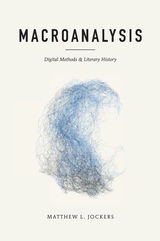 Macroanalysis: Digital Methods and Literary History
Matthew L. Jockers
University of Illinois Press, 2013 In this volume, Matthew L. Jockers introduces readers to large-scale literary computing and the revolutionary potential of macroanalysis--a new approach to the study of the literary record designed for probing the digital-textual world as it exists today, in digital form and in large quantities. Using computational analysis to retrieve key words, phrases, and linguistic patterns across thousands of texts in digital libraries, researchers can draw conclusions based on quantifiable evidence regarding how literary trends are employed over time, across periods, within regions, or within demographic groups, as well as how cultural, historical, and societal linkages may bind individual authors, texts, and genres into an aggregate literary culture. Moving beyond the limitations of literary interpretation based on the "close-reading" of individual works, Jockers describes how this new method of studying large collections of digital material can help us to better understand and contextualize the individual works within those collections.
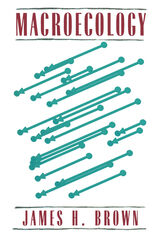 Macroecology
James H. Brown
University of Chicago Press, 1995 In Macroecology, James H. Brown proposes a radical new research agenda designed to broaden the scope of ecology to encompass vast geographical areas and very long time spans.
While much ecological research is narrowly focused and experimental, providing detailed information that cannot be used to generalize from one ecological community or time period to another, macroecology draws on data from many disciplines to create a less detailed but much broader picture with greater potential for generalization. Integrating data from ecology, systematics, evolutionary biology, paleobiology, and biogeography to investigate problems that could only be addressed on a much smaller scale by traditional approaches, macroecology provides a richer, more complete understanding of how patterns of life have moved across the earth over time. Brown also demonstrates the advantages of macroecology for conservation, showing how it allows scientists to look beyond endangered species and ecological communities to consider the long history and large geographic scale of human impacts.
An important reassessment of the direction of ecology by one of the most influential thinkers in the field, this work will shape future research in ecology and other disciplines.
"This approach may well mark a major new turn in the road in the history of ecology, and I find it extremely exciting. The scope of Macroecology is tremendous and the book makes use of its author's exceptionally broad experience and knowledge. An excellent and important book."—Lawrence R. Heaney, Center for Environmental and Evolutionary Biology, the Field Museum
Macroeconomic Consequences of Farm Support Policies
A. B. Stoeckel, David Vincent and Sandy Cuthbertson
Duke University Press, 1989 Agricultural protectionism is a basic factor underlying the U.S. trade deficit, Third World debt, and global underemployment. Yet despite the seriousness of the problem and attention given to it by many researchers, little progress has been made in formulating and implementing policies to deal with it.
The scholars and experts here assembled present for the first time a quantification and analysis of the impact upon the world economy of reduction or elimination of agricultural protectionism. They question why, give the magnitude of the problem, inferior policies endure despite the weight of evidence that they have failed. The answer they derive is that there is no general understanding of the true cost of the failure, and therefore it is necessary to initiate reform from outside agricultural circles.
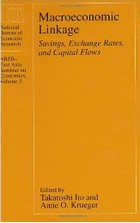 Macroeconomic Linkage: Savings, Exchange Rates, and Capital Flows
Edited by Takatoshi Ito and Anne O. Krueger
University of Chicago Press, 1994 This volume explores East Asia's macroeconomic experience in the 1980s and the economic impact of East Asia's growth on the rest of the world. The authors explore the causes of capital flows, changes in trade balances, and exchange rate fluctuations in East Asia and their effects on other countries.
These fourteen papers are organized around four themes: the overall determinants of growth and trading relations in the East Asian region; monetary policies in relation to capital controls and capital accounts; the impact of exchange rate behavior on industrial structure; and the potential for greater regional integration. The contributors examine interactions among exchange rate movements, trade balances, and capital flows; how government monetary policy affects capital flows; the effect of exchange rates on industrial structure, inventories, and prices; and the extent of regional integration in East Asia.
Macroeconomic Policies and the Development of Markets in Transition Economies
Fabrizio Coricelli
Central European University Press, 1998 Presenting the first integrated view of transition based on a unified analytical framework, this book evaluates the experience of several transition economies. Fabrizio Coricelli's view of transition emphasizes the connection between peculiar initial conditions and the effects of market reforms. Taking the starting point of underdeveloped markets and market institutions, he evaluates macroeconomic policies in relation to their impact on the development of markets. Coricelli stresses particularly financial markets – the 'missing' market under the system of central planning – and he highlights fundamental trade-offs for economic policy which can play a crucial role in determining the success of reforms.
 Macroeconomic Policy
Robert Barro
Harvard University Press, 1990 Combining powerful insights from theory with close observation of data, Robert Barro’s new book goes a long way toward the establishment of an empirically based macroeconomic theory.
Barro first presents a positive theory of government economic policymaking by using applied game theory to model strategic interactions between policymakers and the private sector. He applies this framework to questions of rules, discretion, and reputation in monetary policy. He then takes a close look at whether monetary disturbances have a strong effect on business fluctuations, concluding that the effect is neither as strong nor as pervasive as many economists have believed. He consequently turns his attention from monetary policy to fiscal policy. The originator of the modern theory of Ricardian equivalence, which says that taxes and budget deficits are logically equivalent, Barro summarizes the current debate and argues that the Ricardian theorem is the correct starting point for the analysis of intertemporal government finance. Finally, stating his belief that macroeconomists have probably spent too much time thinking about deficits—which relate to how government spending is financed—and not enough about the effects of government expenditures themselves, he examines evidence of the macroeconomic effects of government spending in the United States and Great Britain.
Macroeconomics: A Critical Companion
Ben Fine and Ourania Dimakou
Pluto Press, 2016 Macroeconomics is fundamental to our understanding of how the world functions today. But too often our understanding is based on orthodox, canonized analysis. In this rule-breaking book, Ben Fine and Ourania Dimakou provides an engaging, heterodox primer for those interested in an alternative to mainstream macroeconomic theory and history. From classical theory to the Keynesian revolution and more modern forms including the Monetarist counterrevolution, New Classical Fundamentalism, and New Consensus Macroeconomics, Fine and Dimakou rigorously and comprehensively lay out the theories of mainstream economists, warts and all.
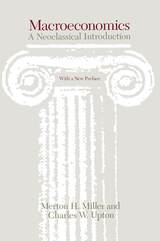 Macroeconomics: A Neoclassical Introduction
Merton H. Miller and Charles W. Upton
University of Chicago Press, 1986 "Miller and Upton is by far the most cited macroeconomics text in front line academic research journals over the last ten years. It has become a contemporary classic."—Roger C. Kormendi, University of Michigan
"The most innovative approach to introducing macroeconomics that I have seen. . . . A 'classic' in the sense that every serious student of macroeconomics is likely to want it in his or her library."—John P. Gould, University of Chicago
"The task the authors set out to perform is ambitious: to write a macroeconomics textbook structured around a neoclassical growth model. And in this task they have succeeded."—Clifford W. Smith, Jr., Journal of Finance
"This is a superb book. As a vehicle for teaching economics I have to place it right behind Henderson and Quant (Microeconomics) and Dorfman, Samuelson, and Solow (Linear Programming). Moreover, it is an exciting book both to read and to think about. . . . It is not just that these authors have something to say, but their way of saying it is generally superior."—F. E. Banks, Kyklos
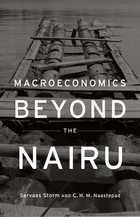 Macroeconomics Beyond the NAIRU
Servaas Storm and C. W. M. Naastepad
Harvard University Press, 2011 Economists and the governments they advise have based their macroeconomic policies on the idea of a natural rate of unemployment. Government policy that pushes the rate below this point—about 6 percent—is apt to trigger an accelerating rate of inflation that is hard to reverse, or so the argument goes. In this book, Storm and Naastepad make a strong case that this concept is flawed: that a stable non-accelerating inflation rate of unemployment (NAIRU), independent of macroeconomic policy, does not exist. Consequently, government decisions based on the NAIRU are not only misguided but have huge and avoidable social costs, namely, high unemployment and sustained inequality.
Skillfully merging theoretical and empirical analysis, Storm and Naastepad show how the NAIRU’s neglect of labor’s impact on technological change and productivity growth eclipses the many positive contributions that labor and its regulation make to economic performance. When these positive effects are taken into account, the authors contend, a more humane policy becomes feasible, one that would enhance productivity and technological progress while maintaining profits, thus creating conditions for low unemployment and wider equality.
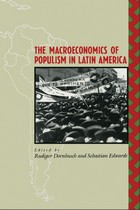 The Macroeconomics of Populism in Latin America
Edited by Rudiger Dornbusch and Sebastian Edwards
University of Chicago Press, 1991 Again and again, Latin America has seen the populist scenario played to an unfortunate end. Upon gaining power, populist governments attempt to revive the economy through massive spending. After an initial recovery, inflation reemerges and the government responds with wage an price controls. Shortages, overvaluation, burgeoning deficits, and capital flight soon precipitate economic crisis, with a subsequent collapse of the populist regime. The lessons of this experience are especially valuable for countries in Eastern Europe, as they face major political and economic decisions.
Economists and political scientists from the United States and Latin America detail in this volume how and why such programs go wrong and what leads policymakers to repeatedly adopt these policies despite a history of failure. Authors examine this pattern in Argentina, Brazil, Chile, Mexico, Nicaragua, and Peru—and show how Colombia managed to avoid it. Despite differences in how each country implemented its policies, the macroeconomic consequences were remarkably similar.
Scholars of Latin America will find this work a valuable resource, offering a distinctive macroeconomic perspective on the continuing controversy over the dynamics of populism.
MACROFUNGI ASSOCIATED WITH OAKS OF EASTERN NORTH AMERICA
DENISE E. "BINION
West Virginia University Press, 2008 Macrofungi Associated with Oaks of Eastern North America, which was written as a companion to Field Guide to Oak Species of Eastern North America, represents the first major publication devoted exclusively to the macrofungi that occur in association with oak trees in the forests of eastern North America. The macrofungi covered in this volume include many of the more common examples of the three groups—mycorrhizal fungi, decomposers, and pathogens—that are ecologically important to the forest ecosystems in which oaks occur. More than 200 species of macrofungi are described and illustrated via vibrantly colored photographs. Information is given on edibility, medicinal properties, and other novel uses as well. This publication reflects the combined expertise of six mycologists on the macrofungi anyone would be likely to encounter in an oak forest.
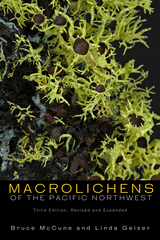 Macrolichens of the Pacific Northwest
Bruce McCune
Oregon State University Press, 2023 A key component in healthy ecosystems, lichens can be found in almost any natural habitat in the Pacific Northwest. This comprehensive guide to the region’s macrolichens is intended for use by beginners as well as specialists: weekend naturalists will be able to identify specimens and recognize the great diversity of lichens, while lichenologists and mycologists will gain greater knowledge of the distribution and abundance of various species. This revised and expanded edition of Macrolichens of the Pacific Northwest includes includes keys to over 600 species —all the macrolichens known or expected to occur in Oregon and Washington. The keys also provide coverage for lichens of Idaho and Montana, inland to the Continental Divide. Almost all macrolichens known from northern California and southern British Columbia, and from coastal southeast Alaska, are included as well. Color photographs and detailed descriptions are provided for more than 250 species, emphasizing lichens prevalent in forested ecosystems. The illustrated glossary and introductory material cover the terminology needed to identify macrolichens and provide information on collection and handling. The biology, ecology, and air-quality sensitivity of lichens are discussed. Macrolichens of the Pacific Northwest will prove invaluable to anyone seeking to identify lichens or to better understand these organisms and their vital role in the natural world.
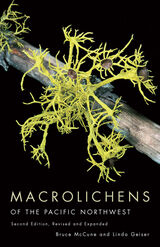 Macrolichens of the Pacific Northwest, Second Ed.
Bruce McCune
Oregon State University Press, 2009 A key component in healthy ecosystems, lichens can be found in almost any natural habitat in the Pacific Northwest. This comprehensive guide to the region’s macrolichens is intended for use by beginners as well as specialists: weekend naturalists will be able to identify specimens and recognize the great diversity of lichens, while lichenologists and mycologists will gain greater knowledge of the distribution and abundance of various species. This revised and expanded edition of Macrolichens of the Pacific Northwest includes 116 new species and 176 additional illustrations and incorporates an understanding of macrolichens that has advanced tremendously in the past decade. Macrolichens of the Pacific Northwest includes keys to 113 genera and 586 species of Oregon and Washington macrolichens—all the macrolichens known or expected to occur in the two states. The keys also provide reasonable coverage for lichens of Idaho and Montana, inland to the Continental Divide. Color photographs and detailed descriptions are provided for 246 species, emphasizing lichens prevalent in forested ecosystems. The illustrated glossary and introductory material cover the terminology needed to identify macrolichens and provide information on collection and handling. The biology, ecology, and air-quality sensitivity of lichens are discussed; regional air-quality sensitivities are provided for 184 species. Macrolichens of the Pacific Northwest will prove invaluable to anyone seeking to identify lichens or to better understand these organisms and their vital role in the natural world.
 Macropolitics of Nineteenth-Century Literature: Nationalism, Exoticism, Imperialism
Jonathan Arac and Harriet Ritvo, eds.
Duke University Press Increasingly in the last decade, macropolitics—a consideration of political transformations at the level of the state—has become a focus for cultural inquiry. From the macropolitical perspective afforded by contemporary postcolonial studies, the essays in this collection explore the relationship between politics and culture by examining developments in a wide range of nineteenth-century writing. The dozen essays gathered here span the entire era of colonization and discuss the British Isles, Europe, the United States, India, the Caribbean, and Africa. Addressing the works of Wordsworth, Shelley, Dickens, Melville, Flaubert, Conrad, and Charlotte Brontë, as well as explorers’ reports, Bible translations, popular theater, and folklore, the contributors consider such topics as the political function of aesthetic containment, the redefinitions of nationality under the pressure of imperial ambition, and the coexistence of imperial and revolutionary tendencies. New historical data and new interpretive perspectives alter our conception of established masterpieces and provoke new understandings of the political and cultural context within which these works emerged. This anthology demonstrates that the macropolitical concept of imperialism can provide a new understanding of nineteenth-century cultural production by integrating into a single process the well-established topics of nationalism and exoticism. First published in 1991 (University of Pennsylvania Press), Macropolitics of Nineteenth-Century Literature is now available in paperback. Offering agenda-setting essays in cultural and Victorian studies, it will be of interest to students and scholars of British and American literature, literary theory, and colonial and postcolonial studies. Contributors. Jonathan Arac, Chris Bongie, Wai-chee Dimock, Bruce Greenfield, Mark Kipperman, James F. Knapp, Loren Kruger, Lisa Lowe, Susan Meyer, Jeff Nunokawa, Harriet Ritvo, Marlon B. Ross, Nancy Vogeley, Sue Zemka
 The Mad Among Us: A History of the Care of America’s Mentally Ill
Gerald N. Grob
Harvard University Press In the first comprehensive one-volume history of the treatment of the mentally ill, the foremost historian in the field compellingly recounts our various attempts to solve this ever-present dilemma from colonial times to the present.
Gerald Grob charts the growth of mental hospitals in response to the escalating numbers of the severely and persistently mentally ill and the deterioration of these hospitals under the pressure of too many patients and too few resources. Mounting criticism of psychiatric techniques such as shock therapies, drugs, and lobotomies and of mental institutions as inhumane places led to a new emphasis on community care and treatment. While some patients benefited from the new community policies, they were ineffective for many mentally ill substance abusers. Grob's definitive history points the way to new solutions. It is at once an indispensable reference and a call for a humane and balanced policy in the future.
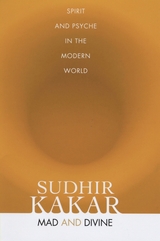 Mad and Divine: Spirit and Psyche in the Modern World
Sudhir Kakar
University of Chicago Press, 2009 Sudhir Kakar, India’s foremost practitioner of psychoanalysis, has focused his career on infusing this preeminently Western discipline with ideas and views from the East. In Mad and Divine, he takes on the separation of the spirit and the body favored by psychoanalysts, cautioning that a single-minded focus on the physical denies a person’s wholeness. Similarly, Kakar argues, to focus on the spirit alone is to hold in contempt the body that makes us human. Mad and Divine looks at the interplay between spirit and psyche and the moments of creativity and transformation that occur when the spirit overcomes desire and narcissism. Kakar examines this relationship in religious rituals and healing traditions— both Eastern and Western—as well as in the lives of some extraordinary men: the mystic and guru Rajneesh, Gandhi, and the Buddhist saint Drukpa Kunley. Enriched with a novelist’s felicity of language and an analyst’s piercing insights and startling interpretations, Mad and Divine is a valuable addition to the literature on the integration of the spirit and psyche in the evolving psychology of the individual.
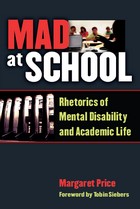 Mad at School: Rhetorics of Mental Disability and Academic Life
Margaret Price
University of Michigan Press, 2011 "A very important study that will appeal to a disability studies audience as well as scholars in social movements, social justice, critical pedagogy, literacy education, professional development for disability and learning specialists in access centers and student counseling centers, as well as the broader domains of sociology and education."
---Melanie Panitch, Ryerson University "Ableism is alive and well in higher education. We do not know how to abandon the myth of the 'pure (ivory) tower that props up and is propped up by ableist ideology.' . . . Mad at School is thoroughly researched and pathbreaking. . . . The author's presentation of her own experience with mental illness is woven throughout the text with candor and eloquence."
---Linda Ware, State University of New York at Geneseo Mad at School explores the contested boundaries between disability, illness, and mental illness in the setting of U.S. higher education. Much of the research and teaching within disability studies assumes a disabled body but a rational and energetic (an "agile") mind. In Mad at School, scholar and disabilities activist Margaret Price asks: How might our education practices change if we understood disability to incorporate the disabled mind? Mental disability (more often called "mental illness") is a topic of fast-growing interest in all spheres of American culture, including popular, governmental, aesthetic, and academic. Mad at School is a close study of the ways that mental disabilities impact academic culture. Investigating spaces including classrooms, faculty meeting rooms, and job searches, Price challenges her readers to reconsider long-held values of academic life, including productivity, participation, security, and independence. Ultimately, she argues that academic discourse both produces and is produced by a tacitly privileged "able mind," and that U.S. higher education would benefit from practices that create a more accessible academic world. Mad at School is the first book to use a disability-studies perspective to focus specifically on the ways that mental disabilities impact academic culture at institutions of higher education. Individual chapters examine the language used to denote mental disability; the role of "participation" and "presence" in student learning; the role of "collegiality" in faculty work; the controversy over "security" and free speech that has arisen in the wake of recent school shootings; and the marginalized status of independent scholars with mental disabilities. Margaret Price is Associate Professor of English at Spelman College.
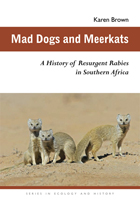 Mad Dogs and Meerkats: A History of Resurgent Rabies in Southern Africa
Karen Brown
Ohio University Press, 2011 Through the ages, rabies has exemplified the danger of diseases that transfer from wild animals to humans and their domestic stock. In South Africa, rabies has been on the rise since the latter part of the twentieth century despite the availability of postexposure vaccines and regular inoculation campaigns for dogs. In Mad Dogs and Meerkats: A History of Resurgent Rabies in Southern Africa, Karen Brown links the increase of rabies to the HIV/AIDS epidemic. Her study shows that the most afflicted regions of South Africa have seen a dangerous rise in feral dog populations as people lack the education, means, or will to care for their pets or take them to inoculation centers. Most victims are poor black children. Ineffective disease control, which in part depends on management policies in neighboring states and the diminished medical and veterinary infrastructures in Zimbabwe, has exacerbated the problem. This highly readable book is the first study of rabies in Africa, tracing its history in South Africa and neighboring states from 1800 to the present and showing how environmental and economic changes brought about by European colonialism and global trade have had long-term effects. Mad Dogs and Meerkats is recommended for public health policy makers and anyone interested in human-animal relations and how societies and governments have reacted to one of the world’s most feared diseases.
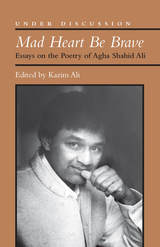 Mad Heart Be Brave: Essays on the Poetry of Agha Shahid Ali
Kazim Ali, Editor
University of Michigan Press, 2017 Born and raised in Kashmir, Agha Shahid Ali (1949–2001) came to the United States in the mid-1970s to pursue graduate study in literature; by the mid-1980s, he had begun to establish himself as one of the most important American poets of the late 20th century. Mad Heart Be Brave: On the Poetry of Agha Shahid Ali is the first comprehensive examination of all stages of his career, from his earliest work published in India but never reissued in the U.S., through his seven poetry volumes from American publishers, ultimately collected as The Veiled Suite. The essays, written by a range of poets and scholars, many of whom knew and studied with Ali, consider his early free verse poetry; his transition into writing more formalist poetry; his correspondence with poets Anthony Hecht and James Merrill; his literary engagement with the political realities of contemporary Kashmir; his teaching and mentorship of young poets; and Ali’s championing of the ghazal, a traditional Eastern poetic form, in English. Some essays have a predominantly scholarly focus, while others are more personal in their tone and content. All exhibit a deep appreciation for Ali’s life and work. Contributors to this volume include Sejal Shah, Rita Banerjee, Amanda Golden, Ravi Shankar, Abin Chakraborty, Amy Newman, Christopher Merrill, Jason Schneiderman, Stephen Burt, Raza Ali Hassan, Syed Humayoun, Feroz Rather, Dur e Aziz Amna, Mihaela Moscaliuc, Reginald Dwayne Betts, Mahwash Shoaib, Shadab Zeest Hashmi, Grace Schulman, and Ada Limón. Mad Heart Be Brave closes with a long biographical sketch and elegy by Agha Shahid Ali’s friend Amitav Ghosh and a comprehensive bibliography assembled by scholar Patricia O’Neill with Reid Larson.
Mad Like Artaud
Sylvère Lotringer
University of Minnesota Press, 2015 Those who are mad like Antonin Artaud, are they just as mad as he was? Madness, like the plague, is contagious, and everyone, from his psychiatrists to his disciples, family, and critics, everyone who gets close to Artaud, seems to participate in his delirium. Sylvère Lotringer explores various embodiments of this shared delirium through what Artaud called “mental dramas”—a series of confrontations with his witnesses or “persecutors” where we uncover the raw delirium at work, even in Lotringer himself. Mad Like Artaud does not intend to add one more layer of commentary to the bitter controversies that have been surrounding the cursed poet’s work since his death in 1948, nor does it take sides among the different camps who are still haggling over his corpse. This book speaks of the site where “madness” itself is simmering.
 Mad Men, Death and the American Dream
Elisabeth Bronfen
Diaphanes, 2016 Matthew Weiner’s Emmy-winning series Mad Men has earned wide critical acclaim in its seven seasons. What is it about these impeccably dressed men and women of midcentury Madison Avenue that fascinates us? Decades later, when Weiner’s iconic characters seem as much a thing of the past as the workday martini, why is it so easy for modern viewers to commiserate with the reserved but ambitious Peggy Olson, to jeer at Pete Campbell, and to cheer on Don Draper in his often indecorous struggles?
We are drawn to Mad Men’s dapper cast of characters, argues Elisabeth Bronfen, because, although the series has drawn praise for its depiction of the 1960s and ’70s, it speaks equally well to cultural concerns of the present. The prototypical con man, Don makes a precarious journey from poverty to fame and prosperity that maps the pursuit of moral perfectionism that features prominently throughout American cultural history. Yet a lingering sense of dissatisfaction hints that the lifestyle Don strives for may be a mere manifestation of the illusory American dream—cemented in the same collective desires Don draws on to advertise cigarettes and luxury cars by day.
"Mad Men," Death and the American Dream takes readers through the cultural fantasies that underlie characters’ motivations in this sophisticated and immensely popular television series, showing how—then as now—we turn to fantasy in the face of conflicts that cannot be resolved in political reality. Fascinating and full of accessible insights, the book will appeal to the show’s many fans, as well as anyone interested in American studies, media studies, or cultural history.
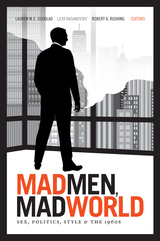 Mad Men, Mad World: Sex, Politics, Style, and the 1960s
Lauren M. E. Goodlad, Lilya Kaganovsky, and Robert A. Rushing, eds.
Duke University Press, 2013 Since the show's debut in 2007, Mad Men has invited viewers to immerse themselves in the lush period settings, ruthless Madison Avenue advertising culture, and arresting characters at the center of its 1960s fictional world. Mad Men, Mad World is a comprehensive analysis of this groundbreaking TV series. Scholars from across the humanities consider the AMC drama from a fascinating array of perspectives, including fashion, history, architecture, civil rights, feminism, consumerism, art, cinema, and the serial format, as well as through theoretical frames such as critical race theory, gender, queer theory, global studies, and psychoanalysis. In the introduction, the editors explore the show's popularity; its controversial representations of race, class, and gender; its powerful influence on aesthetics and style; and its unique use of period historicism and advertising as a way of speaking to our neoliberal moment. Mad Men, Mad World also includes an interview with Phil Abraham, an award-winning Mad Men director and cinematographer. Taken together, the essays demonstrate that understanding Mad Men means engaging the show not only as a reflection of the 1960s but also as a commentary on the present day.
Contributors. Michael Bérubé, Alexander Doty, Lauren M. E. Goodlad, Jim Hansen, Dianne Harris, Lynne Joyrich, Lilya Kaganovsky, Clarence Lang, Caroline Levine, Kent Ono, Dana Polan, Leslie Reagan, Mabel Rosenheck, Robert A. Rushing, Irene Small, Michael Szalay, Jeremy Varon
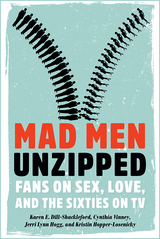 Mad Men Unzipped: Fans on Sex, Love, and the Sixties on TV
Karen L. Dill-Shackleford, Cynthia Vinney, Jeri Lynn Hogg, Kristin Hopper-Losenicky
University of Iowa Press, 2015 This is the story of the Mad Men fan phenomenon: how the show and its fans distinguished themselves in a market where it’s hard to make an impression, not unlike the driven ad execs at the center of the show. In this book, four media psychologists who also just happen to be dedicated Mad Men fans explore how the show’s viewers make meaning from fictional drama. The authors also interviewed several contemporary advertising industry professionals, getting their inside view of the business in its modern guise and what they make of the show’s vision of their past. The result is cutting-edge psychological research that crunches and codes online fan commentary to understand the ways that people use the show to debate complex social issues, from sex and alcohol to gender roles, parenting, and advertising itself. What do the 1960s mean to us today, and how well does the twenty-first century measure up against that famously turbulent decade? Which characters do fans identify with—and which ones do they love to hate? How would fans unfurl the Mad Men storylines if they were in charge? What makes a good man, and has it changed over time? How should husbands and wives treat each other, and how should parents treat their children?
In answering these questions, the authors explore not just the online commentary but also Mad Men fans’ fan fiction, cosplay, cocktail making, and vintage furniture collecting. Whether tweeting as one of the main characters (or just a lowly mail clerk), setting Peggy up with the man who’ll treat her right, or figuring out just which “Mad Man” they are at heart, fans integrate the show into their lives and use it to make sense of their own choices in work, leisure, and love.
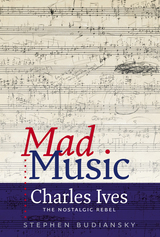 Mad Music: Charles Ives, the Nostalgic Rebel
Stephen Budiansky
University Press of New England, 2014 Mad Music is the story of Charles Edward Ives (1874–1954), the innovative American composer who achieved international recognition, but only after he’d stopped making music. While many of his best works received little attention in his lifetime, Ives is now appreciated as perhaps the most important American composer of the twentieth century and father of the diverse lines of Aaron Copland and John Cage. Ives was also a famously wealthy crank who made millions in the insurance business and tried hard to establish a reputation as a crusty New Englander. To Stephen Budiansky, Ives’s life story is a personification of America emerging as a world power: confident and successful, yet unsure of the role of art and culture in a modernizing nation. Though Ives steadfastly remained an outsider in many ways, his life and times inform us of subjects beyond music, including the mystic movement, progressive anticapitalism, and the initial hesitancy of turn-of-the-century-America modernist intellectuals. Deeply researched and elegantly written, this accessible biography tells a uniquely American story of a hidden genius, disparaged as a dilettante, who would shape the history of music in a profound way. Making use of newly published letters—and previously undiscovered archival sources bearing on the longstanding mystery of Ives’s health and creative decline—this absorbing volume provides a definitive look at the life and times of a true American original.
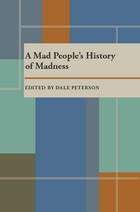 A Mad People’s History of Madness
Dale Peterson
University of Pittsburgh Press, 1981 A man desperately tries to keep his pact with the Devil, a woman is imprisoned in an insane asylum by her husband because of religious differences, and, on the testimony of a mere stranger, “a London citizen” is sentenced to a private madhouse. This anthology of writings by mad and allegedly mad people is a comprehensive overview of the history of mental illness for the past five hundred years-from the viewpoint of the patients themselves.
Dale Peterson has compiled twenty-seven selections dating from 1436 through 1976. He prefaces each excerpt with biographical information about the writer. Peterson's running commentary explains the national differences in mental health care and the historical changes that have take place in symptoms and treatment. He traces the development of the private madhouse system in England and the state-run asylum system in the United States. Included is the first comprehensive bibliography of writings by the mentally ill.
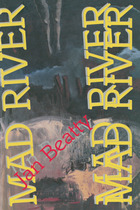 Mad River
Jan Beatty
University of Pittsburgh Press, 1996 "In every poem, she keeps her fury contained, but omnipresent, so that it resembles a cornered dog's warning growl, yet she hints of happier possibilities." --Booklist
"Beatty does offer deeply visceral and sensory work, especially in the second and third sections of this three-part book. . . . She risks relative boldness and deep emotional commitment, disregarding political correctness in respect for this less readily sanitized realm of experience." --Publishers Weekly
"Her poems speak to us head-on, with courage and a contemporaneous eloquence." --Yusef Komunyakaa
"Raw, energetic, gritty, risky, sexy, and real. . . . The power of these short narratives is often cumulative, building a vision of the world seen through the eyes of a wanderer, a woman, a waitress." --Dorianne Laux
Jan Beatty, winner of the 2000 Creative Achievement Award from the Pittsburgh Cultural Trust, has also won two fellowships from the Pennsylvania Council on the Arts. She has held jobs as a welfare caseworker, a rape counselor, and a nurse's aide. She has worked in maximum security prisons, hoagie huts, burger joints, jazz clubs, and diners. Her chapbook, Ravenous, won the 1995 State Street Press Chapbook Prize. Her latest collection, Boneshaker, was published in 2002 by the University of Pittsburgh Press.
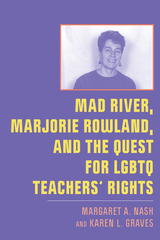 Mad River, Marjorie Rowland, and the Quest for LGBTQ Teachers’ Rights
Margaret A. Nash
Rutgers University Press, 2022 Mad River, Marjorie Rowland, and the Quest for LGBTQ Teachers’ Rights addresses an important legal case that set the stage for today’s LGBTQ civil rights–a case that almost no one has heard of. Marjorie Rowland v. Mad River School District involves an Ohio guidance counselor fired in 1974 for being bisexual. Rowland’s case made it to the U.S. Supreme Court, but the justices declined to consider it. In a spectacular published dissent, Justice Brennan laid out arguments for why the First and Fourteenth Amendments apply to bisexuals, gays, and lesbians. That dissent has been the foundation for LGBTQ civil rights advances since.
In the first in-depth treatment of this foundational legal case, authors Margaret A. Nash and Karen L. Graves tell the story of that case and of Marjorie Rowland, the pioneer who fought for employment rights for LGBTQ educators and who paid a heavy price for that fight. It brings the story of LGBTQ educators’ rights to the present, including commentary on Bostock v Clayton County, the 2020 Supreme Court case that struck down employment discrimination against LGBT workers.
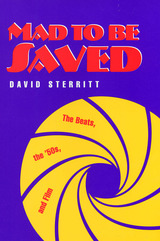 Mad to Be Saved: The Beats, the 50's, and Film
David Sterritt
Southern Illinois University Press, 1998 Film critic David Sterritt presents an interdisciplinary exploration of the Beat Generation, its intersections with main-stream and experimental film, and the interactions of all of these with American society and the culture of the 1950s. Sterritt balances the Beat countercultural goal of rebellion through both artistic creation and everyday behavior against the mainstream values of conformity and conservatism, growing worry over cold-war hostilities, and the "rat race" toward material success. After an introductory overview of the Beat Generation, its history, its antecedents, and its influences, Sterritt shows the importance of "visual thinking" in the lives and works of major Beat authors, most notably Jack Kerouac, Allen Ginsberg, and William S. Burroughs. He turns to Mikhail Bakhtin's dialogic theory to portray the Beat writers-who were inspired by jazz and other liberating influences-as carnivalesque rebels against what they perceived as a rigid and stifling social order. Showing the Beats as social critics, Sterritt looks at the work of 1950s photographers Robert Frank and William Klein; the attack against Beat culture in the pictures and prose of Life magazine; and the counterattack in Frank's film Pull My Daisy, featuring key Beat personalities. He further explores expressions of rebelliousness in film noir, the melodramas of director Douglas Sirk, and other Hollywood films. Finally, Sterritt shows the changing attitudes toward the Beat sensibility in Beat-related Hollywood movies like A Bucket of Blood and The Beat Generation; television programs like Route 66 and The Many Loves of Dobie Gillis; nonstudio films like John Cassavetes's improvisational Shadows and Shirley Clarke's experimental The Connection; and radically avant-garde works by such doggedly independent screen artists as Stan Brakhage, Ron Rice, Bruce Connor, and Ken Jacobs, drawing connections between their achievements and the most subversive products of their Beat contemporaries.
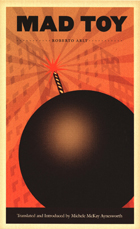 Mad Toy
Roberto Arlt
Duke University Press, 2002 Roberto Arlt, celebrated in Argentina for his tragicomic, punch-in-the-jaw writing during the 1920s and 1930s, was a forerunner of Latin American “boom” and “postboom” novelists such as Gabriel García Márquez and Isabel Allende. Mad Toy, acclaimed by many as Arlt’s best novel, is set against the chaotic background of Buenos Aires in the early twentieth century. Set in the badlands of adolescence, where acts of theft and betrayal become metaphors for creativity, Mad Toy is equal parts pulp fiction, realism, detective story, expressionist drama, and creative memoir.
An immigrant son of a German father and an Italian mother, Arlt as a youth was a school dropout, poor and often hungry. In Mad Toy, he incorporates his personal experience into the lives of his characters. Published in 1926 as El juguete rabioso, the novel follows the adventures of Silvio Astier, a poverty-stricken and frustrated youth who is drawn to gangs and a life of petty crime. As Silvio struggles to bridge the gap between exuberant imagination and the sordid reality around him, he becomes fascinated with weapons, explosives, vandalism, and thievery, despite a desperate desire to rise above his origins. Flavored with a dash of romance, a hint of allegory, and a healthy dose of irony, the novel’s language varies from the cultured idiom of the narrator to the dialects and street slang of the novel’s many colorful characters.
Mad Toy has appeared in numerous Spanish editions and has been adapted for the stage and for film. It is the second of Arlt’s novels to be translated into English.
Mad Travelers: Reflections on the Reality of Transient Mental Illnesses
Ian Hacking
Harvard University Press Ian Hacking tells the fascinating tale of Albert Dadas, a native of France’s Bordeaux region and the first diagnosed mad traveler. Dadas suffered from a strange compulsion that led him to travel obsessively, often without identification, not knowing who he was or why he traveled. Using the records of Philippe Tissié, Dadas’s physician, Hacking attempts to make sense of this strange epidemic.
In telling this tale, Hacking raises probing questions about the nature of mental disorders, the cultural repercussions of their diagnosis, and the relevance of this century-old case study for today’s overanalyzed society.
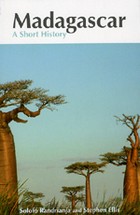 Madagascar: A Short History
Solofo Randrianja and Stephen Ellis
University of Chicago Press, 2009 Two thousand years ago, the island of Madagascar was likely uninhabited. Its unique flora and fauna had gone totally undisturbed by human contact until the first navigators landed on its shores. No one knows where those first inhabitants hailed from, but over the centuries Madagascar developed its own distinctive language and cultural systems. The only recent history of its kind in English, Madagascar, traces two millennia of human activity in one of the world’s most fascinating, yet least-known, societies. In graceful prose, Solofo Randrianja and Stephen Ellis, both leading historians of Madagascar, elucidate the three main phases of its history: the earliest settlements, the age of kingdoms, and the island’s entry into intercontinental systems of commerce and exchange, including over sixty years under French rule. Through the course of this colorful and turbulent history, Randrianja and Ellis explore the tensions between the development of a unique culture and the absorption of immigrants, the development of strong social hierarchies, and the long-lasting effects of slavery and the slave trade.
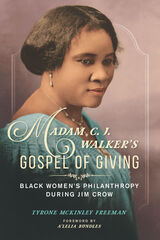 Madam C. J. Walker's Gospel of Giving: Black Women's Philanthropy during Jim Crow
Tyrone McKinley Freeman
University of Illinois Press, 2020 Winner of the - AFP/Skystone Partners Prize for Research on Fundraising and Philanthropy, Association of Fundraising Professionals, 2021
- Terry McAdam Book Award, given by the Alliance for Nonprofit Management
- 2023 Peter Dobkin Hall History of Philanthropy Prize from the Association for Research on Nonprofit and Voluntary Action (ARNOVA).
Founder of a beauty empire, Madam C. J. Walker was celebrated as America's first self-made female millionaire in the early 1900s. Known as a leading African American entrepreneur, Walker was also devoted to an activist philanthropy aimed at empowering African Americans and challenging the injustices inflicted by Jim Crow. Tyrone McKinley Freeman's biography highlights how giving shaped Walker's life before and after she became wealthy. Poor and widowed when she arrived in St. Louis in her twenties, Walker found mentorship among black churchgoers and working black women. Her adoption of faith, racial uplift, education, and self-help soon informed her dedication to assisting black women's entrepreneurship, financial independence, and activism. Walker embedded her philanthropy in how she grew her business, forged alliances with groups like the National Association of Colored Women, funded schools and social service agencies led by African American women, and enlisted her company's sales agents in local charity and advocacy work. Illuminating and dramatic, Madam C. J. Walker’s Gospel of Giving broadens our understanding of black women’s charitable giving and establishes Walker as a foremother of African American philanthropy.
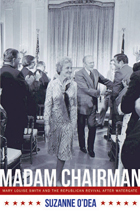 Madam Chairman: Mary Louise Smith and the Republican Revival after Watergate
Suzanne O'Dea
University of Missouri Press, 2012 For much of her career Mary Louise Smith stood alone as a woman in a world of politics run by men. After devoting over two decades of her life to politics, she eventually became the first, and only, woman chairman of the Republican National Committee. Suzanne O’Dea examines Smith’s rise and fall within the party and analyzes her strategies for gaining the support of Republican Party leaders. Smith’s leadership skills grew from the time she worked in rural precincts. During her twenty-eight months as chairman, Smith dealt with highs and lows as she blazed not only a trail of her own but also one for the Republican Party, including assembling the team that kept the party intact following the devastation of Watergate. She was present during the party’s shift from moderate leadership, as exemplified by Ford, to the increasingly conservative leadership still seen today. Smith was an advocate for the Equal Rights Amendment, a supporter of the pro-choice movement, and a proponent of gay rights. Though handpicked by President Ford, Smith still found herself struggling against the party and at times even against the president himself. At one point Smith lost months of fundraising opportunities as a result of a disagreement with the president. She and her staff developed innovative strategies, still used in the party today, to attract desperately needed dollars from major donors. Even so, people within the administration as well as unnamed party leaders regularly intimated that Smith’s days as chairman were numbered. Even after leaving the chairmanship, Smith remained loyal to the party from which she felt increasingly alienated. O’Dea uses extensive personal interviews with Smith and her staff at the RNC to recount not only Smith’s and the GOP’s changing fortunes but also the challenges Republican women faced as they worked to gain a larger party presence. These behind-the-scenes perspectives show the tactics and strategies of the Republican Party’s power struggles along with Smith’s own opinions about leadership style. With relevance to today’s political strategies and conservative shift, O’Dea highlights Mary Louise Smith’s mark on Republican history.
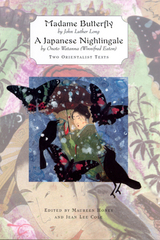 'Madame Butterfly' and 'A Japanese Nightingale': Two Orientalist Texts
Cole, Jean Lee
Rutgers University Press, 2002 Madame Butterfly (1898) and A Japanese Nightingale (1901) both appeared at the height of American fascination with Japanese culture. These two novellas are paired here together for the first time to show how they defined and redefined contemporary misconceptions of the "Orient." This is the first reprinting of A Japanese Nightingale since its 1901 appearance, when it propelled Winnifred Eaton (using the pseudonym Onoto Watanna) to fame. John Luther Long's Madame Butterfly introduced American readers to the figure of the tragic geisha who falls in love with, and is then rejected by, a dashing American man; the opera Puccini based upon this work continues to enthrall audiences worldwide. Although Long emphasized the insensitivity of Westerners in their dealings with Asian people, the ever-faithful Cho-Cho-San typified Asian subservience and Western dominance. A Japanese Nightingale takes Long's revision several steps further. Eaton's heroine is powerful in her own right and is loved on her own terms. A Japanese Nightingale is also significant for its hidden personal nature. Although Eaton's pen name implied she was Japanese, she was, in fact, of Chinese descent. Living in a society that was virulently anti-Chinese, she used a Japanese screen for her own problematic identity, and A Japanese Nightingale tells us as much about the author's struggle to embrace her Asian heritage as it does about the stereotypes she contests.
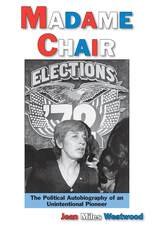 Madame Chair: A Political Autobiography of an Unintentional Pioneer
Jean Miles Westwood
Utah State University Press, 2007 Jean Westwood called herself an unintentional pioneer. Although she worked hard to achieve what she did, she did not actively seek or expect to reach what was arguably the most powerful political position any American woman had ever held, chair of the national Democratic Party.
A Utah national committeewoman and member of the reform committee that reorganized the party, Westwood answered George McGovern’s call to lead his presidential campaign. In the dramatic year of 1972, she became “chairman” of the party, McGovern lost in a landslide, Nixon was reelected, and a covert operation burglarized Democratic National Committee headquarters at the Watergate.
Westwood provides an inside account of a period that reshaped national politics. Second-wave feminism—“women’s liberation”—and the civil rights and antiwar movements opened the way. As a major player in political reform, Jean Westwood both helped build that road and traveled it.
Madame De Staël and the United States
Richmond Laurin Hawkins
Harvard University Press Madame de Stael’s relations with the United States lasted from 1789 to 1817. During that period the author of Corinne carried on a correspondence with a number of Americans; she invested hundreds of thousands of francs in American bonds and banks; and she purchased large tracts of land in New York State. From 1804 to 1812 she thought seriously of emigrating to this country. Naturally, therefore, we have a considerable mass of correspondence, to and from her, written by such men as Gouverneur Morris, Simonde de Sismondi, Judge William Cooper, Thomas Jefferson, and Albert Gallatin; on these letters, mostly unpublished, the present monograph is based.
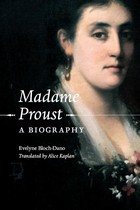 Madame Proust: A Biography
Evelyne E. Bloch-Dano
University of Chicago Press, 2007 Marcel Proust’s In Search of Lost Time opens with one of the most famous scenes in literature, as young Marcel, unable to fall asleep, waits anxiously for his mother to come to his bedroom and kiss him good night. Proust's own mother is central to the meaning of his masterpiece, and she has always held a special role in literary history, both as a character and as a decisive influence on the great writer’s career. Without knowing much about her, we think of her as the quintessential writer's mother.
Now Evelyne Bloch-Dano’s touching biography acquaints Proust fans with the real Jeanne Weil Proust. Written with the imaginative force of a novel, but firmly grounded in Jeanne and Marcel Proust’s writings, Madame Proust skillfully captures the life and times of Proust’s mother, from her German-Jewish background and her marriage to a Catholic grocer’s son to her lifelong worries about her son’s sexuality, health problems, and talent. As well as offering intimate glimpses of the Prousts’ daily life, Madame Proust also uses the family as a way to explore the larger culture of fin-de-siècle France, including high society, spa culture, Jewish assimilation, and the Dreyfus affair. Throughout, Bloch-Dano offers sensitive readings of Proust’s work, drawing out the countless interconnections between his mother, his life, and his magnum opus.
Those coming to In Search of Lost Time for the first time will find in Madame Proust a delightful primer on Marcel Proust’s life and times. For those already steeped in the pleasures of Proust, this gem of a biography will give them a fresh understanding of the rich, fascinating background of the writer and his art.
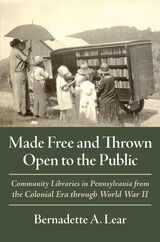 Made Free and Thrown Open to the Public: Community Libraries in Pennsylvania from the Colonial Era through World War II
Bernadette Lear
University of Pittsburgh Press, 2021 Made Free and Thrown Open to the Public charts the history of public libraries and librarianship in Pennsylvania. Based on archival research at more than fifty libraries and historical societies, it describes a long progression from private, subscription-based associations to publicly funded institutions, highlighting the dramatic period during the late nineteenth and early twentieth centuries when libraries were “thrown open” to women, children, and the poor. Made Free explains how Pennsylvania’s physical and cultural geography, legal codes, and other unique features influenced the spread and development of libraries across the state. It also highlights Pennsylvania libraries’ many contributions to the social fabric, especially during World War I, the Great Depression, and World War II. Most importantly of all, Made Free convincingly argues that Pennsylvania libraries have made their greatest strides when community activists and librarians, supported with state and local resources, have worked collaboratively.
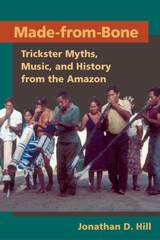 Made from Bone: Trickster Myths, Music, and History from the Amazon
Jonathan D. Hill
University of Illinois Press, 2008 Made-from-Bone is the first work to provide a complete set of English translations of narratives about the mythic past and its transformations from the indigenous Arawak-speaking people of South America. Among the Arawak-speaking Wakuénai of southernmost Venezuela, storytellers refer to these narratives as "words from the primordial times," and they are set in an unfinished space-time before there were any clear distinctions between humans and animals, men and women, day and night, old and young, and powerful and powerless. The central character throughout these primordial times and the ensuing developments that open up the world of distinct peoples, species, and places is a trickster-creator, Made-from-Bone, who survives a prolonged series of life-threatening attacks and ultimately defeats all his adversaries. Carefully recorded and transcribed by Jonathan D. Hill, these narratives offer scholars of South America and other areas the only ethnographically generated cosmogony of contemporary or ancient native peoples of South America. Hill includes translations of key mythic narratives along with interpretive and ethnographic discussion that expands on the myths surrounding this fascinating and enigmatic character with broad appeal throughout various folkloric traditions.
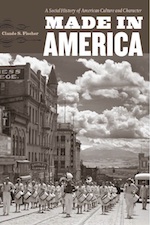 Made in America: A Social History of American Culture and Character
Claude S. Fischer
University of Chicago Press, 2010 Our nation began with the simple phrase, “We the People.” But who were and are “We”? Who were we in 1776, in 1865, or 1968, and is there any continuity in character between the we of those years and the nearly 300 million people living in the radically different America of today? With Made in America, Claude S. Fischer draws on decades of historical, psychological, and social research to answer that question by tracking the evolution of American character and culture over three centuries. He explodes myths—such as that contemporary Americans are more mobile and less religious than their ancestors, or that they are more focused on money and consumption—and reveals instead how greater security and wealth have only reinforced the independence, egalitarianism, and commitment to community that characterized our people from the earliest years. Skillfully drawing on personal stories of representative Americans, Fischer shows that affluence and social progress have allowed more people to participate fully in cultural and political life, thus broadening the category of “American” —yet at the same time what it means to be an American has retained surprising continuity with much earlier notions of American character. Firmly in the vein of such classics as The Lonely Crowd and Habits of the Heart—yet challenging many of their conclusions—Made in America takes readers beyond the simplicity of headlines and the actions of elites to show us the lives, aspirations, and emotions of ordinary Americans, from the settling of the colonies to the settling of the suburbs.
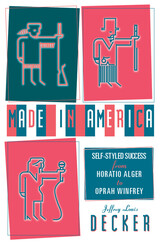 Made In America: Self-Styled Success from Horatio Alger to Oprah Winfrey
Jeffrey Louis Decker
University of Minnesota Press, 1997 The first look at self-made men and women from a multicultural perspective. Brings gender, race, and ethnicity to bear on the myth of the “self-made man.” Made in America presents the first look at self-made men and women from a multicultural perspective. Jeffrey Louis Decker discusses the emergence of self-starters like Andrew Carnegie, Booker T. Washington, Madam C. J. Walker, Younghill Kang, and Lee Iacocca in relation to the changing consumer markets of the twentieth century.Decker locates the new breed of entrepreneurs within the changing rhetoric of personal success, which shifted its emphasis over the past century from religious “character” to psychological “personality” to celebrity “image.” The book concludes by surveying the life stories of enterprising celebrities such as Oprah Winfrey and Arnold Schwarzenegger.Decker analyzes the autobiographical expressions of famous entrepreneurs, from Carnegie to Ross Perot, alongside more marginal ones in order to examine how mainstream society shapes and is shaped by the cultures of subordinate groups. In addition, he looks at the link between self-making and nation-building, and in doing so discovers the origins of another pervasive myth: the “American dream.”Underlying Decker’s study are these questions: What happened to the myth of self-making in America? If it is dead, what caused its demise? If it lives on, what form has it taken? Written in a lucid and engaging style, Made in America uncovers the richness, complexity, and diversity of self-styled success in our time. By bringing gender, race, and ethnicity to bear on the myth of the “self-made man,” this book provides a timely and fascinating reexamination of a traditional area of inquiry in American cultural studies.200 pages Translation rights: University of Minnesota Press
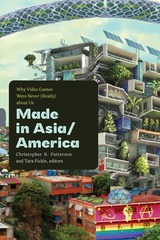 Made in Asia/America: Why Video Games Were Never (Really) about Us
Christopher B. Patterson and Tara Fickle, editors
Duke University Press, 2024 Made in Asia/America explores the key role video games play within the race makings of Asia/America. Its fourteen critical essays on games, ranging from Death Stranding to Animal Crossing, and five roundtables with twenty Asian/American game makers examine the historical entanglements of games, Asia, and America, and reveal the ways games offer new modes of imagining imperial violence, racial difference, and coalition. Shifting away from Eurocentric, white, masculinist takes on gaming, the contributors focus on minority and queer experiences, practices, and innovative scholarly methods to better account for the imperial circulation of games. Encouraging ambiguous and contextual ways of understanding games, the editors offer an “interactive” editorial method, a genre-expanding approach that encourages hybrid works of autotheory, queer of color theory, and conversation among game makers and scholars to generate divergent meanings of games, play, and “Asian America.”
Contributors. Matthew Seiji Burns, Edmond Y. Chang, Naomi Clark, Miyoko Conley, Toby Đỗ, Anthony Dominguez, Tara Fickle, Sarah Christina Ganzon, Yuxin Gao, Domini Gee, Melos Han-Tani, Huan He, Matthew Jungsuk Howard, Rachael Hutchinson, Paraluman (Luna) Javier, Sisi Jiang, Marina Ayano Kittaka, Minh Le, Haneul Lee, Rachel Li, Christian Kealoha Miller, Patrick Miller, Keita C. Moore, Souvik Mukherjee, Christopher B. Patterson, Pamela (Pam) Punzalan, Takeo Rivera, Yasheng She, D. Squinkifer, Lien B. Tran, Prabhash Ranjan Tripathy, Emperatriz Ung, Gerald Voorhees, Yizhou (Joe) Xu, Robert Yang, Mike Ren Yi
 Made in Chicago: Stories Behind 30 Great Hometown Bites
Monica Eng and David Hammond
University of Illinois Press, 2023 A BookRiot Most Anticipated Travel Book of 2023 Italian beef and hot dogs get the headlines. Cutting-edge cuisine and big-name chefs get the Michelin stars. But Chicago food shows its true depth in classic dishes conceived in the kitchens of immigrant innovators, neighborhood entrepreneurs, and mom-and-pop visionaries. Monica Eng and David Hammond draw on decades of exploring the city’s food landscape to serve up thirty can’t-miss eats found in all corners of Chicago. From Mild Sauce to the Jibarito and from Taffy Grapes to Steak and Lemonade, Eng and Hammond present stories of the people and places behind each dish while illuminating how these local favorites reflect the multifaceted history of the city and the people who live there. Each entry provides all the information you need to track down whatever sounds good and selected recipes even let you prepare your own Flaming Saganaki or Akutagawa. Generously illustrated with full-color photos, Made in Chicago provides locals and visitors alike with loving profiles of a great food city’s defining dishes.
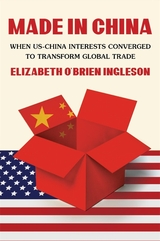 Made in China: When US-China Interests Converged to Transform Global Trade
Elizabeth O’Brien Ingleson
Harvard University Press, 2024 The surprising story of how Cold War foes found common cause in transforming China’s economy into a source of cheap labor, creating the economic interdependence that characterizes our world today.
For centuries, the vastness of the Chinese market tempted foreign companies in search of customers. But in the 1970s, when the United States and China ended two decades of Cold War isolation, China’s trade relations veered in a very different direction. Elizabeth Ingleson shows how the interests of US business and the Chinese state aligned to reframe the China market: the old dream of plentiful customers gave way to a new vision of low-cost workers by the hundreds of millions. In the process, the world’s largest communist state became an indispensable component of global capitalism.
Drawing on Chinese- and English-language sources, including previously unexplored corporate papers, Ingleson traces this transformation to the actions of Chinese policymakers, US diplomats, maverick entrepreneurs, Chinese American traders, and executives from major US corporations including Boeing, Westinghouse, J. C. Penney, and Chase Manhattan Bank. Long before Walmart and Apple came to China, businesspeople such as Veronica Yhap, Han Fanyu, Suzanne Reynolds, and David Rockefeller instigated a trade revolution with lasting consequences. And while China’s economic reorganization was essential to these connections, Ingleson also highlights an underappreciated but crucial element of the convergence: the US corporate push for deindustrialization and its embrace by politicians.
Reexamining two of the most significant transformations of the 1970s—US-China rapprochement and deindustrialization in the United States—Made in China takes bilateral trade back to its faltering, uncertain beginnings, identifying the tectonic shifts in diplomacy, labor, business, and politics in both countries that laid the foundations of today’s globalized economy.
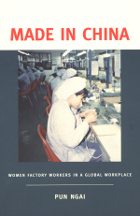 Made in China: Women Factory Workers in a Global Workplace
Pun Ngai
Duke University Press, 2005 As China has evolved into an industrial powerhouse over the past two decades, a new class of workers has developed: the dagongmei, or working girls. The dagongmei are women in their late teens and early twenties who move from rural areas to urban centers to work in factories. Because of state laws dictating that those born in the countryside cannot permanently leave their villages, and familial pressure for young women to marry by their late twenties, the dagongmei are transient labor. They undertake physically exhausting work in urban factories for an average of four or five years before returning home. The young women are not coerced to work in the factories; they know about the twelve-hour shifts and the hardships of industrial labor. Yet they are still eager to leave home. Made in China is a compelling look at the lives of these women, workers caught between the competing demands of global capitalism, the socialist state, and the patriarchal family. Pun Ngai conducted ethnographic work at an electronics factory in southern China’s Guangdong province, in the Shenzhen special economic zone where foreign-owned factories are proliferating. For eight months she slept in the employee dormitories and worked on the shop floor alongside the women whose lives she chronicles. Pun illuminates the workers’ perspectives and experiences, describing the lure of consumer desire and especially the minutiae of factory life. She looks at acts of resistance and transgression in the workplace, positing that the chronic pains—such as backaches and headaches—that many of the women experience are as indicative of resistance to oppressive working conditions as they are of defeat. Pun suggests that a silent social revolution is underway in China and that these young migrant workers are its agents.
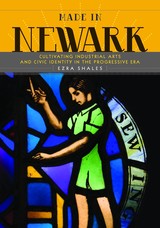 Made in Newark: Cultivating Industrial Arts and Civic Identity in the Progressive Era
Shales, Ezra
Rutgers University Press, 2010 What does it mean to turn the public library or museum into a civic forum? Made in Newark describes a turbulent industrial city at the dawn of the twentieth century and the ways it inspired the library's outspoken director, John Cotton Dana, to collaborate with industrialists, social workers, educators, and New Women.
This is the story of experimental exhibitions in the library and the founding of the Newark Museum Associationùa project in which cultural literacy was intertwined with civics and consumption. Local artisans demonstrated crafts, connecting the cultural institution to the department store, school, and factory, all of which invoked the ideal of municipal patriotism. Today, as cultural institutions reappraise their relevance, Made in Newark explores precedents for contemporary debates over the ways the library and museum engage communities, define heritage in a multicultural era, and add value to the economy.
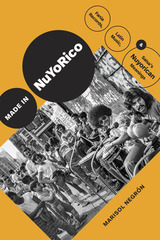 Made in NuYoRico: Fania Records, Latin Music, and Salsa’s Nuyorican Meanings
Marisol Negrón
Duke University Press, 2024 In Made in NuYoRico, Marisol Negrón tells the cultural history of salsa, tracing the music’s Nuyorican meanings over a fifty-year period that begins with the establishment of Fania Records in 1964 and how it capitalized on salsa’s Nuyorican imaginary to cultivate a global audience. Drawing on interviews with fans, legendary musicians, and music industry figures as well as analyses of songs, albums, films, and archival documents, Negrón shows how Nuyorican cultural and social histories became embedded in and impacted salsa music's flows during its foundational period in the mid-1960s and its boom in the 1970s. Salsa’s Nuyorican aesthetics challenged mainstream notions of Americanness and Puerto Ricanness and produced an alternative public sphere through which New York’s poor and working-class Puerto Ricans could contest racialization and colonial power. By outlining salsa’s complicated musical, cultural, commercial, racial, gendered, legal, and political entanglements, Negrón demonstrates its centrality to Nuyorican identity and subjectivity.
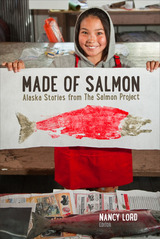 Made of Salmon: Alaska Stories from the Salmon Project
Edited by Nancy Lord
University of Alaska Press, 2016 All over the world, salmon populations are in trouble, as overfishing and habitat loss have combined to put the once-great Atlantic and Pacific Northwest runs at serious risk. Alaska, however, stands out as a rare success story: its salmon populations remain strong and healthy, the result of years of careful management and conservation programs that are rooted in a shared understanding of the importance of the fish to the life, culture, and history of the state.
Made of Salmon brings together more than fifty diverse Alaska voices to celebrate the salmon and its place in Alaska life. A mix of words and images, the book interweaves longer works by some of Alaska’s finest writers with shorter, more anecdotal accounts and stunning photographs of Alaskans fishing for, catching, preserving, and eating salmon throughout the state. A love letter to a fish that has been central to Alaska life for centuries, Made of Salmon is a reminder of the stakes of this great, ongoing conservation battle.
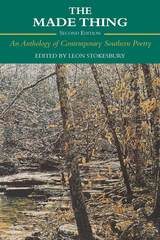 The Made Thing: An Anthology of Contemporary Southern Poetry
Leon Stokesbury
University of Arkansas Press, 2000 The second edition features twelve new poets as well as new work by Donald Justice, T. R. Hummer, Dave Smith, Pattiann Rogers, Andrew Hudgins, Henry Taylor, Gerald Barrax, Rodney Jones, and others. Among the new additions are Mark Jarman, Cathy Smith Bowers, and Charlie Smith. Many teachers realize that the best way to get their students to relate to poetry is to show them poems that contain landscapes and subjects they understand and can identify with. Leon Stokesbury has put together a richly varied collection used in classrooms not only in the South but all over the country as a means of studying the important influence of southern poetry on American literature. With the publication of the second edition of The Made Thing, Stokesbury has marked the end of the twentieth century and the rise to prominence of southern writers. This collection serves as a substantial sampling of poets whose works span more than five decades and who explore the rich personal and cultural history that extends beyond the boundaries of the South.
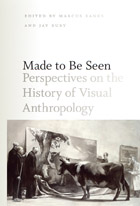 Made to Be Seen: Perspectives on the History of Visual Anthropology
Edited by Marcus Banks and Jay Ruby
University of Chicago Press, 2011 Made to be Seen brings together leading scholars of visual anthropology to examine the historical development of this multifaceted and growing field. Expanding the definition of visual anthropology beyond more limited notions, the contributors to Made to be Seen reflect on the role of the visual in all areas of life. Different essays critically examine a range of topics: art, dress and body adornment, photography, the built environment, digital forms of visual anthropology, indigenous media, the body as a cultural phenomenon, the relationship between experimental and ethnographic film, and more.
The first attempt to present a comprehensive overview of the many aspects of an anthropological approach to the study of visual and pictorial culture, Made to be Seen will be the standard reference on the subject for years to come. Students and scholars in anthropology, sociology, visual studies, and cultural studies will greatly benefit from this pioneering look at the way the visual is inextricably threaded through most, if not all, areas of human activity.
 Made to Break: Technology and Obsolescence in America
Giles Slade
Harvard University Press, 2007 Listen to a short interview with Giles SladeHost: Chris Gondek | Producer: Heron & Crane
If you've replaced a computer lately--or a cell phone, a camera, a television--chances are, the old one still worked. And chances are even greater that the latest model won't last as long as the one it replaced. Welcome to the world of planned obsolescence--a business model, a way of life, and a uniquely American invention that this eye-opening book explores from its beginnings to its perilous implications for the very near future.
Made to Break is a history of twentieth-century technology as seen through the prism of obsolescence. America invented everything that is now disposable, Giles Slade tells us, and he explains how disposability was in fact a necessary condition for America's rejection of tradition and our acceptance of change and impermanence. His book shows us the ideas behind obsolescence at work in such American milestones as the inventions of branding, packaging, and advertising; the contest for market dominance between GM and Ford; the struggle for a national communications network, the development of electronic technologies--and with it the avalanche of electronic consumer waste that will overwhelm America's landfills and poison its water within the coming decade.
History reserves a privileged place for those societies that built things to last--forever, if possible. What place will it hold for a society addicted to consumption--a whole culture made to break? This book gives us a detailed and harrowing picture of how, by choosing to support ever-shorter product lives we may well be shortening the future of our way of life as well.
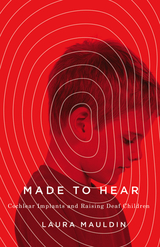 Made to Hear: Cochlear Implants and Raising Deaf Children
Laura Mauldin
University of Minnesota Press, 2016 A mother whose child has had a cochlear implant tells Laura Mauldin why enrollment in the sign language program at her daughter’s school is plummeting: “The majority of parents want their kids to talk.” Some parents, however, feel very differently, because “curing” deafness with cochlear implants is uncertain, difficult, and freighted with judgment about what is normal, acceptable, and right. Made to Hear sensitively and thoroughly considers the structure and culture of the systems we have built to make deaf children hear. Based on accounts of and interviews with families who adopt the cochlear implant for their deaf children, this book describes the experiences of mothers as they navigate the health care system, their interactions with the professionals who work with them, and the influence of neuroscience on the process. Though Mauldin explains the politics surrounding the issue, her focus is not on the controversy of whether to have a cochlear implant but on the long-term, multiyear undertaking of implantation. Her study provides a nuanced view of a social context in which science, technology, and medicine are trusted to vanquish disability—and in which mothers are expected to use these tools. Made to Hear reveals that implantation has the central goal of controlling the development of the deaf child’s brain by boosting synapses for spoken language and inhibiting those for sign language, placing the politics of neuroscience front and center. Examining the consequences of cochlear implant technology for professionals and parents of deaf children, Made to Hear shows how certain neuroscientific claims about neuroplasticity, deafness, and language are deployed to encourage compliance with medical technology.
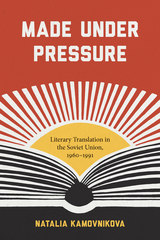 Made Under Pressure: Literary Translation in the Soviet Union, 1960-1991
Natalia Kamovnikova
University of Massachusetts Press, 2019 During the Cold War, determined translators and publishers based in the Soviet Union worked together to increase the number of foreign literary texts available in Russian, despite fluctuating government restrictions. Based on extensive interviews with literary translators, Made Under Pressure offers an insider's look at Soviet censorship and the role translators played in promoting foreign authors—including figures like John Fowles, George Orwell, Kurt Vonnegut, Gabriel García Márquez, and William Faulkner.
Natalia Kamovnikova chronicles the literary translation process from the selection of foreign literary works to their translation, censorship, final approval, and publication. Interviews with Soviet translators of this era provide insight into how the creative work of translating and the practical work of publishing were undertaken within a politically restricted environment, and recall the bonds of community and collaboration that they developed.
 Made with Words
May Swenson
University of Michigan Press, 1998 Made With Words collects prose by May Swenson (1919-89), whom critic and poet John Hollander has called "one of our few unquestionably major poets." Born in Logan, Utah, she spent most of her adult life living and writing in New York City. She was an editor for New Directions Paperbacks, and a writer-in-residence at numerous universities during the 1960s and 1970s. Throughout her long and illustrious career, Swenson produced nine volumes of verse, including New and Selected Things Taking Place and In Other Words: New Poems. She was a member of the American Academy and Institute of Arts and Letters and a chancellor of the Academy of American Poets, and received a multitude of grants and awards during her lifetime.
Made with Words includes a rich assortment of Swenson's prose, including several short stories, by turns amusing, provocative, and poetic, and inextricably bound with her poetic oeuvre; a one-act play entitled The Floor, produced in New York in the mid-sixties; interviews and book reviews that shed light on Swenson's poetic development as well as her literary and artistic tastes; and finally, a collection of Swenson's letters to the poet Elizabeth Bishop that reveal the intricacies of three decades of their personal and professional relationship. The critical and biographical introduction provides an engaging glimpse into the creative life and prose work of an important contemporary American poet.
Gardner McFall is Assistant Professor of Literature, Cooper Union for the Advancement of Science and Art. She is the author of The Pilot's Daughter; Naming the Animals; and Jonathan's Cloud.
Madeline Island & the Chequamegon Region
John O. Holzhueter
Wisconsin Historical Society Press, 1974 An updated reprint of the definitive history of a storied corner of the Upper Great Lakes—Madeline Island and the Chequamegon region on Wisconsin’s Lake Superior. A new foreword by Steve Cotherman, director of the Madeline Island Museum, brings the text of this book up to date on the history of Madeline Island and the Chequamegon region from the days before the missions to present-day tourism. Madeline Island played a significant role in the early history of Wisconsin and was an important outpost in the fur trade. Ojibwe from Wisconsin and surrounding areas view the island as a sacred place. Other Indian Nations, such as the Huron and Ottawa, also trace their history to Madeline Island. Today, Madeline Island and nearby Bayfield are popular tourist destinations, drawing tens of thousands of visitors every summer and throughout the winter.
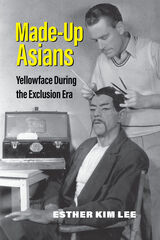 Made-Up Asians: Yellowface During the Exclusion Era
Esther Kim Lee
University of Michigan Press, 2022 Made-Up Asians traces the history of yellowface, the theatrical convention of non-Asian actors putting on makeup and costume to look East Asian. Using specific case studies from European and U.S. theater, race science, and early film, Esther Kim Lee traces the development of yellowface in the U.S. context during the Exclusion Era (1862–1940), when Asians faced legal and cultural exclusion from immigration and citizenship. These caricatured, distorted, and misrepresented versions of Asians took the place of excluded Asians on theatrical stages and cinema screens. The book examines a wide-ranging set of primary sources, including makeup guidebooks, play catalogs, advertisements, biographies, and backstage anecdotes, providing new ways of understanding and categorizing yellowface as theatrical practice and historical subject. Made-Up Asians also shows how lingering effects of Asian exclusionary laws can still be seen in yellowface performances, casting practices, and anti-Asian violence into the 21st century.
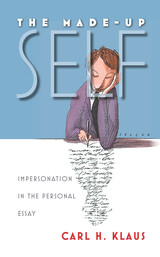 The Made-Up Self: Impersonation in the Personal Essay
Carl H. Klaus
University of Iowa Press, 2010 The human presence that animates the personal essay is surely one of the most beguiling of literary phenomena, for it comes across in so familiar a voice that it’s easy to believe we are listening to the author rather than a textual stand-in. But the “person” in a personal essay is always a written construct, a fabricated character, its confessions and reminiscences as rehearsed as those of any novelist. In this first book-length study of the personal essay, Carl Klaus unpacks this made-up self and the manifold ways in which a wide range of essayists and essays have brought it to life. By reconceiving the most fundamental aspect of the personal essay—the I of the essayist—Klaus demonstrates that this seemingly uncontrived form of writing is inherently problematic, not willfully devious but bordering upon the world of fiction. He develops this key idea by explaining how structure, style, and voice determine the nature of a persona and our perception of it in the works of such essayists as Michel de Montaigne, Charles Lamb, E. B. White, and Virginia Woolf. Realizing that this persona is shaped by the force of culture and the impress of personal experience, he explores the effects of both upon the point of view, content, and voice of such essayists as George Orwell, Nancy Mairs, Richard Rodriguez, and Alice Walker. Throughout, in full command of the history of the essay, he calls up numerous passages in which essayists themselves acknowledge the element of impersonation in their work, drawing upon the perspectives of Joan Didion, Edward Hoagland, Joyce Carol Oates, Leslie Marmon Silko, Scott Russell Sanders, Annie Dillard, Vivian Gornick, Loren Eiseley, James Baldwin, and a host of other literary guides. Finally, adding yet another layer to the made-up self, Klaus succumbs to his addiction to the personal essay by placing some of the different selves that various essayists have called forth in him within the essays that he has crafted so carefully for this book. Making his way from one essay to the next with a persona variously learned, whimsical, and poignant, he enacts the palimpsest of ways in which the made-up self comes to life in the work of a single essayist. Thus over the course of this highly original, beautifully structured study, the personal essay is revealed to be more complex than many readers have supposed. With its lively analyses and illuminating examples, The Made-Up Self will speak to anyone who wishes to understand—or to write—personal essays.
Madge's Mobile Home Park: Volume One of the Peavine Chronicles
Jane F. Hankins
Parkhurst Brothers, Inc., 2012 This hilarious send-up of outlandish Southern characters includes a beautician, a luncheonette waitress, a radio evangelist, the widow of a gas and oil distributror and the residents of a fictional mobile home park in Arkansas as they find uproarious ways to enjoy life, needle each other, and remember the dear-departed.
Madison
Zane Williams
Wisconsin Historical Society Press, 2008 This spectacular collection of photographs takes the viewer on a stroll through the heart of Madison, around the Capitol Square and down renowned State Street, with stops at some of the most recent additions to the city’s skyline, including the Monona Terrace Convention Center (original design by Frank Lloyd Wright) and the Overture Center for the Arts. Then it’s on toward the University of Wisconsin campus, with its historic buildings, walkways, and the Memorial Union Terrace, one of the city’s best-known spots for students and locals to meet, eat and listen to live music. The tour continues through Madison’s diverse neighborhoods, visiting numerous ethnic restaurants, music festivals and the one Madison’s most famous traditions, the Dane County Farmers’ Market. The visual journey finishes with visits to the breathtaking parks and gardens scattered throughout the city.
Madison
Brent Nicastro
University of Wisconsin Press, 2011 Brent Nicastro showcases the dynamic power, energy, and sheer beauty of Madison in this book of photography. Since the 1970s, Nicastro has been photographing the splendor of Madison, and his feel for his home is never more evident than in these images of the Dane County Farmers’ Market, the State Capitol building, the University of Wisconsin campus in all seasons, football at Camp Randall Stadium and basketball at the Kohl Center, the Monona Terrace Convention and Community Center designed by Frank Lloyd Wright, the Memorial Union Terrace, Picnic Point, and many more landmarks that evoke Madison’s charm.
Accompanying each image are captions in four languages—English, German, Spanish, and Chinese—making this book a perfect gift volume for all who love Madison. Visitors, students, and lifelong residents will savor this photographic portrait of beautiful Madison, Wisconsin.
 Madison Chefs: Stories of Food, Farms, and People
Lindsay Christians and Chris Hynes
University of Wisconsin Press, 2021 Why do Salvatore’s tomato pies have the sauce on the top? Where did chef Tami Lax learn to identify mushrooms in the woods? How did Morris develop its signature ramen?
Farm-to-table is a cliché, but its roots among the farmers and chefs of south-central Wisconsin are deep, vibrant, and resilient. From brats and burgers to bibimbap, Madison’s food scene looks substantially different than it did just a decade ago. Though the city has always been ahead of the locavore movement, a restaurant boom in the 2010s radically changed the dining landscape. Even when individual eateries close or chefs move on, their ideas, connections, and creativity have lasting power. Much larger cities have been unable to match the culinary variety, innovation, and depth of talent found in Wisconsin’s state capital.
Lindsay Christians’s in-depth look at nine creative, intense, and dedicated chefs captures the reason why Madison’s food culture remains a gem in America’s Upper Midwest. This beautifully illustrated book will leave you salivating—or making reservations.
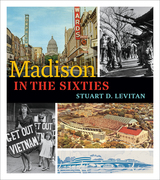 Madison in the Sixties
Stuart D. Levitan
Wisconsin Historical Society Press, 2018 Madison made history in the sixties.
Landmark civil rights laws were passed. Pivotal campus protests were waged. A spring block party turned into a three-night riot. Factor in urban renewal troubles, a bitter battle over efforts to build Frank Lloyd Wright’s Monona Terrace, and the expanding influence of the University of Wisconsin, and the decade assumes legendary status.
In this first-ever comprehensive narrative of these issues—plus accounts of everything from politics to public schools, construction to crime, and more—Madison historian Stuart D. Levitan chronicles the birth of modern Madison with style and well-researched substance. This heavily illustrated book also features annotated photographs that document the dramatic changes occurring downtown, on campus, and to the Greenbush neighborhood throughout the decade. Madison in the Sixties is an absorbing account of ten years that changed the city forever.
 Madison: Portraits of Our Neighbors
Laura Jo Amaral and Stacie Huckeba; Foreword by Carlene Carter
Vanderbilt University Press, 2025 Internationally recognized photographer Stacie Huckeba and Madison, Tennessee, community volunteer Laura Amaral have partnered to create a photographic art book and living historical document, Madison: Portraits of Our Neighbors. This is a “time capsule” of art as well as a historical document that captures the heart of the people who contribute to the Madison community as it is today, home to a world-class bass player, a nonagenarian cattle farmer, a TikTok celebrity, a singer/songwriter, a mariachi band, the personal photographer for Johnny Cash, a beloved gymnastics coach, model airplane enthusiasts, educators, a fashion designer, a puppet enthusiast, a pastor and outreach worker, an array of artists, small business owners, farmers, and local legends. Beyond a collection of portraits, it's a testament to an enduring urban community, a celebration of the shared human experience, and an opportunity to see our neighbors in their best light. Madison: Portraits of Our Neighbors invites readers to celebrate the tapestry of humanity that weaves through our unique neighborhood.
Madison: The Illustrated Sesquicentennial History, Volume 1, 1856–1931
Stuart D. Levitan
University of Wisconsin Press, 2006 This engaging illustrated history, full of photographs, maps, and bird’s-eye views, captures Madison’s early history from its first days as a city to the Great Depression. Biographical vignettes tell the stories of early movers and shakers in the city. The volume includes many archival images of Madison that have never been published or have not been seen since for a century or more.
The Madison Women: Gender, Higher Education, and Literacy in Nineteenth-Century Appalachia
Amanda E. Hayes
West Virginia University Press, 2024 By uncovering how higher education and gender roles evolved in Appalachia over time, The Madison Women delivers a history that contradicts the stereotype of the region as hostile to education, highlighting colleges that proliferated the area in the 19th century. Indeed, many of these colleges were either coeducational or even specifically for women, ultimately contradicting another stereotype--that Appalachia is a region particularly hostile toward women.
Incorporating captivating mini-biographies of women who attended Madison College and who went on to change their communities in ways large and small, this book reveals how the lives of its students impart lessons about history, regional culture, and how we can shape the Appalachia's future.
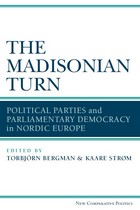 The Madisonian Turn: Political Parties and Parliamentary Democracy in Nordic Europe
Torbjörn Bergman and Kaare Strøm, editors
University of Michigan Press, 2013 "The Madisonian Turn is an outstanding assessment of the functioning of democratic institutions in the Nordic countries. If democracy is in trouble in Scandinavia, then it is surely facing problems everywhere, so the book will be read carefully by those concerned about contemporary governance in all modern democracies."
---Michael Gallagher, Trinity College, Dublin "This welcome and timely re-evaluation of Nordic politics constitutes a major contribution to comparative government, and is likely to stand as the definitive treatment of politics in the region for many years to come."
---Peter Mair, European University Institute "This book is unique in its comparative scope and the wealth of information on the state of parliamentary democracy in the Nordic countries. It is particularly useful for the comparativists who do not come from these countries, because the original literature which it covers in detail is often not accessible for the English-speaking audience."
---Hanspeter Kriesi, University of Zurich "The strength of The Madisonian Turn is to interface detailed empirical evidence on the dynamics of democratic politics in Scandinavia with an elaboration and test of rival theories of change in the politics of postindustrial democracies. This book is an inspiration for students of Northern Europe, but also for scholars of comparative legislatures and political parties more generally."
---Herbert Kitschelt, Duke University Parliamentary democracy is the most common regime type in the contemporary political world, but the quality of governance depends on effective parliamentary oversight and strong political parties. Denmark, Finland, Iceland, Norway, and Sweden have traditionally been strongholds of parliamentary democracy. In recent years, however, critics have suggested that new challenges such as weakened popular attachment, the advent of cartel parties, the judicialization of politics, and European integration have threatened the institutions of parliamentary democracy in the Nordic region. This volume examines these claims and their implications. The authors find that the Nordic states have moved away from their previous resemblance to a Westminster model toward a form of parliamentary democracy with more separation-of-powers features---a Madisonian model. These features are evident both in vertical power relations (e.g., relations with the European Union) and horizontal ones (e.g., increasingly independent courts and central banks). Yet these developments are far from uniform and demonstrate that there may be different responses to the political challenges faced by contemporary Western democracies. Torbjörn Bergman is Professor of Political Science at Umeå University, Sweden. Kaare Strøm is Professor of Political Science at the University of California, San Diego. Jacket Credit: Heidi Hobde Dailey
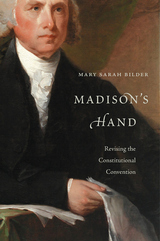 Madison’s Hand: Revising the Constitutional Convention
Mary Sarah Bilder
Harvard University Press, 2015 Winner of the Bancroft Prize
Winner of the James Bradford Best Biography Prize, Society for Historians of the Early American Republic
Finalist, Literary Award for Nonfiction, Library of Virginia
Finalist, George Washington Prize
James Madison’s Notes on the 1787 Constitutional Convention have acquired nearly unquestioned authority as the description of the U.S. Constitution’s creation. No document provides a more complete record of the deliberations in Philadelphia or depicts the Convention’s charismatic figures, crushing disappointments, and miraculous triumphs with such narrative force. But how reliable is this account?
“[A] superb study of the Constitutional Convention as selectively reflected in Madison’s voluminous notes on it…Scholars have been aware that Madison made revisions in the Notes but have not intensively explored them. Bilder has looked closely indeed at the Notes and at his revisions, and the result is this lucid, subtle book. It will be impossible to view Madison’s role at the convention and read his Notes in the same uncomplicated way again…An accessible and brilliant rethinking of a crucial moment in American history.”
—Robert K. Landers, Wall Street Journal
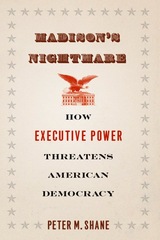 Madison's Nightmare: How Executive Power Threatens American Democracy
Peter M. Shane
University of Chicago Press, 2009 The George W. Bush administration’s ambitious—even breathtaking—claims of unilateral executive authority raised deep concerns among constitutional scholars, civil libertarians, and ordinary citizens alike. But Bush’s attempts to assert his power are only the culmination of a near-thirty-year assault on the basic checks and balances of the U.S. government—a battle waged by presidents of both parties, and one that, as Peter M. Shane warns in Madison’s Nightmare, threatens to utterly subvert the founders’ vision of representative government. Tracing this tendency back to the first Reagan administration, Shane shows how this era of "aggressive presidentialism" has seen presidents exerting ever more control over nearly every arena of policy, from military affairs and national security to domestic programs. Driven by political ambition and a growing culture of entitlement in the executive branch—and abetted by a complaisant Congress, riven by partisanship—this presidential aggrandizement has too often undermined wise policy making and led to shallow, ideological, and sometimes outright lawless decisions. The solution, Shane argues, will require a multipronged program of reform, including both specific changes in government practice and broader institutional changes aimed at supporting a renewed culture of government accountability. From the war on science to the mismanaged war on terror, Madison’s Nightmare outlines the disastrous consequences of the unchecked executive—and issues a stern wake-up call to all who care about the fate of our long democratic experiment.
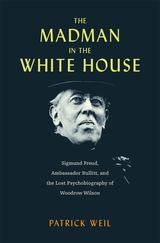 The Madman in the White House: Sigmund Freud, Ambassador Bullitt, and the Lost Psychobiography of Woodrow Wilson
Patrick Weil
Harvard University Press, 2023 “The extraordinary untold story of how a disillusioned American diplomat named William C. Bullitt came to Freud’s couch in 1926, and how Freud and his patient collaborated on a psychobiography of President Woodrow Wilson.”—Wall Street Journal
The notorious psychobiography of Woodrow Wilson, rediscovered nearly a century after it was written by Sigmund Freud and US diplomat William C. Bullitt, sheds new light on how the mental health of a controversial American president shaped world events.
When the fate of millions rests on the decisions of a mentally compromised leader, what can one person do? Disillusioned by President Woodrow Wilson’s destructive and irrational handling of the 1919 Treaty of Versailles, a US diplomat named William C. Bullitt asked this very question. With the help of his friend Sigmund Freud, Bullitt set out to write a psychological analysis of the president. He gathered material from personal archives and interviewed members of Wilson’s inner circle. In The Madman in the White House, Patrick Weil resurrects this forgotten portrait of a troubled president.
After two years of collaboration, Bullitt and Freud signed off on a manuscript in April 1932. But the book was not published until 1966, nearly thirty years after Freud’s death and only months before Bullitt’s. The published edition was heavily redacted, and by the time it was released, the mystique of psychoanalysis had waned in popular culture and Wilson’s legacy was unassailable. The psychological study was panned by critics, and Freud’s descendants denied his involvement in the project.
For nearly a century, the mysterious, original Bullitt and Freud manuscript remained hidden from the public. Then in 2014, while browsing the archives of Yale University, Weil happened upon the text. Based on his reading of the 1932 manuscript, Weil examines the significance of Bullitt and Freud’s findings and offers a major reassessment of the notorious psychobiography. The result is a powerful warning about the influence a single unbalanced personality can have on the course of history.
 The Madman in the White House: Sigmund Freud, Ambassador Bullitt, and the Lost Psychobiography of Woodrow Wilson
Patrick Weil
Harvard University Press Shortlist, Cundill History Prize
“The extraordinary untold story of how a disillusioned American diplomat named William C. Bullitt came to Freud’s couch in 1926, and how Freud and his patient collaborated on a psychobiography of President Woodrow Wilson.” —Wall Street Journal
“A vivid shaggy-dog story about a curio that illuminates the possibilities (and perils) of studying the psychological soundness of presidents—a discipline as relevant as ever.” —The Atlantic
“Excellent…Nearly a century since Wilson’s death, Weil’s monograph is the first to offer a comprehensive historical account of Bullitt’s career-long engagement with Wilson.” —American Literary History
When the fate of millions rests on the decisions of a mentally compromised leader, what can one person do? Alarmed by President Woodrow Wilson’s irrational handling of the 1919 Treaty of Versailles, a US diplomat named William C. Bullitt asked this very question. With the help of his friend Sigmund Freud—and the cooperation of interviewees in Wilson’s inner circle—Bullitt set out to write a psychological biography of a troubled president. In The Madman in the White House, Patrick Weil resurrects this forgotten portrait.
The manuscript was completed in 1932, but the book was not published until 1966, in a heavily redacted edition. By that time, the mystique of psychoanalysis had waned and Wilson’s legacy was unassailable. Critics panned the book, and Freud’s descendants denied his involvement. But in 2014, Weil discovered the original manuscript, which leaves no doubt as to Freud’s role—or the significance of Bullitt and Freud’s analysis. Reassessing the notorious psychobiography, Weil finds a powerful warning about the influence a single unbalanced personality can have on the course of history.
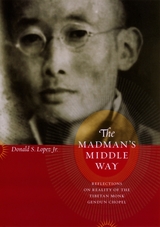 The Madman's Middle Way: Reflections on Reality of the Tibetan Monk Gendun Chopel
Donald S. Lopez Jr.
University of Chicago Press, 2005 Gendun Chopel is considered the most important Tibetan intellectual of the twentieth century. His life spanned the two defining moments in modern Tibetan history: the entry into Lhasa by British troops in 1904 and by Chinese troops in 1951. Recognized as an incarnate lama while he was a child, Gendun Chopel excelled in the traditional monastic curriculum and went on to become expert in fields as diverse as philosophy, history, linguistics, geography, and tantric Buddhism. Near the end of his life, before he was persecuted and imprisoned by the government of the young Dalai Lama, he would dictate the Adornment for Nagarjuna’s Thought, a work on Madhyamaka, or “Middle Way,” philosophy. It sparked controversy immediately upon its publication and continues to do so today.
The Madman’s Middle Way presents the first English translation of this major Tibetan Buddhist work, accompanied by an essay on Gendun Chopel’s life liberally interspersed with passages from his writings. Donald S. Lopez Jr. also provides a commentary that sheds light on the doctrinal context of the Adornment and summarizes its key arguments. Ultimately, Lopez examines the long-standing debate over whether Gendun Chopel in fact is the author of the Adornment; the heated critical response to the work by Tibetan monks of the Dalai Lama’s sect; and what the Adornment tells us about Tibetan Buddhism’s encounter with modernity. The result is an insightful glimpse into a provocative and enigmatic workthatwill be of great interest to anyone seriously interested in Buddhism or Asian religions.
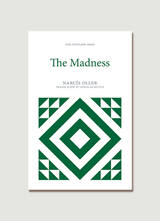 The Madness
Narcís Oller, Translated by Douglas Suttle
Fum d'Estampa Press, 2020 Written in nine chapters separated into three blocks, Narcís Oller’s The Madness is one of the first literary pieces of work to aim to truly analyze the social and genetic causes and results of mental illness. Told through the eyes of an anonymous “narrator” character, The Madness tells the story of a young revolutionary called Daniel Serrallonga and his gradual deterioration into madness and delusion. Set against the backdrop of the political crisis that ripped Spain apart in the mid to late 19th century and laid the foundations of the Spanish Civil War, The Madness is a fascinating study of mental health within both rural and urban Catalan society.
As relevant and entertaining now as it was when it was first published, this lively translation brings this fantastic piece of literature to new, modern audiences while drawing parallels with some of the 19th century’s greatest English language writers such as Charles Dickens and Thomas Hardy.
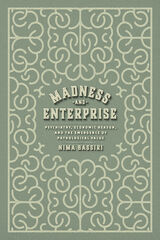 Madness and Enterprise: Psychiatry, Economic Reason, and the Emergence of Pathological Value
Nima Bassiri
University of Chicago Press, 2024 Uncovers a powerful relationship between pathology and money: beginning in the nineteenth century, the severity of mental illness was measured against a patient’s economic productivity.
Madness and Enterprise reveals the economic norms embedded within psychiatric thinking about mental illness in the North Atlantic world. Over the course of the nineteenth century, various forms of madness were subjected to a style of psychiatric reasoning that was preoccupied with money. Psychiatrists across Western Europe and the United States attributed financial and even moral value to an array of pathological conditions, such that some mental disorders were seen as financial assets and others as economic liabilities. By turning to economic conduct and asking whether potential patients appeared capable of managing their financial affairs or even generating wealth, psychiatrists could often bypass diagnostic uncertainties about a person’s mental state.
Through an exploration of the intertwined histories of psychiatry and economic thought, Nima Bassiri shows how this relationship transformed the very idea of value in the modern North Atlantic, as the most common forms of social valuation—moral value, medical value, and economic value—were rendered equivalent and interchangeable. If what was good and what was healthy were increasingly conflated with what was remunerative (and vice versa), then a conceptual space opened through which madness itself could be converted into an economic form and subsequently redeemed—and even revered.
 Madness and Enterprise: Psychiatry, Economic Reason, and the Emergence of Pathological Value
Nima Bassiri
University of Chicago Press, 2024 This is an auto-narrated audiobook version of this book. Uncovers a powerful relationship between pathology and money: beginning in the nineteenth century, the severity of mental illness was measured against a patient’s economic productivity.
Madness and Enterprise reveals the economic norms embedded within psychiatric thinking about mental illness in the North Atlantic world. Over the course of the nineteenth century, various forms of madness were subjected to a style of psychiatric reasoning that was preoccupied with money. Psychiatrists across Western Europe and the United States attributed financial and even moral value to an array of pathological conditions, such that some mental disorders were seen as financial assets and others as economic liabilities. By turning to economic conduct and asking whether potential patients appeared capable of managing their financial affairs or even generating wealth, psychiatrists could often bypass diagnostic uncertainties about a person’s mental state.
Through an exploration of the intertwined histories of psychiatry and economic thought, Nima Bassiri shows how this relationship transformed the very idea of value in the modern North Atlantic, as the most common forms of social valuation—moral value, medical value, and economic value—were rendered equivalent and interchangeable. If what was good and what was healthy were increasingly conflated with what was remunerative (and vice versa), then a conceptual space opened through which madness itself could be converted into an economic form and subsequently redeemed—and even revered.
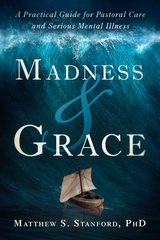 Madness and Grace: A Practical Guide for Pastoral Care and Serious Mental Illness
Matthew Stanford
Templeton Press, 2021 Research tells us that when most people suffer from a mental health crisis, the first person they turn to for help is not a physician, a psychiatrist, or a social worker, but a pastor, a priest, or a minister. In other words, a leader in their church. Unfortunately, many church leaders are not trained to recognize mental illness and don’t know when to refer someone to a mental health professional. The consequence—unintended yet tragic—is continued and unnecessary suffering.
Madness and Grace is a comprehensive guide for church ministry to alleviate this situation. Written by Dr. Matthew Stanford, the book is carefully constructed to help build competency in detecting a wide spectrum of mental disorders, such as knowing when a person is contemplating suicide based on telltale patterns of speech. It also explodes common discriminatory myths that stigmatize people with mental illness, such as the myth that they are more prone to violence than others.
Dr. Stanford has treated clients throughout his career who were afflicted with all manner of mental disorders. In Madness and Grace, he takes the full extent of his experience and makes it accessible and actionable for the lay reader. He begins by explaining what constitutes a mental illness and how these disorders are classified according to science. He next teaches how to notice the presence of a mental illness by listening carefully to phraseology, observing behavior, and asking discerning questions. He goes on to discuss methods of treatment, common religious concerns about mental health, and ways church communities can support people on the road to recovery.
As a Christian, Dr. Stanford wants his fellow believers to know that acknowledging and seeking help for a mental illness is not a sign of weak faith. That’s why, in addition to sharing his medical expertise with church leaders, he commends pertinent biblical passages that underscore God’s concern for our mental wellbeing. These passages provide strength and comfort as complements to clinically-derived treatment and are essential to Dr. Stanford’s approach. “When working with those in severe psychological distress,” he writes, “compassion and grace are always the first line of pastoral care.”
Madness and Modernism: Insanity in the Light of Modern Art, Literature, and Thought
Louis Sass
Harvard University Press The similarities between madness and modernism are striking: defiance of authority, nihilism, extreme relativism, distortions of time, strange transformations of self, and much more. In this brilliant book, Louis Sass, a clinical psychologist, offers a startlingly new vision of schizophrenia, comparing it with the works of such artists and writers as Kafka, Beckett, and Duchamp and considering the ideas of philosophers including Nietzsche, Heidegger, Foucault, and Derrida. Here is a highly original portrait of the world of the madman, along with a provocative commentary on modernist and postmodernist culture.
Madness, Distress and the Politics of Disablement
Edited by Helen Spandler, Jill Anderson, and Bob Sapey
Bristol University Press, 2015 This book explores the challenges of applying disability theory and policy, including the social model of disability, to madness and distress. It brings together leading scholars and activists from Europe, North America, Australia, and India, to explore the relationship between madness, distress, and disability. Whether mental health problems should be viewed as disabilities is a pressing concern, especially since the inclusion of psychosocial disability in the UN Convention on the Rights of Persons with Disabilities. This book will appeal to policy makers, practitioners, activists, and academics.
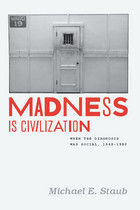 Madness Is Civilization: When the Diagnosis Was Social, 1948-1980
Michael E. Staub
University of Chicago Press, 2011 In the 1960s and 1970s, a popular diagnosis for America’s problems was that society was becoming a madhouse. In this intellectual and cultural history, Michael E. Staub examines a time when many believed insanity was a sane reaction to obscene social conditions, psychiatrists were agents of repression, asylums were gulags for society’s undesirables, and mental illness was a concept with no medical basis. Madness Is Civilization explores the general consensus that societal ills—from dysfunctional marriage and family dynamics to the Vietnam War, racism, and sexism—were at the root of mental illness. Staub chronicles the surge in influence of socially attuned psychodynamic theories along with the rise of radical therapy and psychiatric survivors' movements. He shows how the theories of antipsychiatry held unprecedented sway over an enormous range of medical, social, and political debates until a bruising backlash against these theories—part of the reaction to the perceived excesses and self-absorptions of the 1960s—effectively distorted them into caricatures. Throughout, Staub reveals that at stake in these debates of psychiatry and politics was nothing less than how to think about the institution of the family, the nature of the self, and the prospects for, and limits of, social change. The first study to describe how social diagnostic thinking emerged, Madness Is Civilization casts new light on the politics of the postwar era.
Madness, Language, Literature
Michel Foucault
University of Chicago Press, 2023 Newly published lectures by Foucault on madness, literature, and structuralism.
Perceiving an enigmatic relationship between madness, language, and literature, French philosopher Michel Foucault developed ideas during the 1960s that are less explicit in his later, more well-known writings. Collected here, these previously unpublished texts reveal a Foucault who undertakes an analysis of language and experience detached from their historical constraints. Three issues predominate: the experience of madness across societies; madness and language in Artaud, Roussel, and Baroque theater; and structuralist literary criticism. Not only do these texts pursue concepts unique to this period such as the “extra-linguistic,” but they also reveal a far more complex relationship between structuralism and Foucault than has typically been acknowledged.
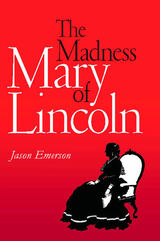 The Madness of Mary Lincoln
Jason Emerson
Southern Illinois University Press, 2007 WINNER, Russell P. Strange Memorial Book of the Year Award from the Illinois State Historical Society, 2007!
University Press Books for Public and Secondary Schools 2013 edition
In 2005, historian Jason Emerson discovered a steamer trunk formerly owned by Robert Todd Lincoln's lawyer and stowed in an attic for forty years. The trunk contained a rare find: twenty-five letters pertaining to Mary Todd Lincoln's life and insanity case, letters assumed long destroyed by the Lincoln family. Mary wrote twenty of the letters herself, more than half from the insane asylum to which her son Robert had her committed, and many in the months and years after. The Madness of Mary Lincoln is the first examination of Mary Lincoln’s mental illness based on the lost letters, and the first new interpretation of the insanity case in twenty years. This compelling story of the purported insanity of one of America’s most tragic first ladies provides new and previously unpublished materials, including the psychiatric diagnosis of Mary’s mental illness and her lost will. Emerson charts Mary Lincoln’s mental illness throughout her life and describes how a predisposition to psychiatric illness and a life of mental and emotional trauma led to her commitment to the asylum. The first to state unequivocally that Mary Lincoln suffered from bipolar disorder, Emerson offers a psychiatric perspective on the insanity case based on consultations with psychiatrist experts. This book reveals Abraham Lincoln’s understanding of his wife’s mental illness and the degree to which he helped keep her stable. It also traces Mary’s life after her husband’s assassination, including her severe depression and physical ailments, the harsh public criticism she endured, the Old Clothes Scandal, and the death of her son Tad. The Madness of Mary Lincoln is the story not only of Mary, but also of Robert. It details how he dealt with his mother’s increasing irrationality and why it embarrassed his Victorian sensibilities; it explains the reasons he had his mother committed, his response to her suicide attempt, and her plot to murder him. It also shows why and how he ultimately agreed to her release from the asylum eight months early, and what their relationship was like until Mary’s death. This historical page-turner provides readers for the first time with the lost letters that historians had been in search of for eighty years.
The Madness of the Saints: Ecstatic Religion in Bengal
June McDaniel
University of Chicago Press, 1989 Although ecstasy has been explored in several Indian contexts, surprisingly little scholarship has been devoted to its central role in Bengali devotion. In The Madness of the Saints, June McDaniel undertakes the first comprehensive study of religious ecstasy in Bengal, examining the texts that describe it, the people who experience it, and the traditions that support it.
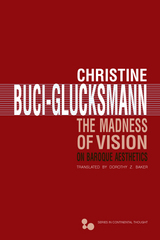 The Madness of Vision: On Baroque Aesthetics
Christine Buci-Glucksmann
Ohio University Press, 2013 Christine Buci-Glucksmann’s The Madness of Vision is one of the most influential studies in phenomenological aesthetics of the baroque. Integrating the work of Merleau-Ponty with Lacanian psychoanalysis, Renaissance studies in optics, and twentieth-century mathematics, the author asserts the materiality of the body and world in her aesthetic theory. All vision is embodied vision, with the body and the emotions continually at play on the visual field. Thus vision, once considered a clear, uniform, and totalizing way of understanding the material world, actually dazzles and distorts the perception of reality. In each of the nine essays that form The Madness of Vision Buci-Glucksmann develops her theoretical argument via a study of a major painting, sculpture, or influential visual image—Arabic script, Bettini’s “The Eye of Cardinal Colonna,” Bernini’s Saint Teresa and his 1661 fireworks display to celebrate the birth of the French dauphin, Caravaggio’s Judith Beheading Holofernes, the Paris arcades, and Arnulf Rainer’s self-portrait, among others—and deftly crosses historical, national, and artistic boundaries to address Gracián’s El Criticón; Monteverdi’s opera Orfeo; the poetry of Hafiz, John Donne, and Baudelaire; as well as baroque architecture and Anselm Kiefer’s Holocaust paintings. In doing so, Buci-Glucksmann makes the case for the pervasive influence of the baroque throughout history and the continuing importance of the baroque in contemporary arts.
 Madonnaland: And Other Detours into Fame and Fandom
By Alina Simone
University of Texas Press, 2016 When Alina Simone agreed to write a book about Madonna, she thought it might provide an interesting excuse to indulge her own eighties nostalgia. Wrong. What Simone discovered instead was a tidal wave of already published information about Madonna—and her own ambivalence about, maybe even jealousy of, the Material Girl’s overwhelming commercial success. With the straight-ahead course stymied, Simone set off on a quirky detour through the backroads of celebrity and fandom and the people who love or loathe Madonna. In this witty, sometimes acerbic, always perceptive chronicle, Simone begins by trying to understand why Madonna’s birthplace, Bay City, Michigan, won’t even put up a sign to celebrate its most famous citizen, and ends by asking why local bands who make music that’s authentic and true can disappear with barely a trace. In between, she ranges from Madonna fans who cover themselves with tattoos of the singer’s face and try to make fortunes off selling her used bustiers and dresses, to Question Mark and the Mysterians—one-hit wonders best known for “96 Tears”—and Flying Wedge, a Detroit band that dropped off an amazing two-track record in the office of CREEM magazine in 1972 and vanished, until Simone tracked it down. Filled with fresh insights about the music business, fandom, and what it takes to become a superstar, Madonnaland is as much a book for people who, like Simone, prefer “dark rooms, coffee, and state-subsidized European films filled with existential despair” as it is for people who can’t get enough of Madonna.
The Madrasa in Asia: Political Activism and Transnational Linkages
Edited by Farish A. Noor, Yoginder Sikand and Martin van Bruinessen
Amsterdam University Press, 2009
Since the rise of organizations like the Taliban and Al Qaeda, the traditional Islamic school known as the madrasa has frequently been portrayed as a terrorist hotbed. For much longer, the madrasa has been considered by some as a backward and petrified impediment to Islamic social progress. However, for an important segment of the poor Muslim populations of Asia, madrasas constitute the only accessible form of education and an opening to the wider world. This comprehensive volume presents a representative overview of the unknown world behind the walls of these institutions in nations such as China, Indonesia, Iran, and Pakistan, showcasing the educational changes and transnational networks that help to produce an alternative form of globalization.
 Madre and I: A Memoir of Our Immigrant Lives
Guillermo Reyes
University of Wisconsin Press, 2010 In this moving and funny memoir, award-winning playwright Guillermo Reyes untangles his life as the secretly illegitimate son of a Chilean immigrant to the United States and as a young man struggling with sexual repression, body image, and gay identity. But this is a double-decker memoir that also tells the poignant, bittersweet, and adventurous story of Guillermo’s mother, María, who supports herself and her son cleaning houses and then working as a nanny in Washington, D.C. and eventually in Hollywood.
In one memorable scene, after realizing that her friend Carmen is cleaning the house of one of the producers of Annie Hall, María recruits her to take her picture as she poses dramatically with Mr. Joffe’s Oscar in hand. It is María’s defiant yet determined attitude amidst her sacrifices that allows for Guillermo’s spirited coming of age and coming out.
Their common ground is the drama of their encounters with discovery, heartbreak, and passion—the explosive emotions that light up the stage of their two-actor theater. Honorable Mention, Best Auto/Biography in English, International Latino Book Awards
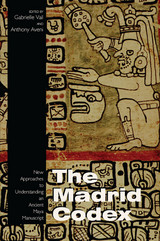 The Madrid Codex: New Approaches to Understanding an Ancient Maya Manuscript
Gabrielle Vail
University Press of Colorado, 2004 This volume offers new calendrical models and methodologies for reading, dating, and interpreting the general significance of the Madrid Codex. The longest of the surviving Maya codices, this manuscript includes texts and images painted by scribes conversant in Maya hieroglyphic writing, a written means of communication practiced by Maya elites from the second to the fifteenth centuries A.D. Some scholars have recently argued that the Madrid Codex originated in the Petén region of Guatemala and postdates European contact. The contributors to this volume challenge that view by demonstrating convincingly that it originated in northern Yucatán and was painted in the Pre-Columbian era. In addition, several contributors reveal provocative connections among the Madrid and Borgia group of codices from Central Mexico. Contributors include: Harvey M. Bricker, Victoria R. Bricker, John F. Chuchiak IV, Christine L. Hernández, Bryan R. Just, Merideth Paxton, and John Pohl. Additional support for this publication was generously provided by the Eugene M. Kayden Fund at the University of Colorado.
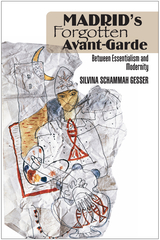 Madrid's Forgotten Avante-Garde: Between Essentialism and Modernity
Silvina Schammah Gesser
Sussex Academic Press, 2022 Madrid's Forgotten Avant-Garde explores the role played by artists and intellectuals who constructed and disseminated various competing images of national identity which polarized Spanish society prior to the Civil War. The convergence of modern and essentialist discourses and practices, especially in literature and poetry, in what is conventionally called in Spanish letters 'The Generation of '27', created fissures between competing views of aesthetics and ideology that cut across political affiliation. Silvina Schammah exposes the paradoxes facing Madrid's cultural vanguards, as they were torn by their ambition for universality, cosmopolitanism and transcendence on the one hand and by the centripetal forces of nationalistic ideologies on the other. Taking upon themselves roles to become the disseminators and populizers of radical positions and world-views first elaborated and conducted by the young urban intelligentsia, their proposed aim of incorporating diverse identities embedded in different cultural constructions and discourse was to have very real and tragic consequences as political and intellectual lines polarized in the years prior to the Spanish Civil War.
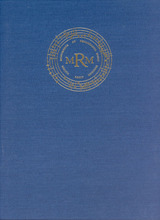 The Madrigals of Michelangelo Rossi
Michelangelo Rossi
University of Chicago Press, 2002 Michelangelo Rossi's two books of five-voice polyphonic madrigals are among the most expressive works of their kind ever composed. Showing the influence of Gesualdo, the madrigals were probably written in Rome between 1624 and 1629, when Rossi was in the service of Cardinal Maurizio of Savoy. They were apparently never published, and there is only one complete manuscript source, which once belonged to Queen Christina of Sweden and now forms the principal source for Brian Mann's critical edition.
In his extensive introduction, Mann considers in detail the biographical, cultural, and stylistic milieu in which the madrigals were written. The scholarly edition of the music, based on a thorough examination of all the known sources, includes a complete critical commentary.
Mann's work on Rossi's madrigals has already helped revive interest in them. In 1998 a CD recording of Book I appeared on the Virgin label, performed by Il Complesso Barocco under the direction of Alan Curtis, and based on this critical edition.
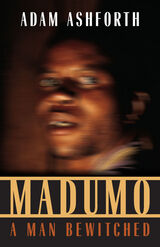 Madumo, a Man Bewitched
Adam Ashforth
University of Chicago Press, 2000 No one answered when I tapped at the back door of Madumo's home on Mphahlele Street a few days after my return to Soweto, so I pushed the buckling red door in a screeching grind of metal over concrete and entered calling, "Hallo?"
So begins this true story of witchcraft and friendship set against the turbulent backdrop of contemporary Soweto. Adam Ashforth, an Australian who has spent many years in the black township, finds his longtime friend Madumo in dire circumstances: his family has accused him of using witchcraft to kill his mother and has thrown him out on the street. Convinced that his life is cursed, Madumo seeks help among Soweto's bewildering array of healers and prophets. An inyanga, or traditional healer, confirms that he has indeed been bewitched. With Ashforth by his side, skeptical yet supportive, Madumo embarks upon a physically grueling treatment regimen that he follows religiously-almost to the point of death-despite his suspicion that it may be better to "Westernize my mind and not think about witchcraft."
Ashforth's beautifully written, at times poignant account of Madumo's struggle shows that the problem of witchcraft is not simply superstition, but a complex response to spiritual insecurity in a troubling time of political and economic upheaval. Post-apartheid Soweto, he discovers, is suffering from a deluge of witchcraft. Through Madumo's story, Ashforth opens up a world that few have seen, a deeply unsettling place where the question "Do you believe in witchcraft?" is not a simple one at all. The insights that emerge as Ashforth accompanies his friend on an odyssey through Soweto's supernatural perils have profound implications even for those of us who live in worlds without witches.
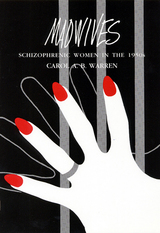 Madwives: Schizophrenic Women in the 1950s
Warren, Carol A
Rutgers University Press "An important contribution to the study of mental illness, gender roles, and family interaction. . . . An insightful and well-written book demonstrating the pervasive consequences of gender roles for the deepest levels of mind and emotion."--American Journal of Sociology
"Opens a window onto the lives of the mentally ill and their families."--Women's Review of Books "Warren's analysis is painstaking and illuminating, and there is plenty of material here to interest those concerned with issues of gender and mental illness."--Times Higher Education Supplement
"The women make the author's major points in riveting fashion, speaking eloquently of enforced dependency and subjugation, the helplessness of rigid and constantly reinforced gender-role boundaries, and outright manipulation by their husbands."--Contemporary Psychology
"Can marriage make women go crazy? Carol Warren addresses this question by emphasizing the connections between gender-sterotypical behavior and the institutionalization of married women in the 1950s, using interviews collected . . . during 1957-61. . . . An interesting sociological reworking of the original pychologically oriented interpretation of the interviews."--Oral History Review
Carol A. B. Warren is a professor of sociology at the University of Kansas and author of The Court of Last Resort: Mental Illness and the Law.
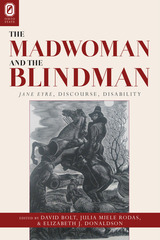 The Madwoman and the Blindman: Jane Eyre, Discourse, Disability
Edited by David Bolt, Julia Miele Rodas, and Elizabeth J. Donaldson
Ohio State University Press, 2012 This breakthrough volume of critical essays on Jane Eyre from a disability perspective provides fresh insight into Charlotte Brontë’s classic novel from a vantage point that is of growing academic and cultural importance. Contributors include many of the preeminent disability scholars publishing today, including a foreword by Lennard J. Davis. Though an indisputable classic and a landmark text for critical voices from feminism to Marxism to postcolonialism, until now, Jane Eyre has never yet been fully explored from a disability perspective. Customarily, impairment in the novel has been read unproblematically as loss, an undesired deviance from a condition of regularity vital to stable closure of the marriage plot. In fact, the most visible aspects of disability in the novel have traditionally been understood in rather rudimentary symbolic terms—the blindness of Rochester and the “madness” of Bertha apparently standing in for other aspects of identity. The Madwoman and the Blindman: Jane Eyre, Discourse, Disability, resists this traditional reading of disability in the novel. Informed by a variety of perspectives—cultural studies, linguistics, and gender and film studies—the essays in this collection suggest surprising new interpretations, parsing the trope of the Blindman, investigating the embodiment of mental illness, and proposing an autistic identity for Jane Eyre. As the first volume of criticism dedicated to analyzing and theorizing the role of disability in a single literary text, The Madwoman and the Blindman is a model for how disability studies can open new conversation and critical thought within the literary canon.
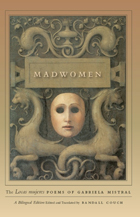 Madwomen: The "Locas mujeres" Poems of Gabriela Mistral, a Bilingual Edition
Gabriela Mistral
University of Chicago Press, 2008 A stunning collection of poems in translation by a groundbreaking Chilean woman
A schoolteacher whose poetry catapulted her to early fame in her native Chile and an international diplomat whose boundary-defying sexuality still challenges scholars, Gabriela Mistral (1889–1957) is one of the most important and enigmatic figures in Latin American literature of the last century. The Locas mujeres poems collected here are among Mistral’s most complex and compelling, exploring facets of the self in extremis—poems marked by the wound of blazing catastrophe and its aftermath of mourning.
From disquieting humor to balladlike lyricism to folkloric wisdom, these pieces enact a tragic sense of life, depicting “madwomen” who are anything but mad. Strong and intensely human, Mistral’s poetic women confront impossible situations to which no sane response exists. This groundbreaking collection presents poems from Mistral’s final published volume as well as new editions of posthumous work, featuring the first English-language appearance of many essential poems. Madwomen promises to reveal a profound poet to a new generation of Anglophone readers while reacquainting Spanish readers with a stranger, more complicated “madwoman” than most have ever known.
Maestro: Love Sonnets
Roger Armbrust
Parkhurst Brothers, Inc., 2021 Roger Armbrust’s collection of 55 poems represents an extended love song for the world’s great classical composers. Many of the sonnets envision history’s maestros at some phase of their extraordinary lives. A few of the verses are celebrations of life which include a reverent mention of a master. Taken together, they convey the poet’s deep respect for these geniuses and the creative process. In one sonnet, he writes of Mendelssohn:
Sense of presence leading to reverence,
not so much awaking as reverie
evolving to understanding, essence
of living within all.
Armbrust conveys this mood of reverence, reverie, and understanding throughout this collection.
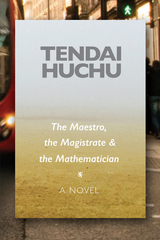 The Maestro, the Magistrate and the Mathematician: A Novel
Tendai Huchu
Ohio University Press, 2016 The Hairdresser of Harare, which the New York Times Book Review called “a fresh and moving account of contemporary Zimbabwe,” announced Tendai Huchu as a shrewd and funny social commentator. In The Maestro, the Magistrate & the Mathematician, Huchu expands his focus from Zimbabwe to the lives of expatriates in Edinburgh, Scotland. The novel follows three Zimbabwean men as they struggle to find places for themselves in Scotland. As he wanders Edinburgh with his Walkman on a constant loop of the music of home, the Magistrate—a former judge, now a health aide—tries to find meaning in new memories. The depressed and quixotic Maestro—gone AWOL from his job stocking shelves at a grocery store—escapes into books. And the youthful Mathematician enjoys a carefree and hedonistic graduate school life, until he can no longer ignore the struggles of his fellow expatriates. In this novel of ideas, Huchu deploys satire to thoughtful end in what is quickly becoming his signature mode. Shying from neither the political nor the personal, he creates a humorous but increasingly somber picture of love, loss, belonging, and politics in the Zimbabwean diaspora.
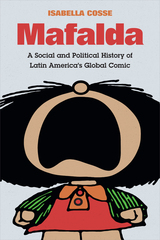 Mafalda: A Social and Political History of Latin America's Global Comic
Isabella Cosse
Duke University Press, 2019 Since its creation in 1964, readers from all over the world have loved the comic Mafalda, primarily because of the sharp wit and rebellious nature of its title character—a four-year-old girl who is wise beyond her years. Through Mafalda, Argentine cartoonist Joaquín Salvador Lavado explores complex questions about class identity, modernization, and state violence. In Mafalda: A Social and Political History of Latin America's Global Comic—first published in Argentina in 2014 and appearing here in English for the first time—Isabella Cosse analyzes the comic's vast appeal across multiple generations. From Mafalda breaking the fourth wall to speak directly to readers to express her opposition to the 1966 Argentine coup, to Spanish students' protest signs bearing her face, to the comic's cult status in Korea, Cosse provides insights into the cartoon's production, circulation, and incorporation into social and political conversations. Analyzing how Mafalda reflects generational conflicts, gender, modernization, the Cold War, authoritarianism, neoliberalism, and much more, Cosse demonstrates the unexpected power of humor to shape revolution and resistance.
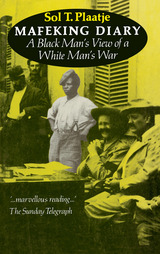 Mafeking Diary: A Black Man’s View of a White Man’s War
Sol T. Plaatje
Ohio University Press, 1990
“Sol Plaatje’s Mafeking Diary is a document of enduring importance and fascination. The product of a young black South African court interpreter, just turned 23 years old when he started writing, it opens an entirely new vista on the famous Siege of Mafeking. By shedding light on the part played by the African population of the town, Plaatje explodes the myth, maintained by belligerents, and long perpetuated by both historians and the popular imagination, this this was a white man’s affair. One of the great epics of British imperial history, and perhaps the best remembered episode of the Anglo-Boer war of 1899–1902, is presented from a wholly novel perspective.
“At the same time, the diary provides an intriguing insight into the character of a young man who was to play a key role in South African political and literary history during the first three decades of this century. It reveals much of the perceptions and motives that shaped his own attitudes and intellectual development and, indeed, those of an early generation of African leaders who sought to build a society which did not determine the place of its citizens by the colour of their skin. The diary therefore illuminates the origins of a struggle which continues to this day.”
— John L. Comaroff (ed.) in his preface
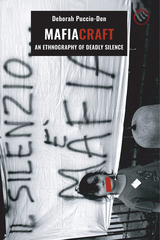 Mafiacraft: An Ethnography of Deadly Silence
Deborah Puccio-Den
HAU, 2021 "The Mafia? What is the Mafia? Something you eat? Something you drink? I don't know the Mafia. I've never seen it." Mafiosi have often reacted this way to questions from journalists and law enforcement. Social scientists who study the Mafia usually try to pin down what it "really is," thus fusing their work with their object. In Mafiacraft, Deborah Puccio-Den undertakes a new form of ethnographic inquiry that focuses not on answering "What is the Mafia?" but on the ontological, moral, and political effects of posing the question itself. Her starting point is that Mafia is not a readily nameable social fact but a problem of thought produced by the absence of words. Puccio-Den approaches covert activities using a model of "Mafiacraft," which inverts the logic of witchcraft. If witchcraft revolves on the lethal power of speech, Mafiacraft depends on the deadly strength of silence. How do we write an ethnography of phenomena that cannot be named? Puccio-Den approaches this task with a fascinating anthropology of silence, breaking new ground for the study of the world’s most famous criminal organization.
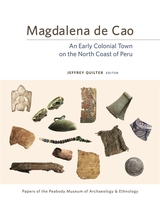 Magdalena de Cao: An Early Colonial Town on the North Coast of Peru
Jeffrey Quilter
Harvard University Press During the early Colonial Period in the Americas, as an ancient way of life ended and the modern world began, indigenous peoples and European invaders confronted, resisted, and compromised with one another. Yet archaeological investigations of this complex era are rare. Magdalena de Cao is an exception: the first in-depth and heavily illustrated examination of what life was like at one culturally mixed town and church complex during the early Colonial Period in Peru.
The field research reported in this volume took place at the site of Magdalena de Cao Viejo, a town on the edge of the Pacific Ocean whose 150-year lifespan ran from the Late Renaissance to the Age of Enlightenment. For a decade, an interdisciplinary team of researchers conducted archaeological and historical research in Peru, Spain, and the United States. Their analysis of documentary sources and recovered artifacts—including metals, textiles, beads, and fragmentary paper documents—opens new doors to understanding daily life in Magdalena de Cao during a turbulent time. Touching on themes of colonialism, cultural hybridity, resistance, and assimilation, Magdalena de Cao provides a comprehensive overview of the project itself and a rich body of data that will be of interest to researchers for years to come.
 Magdalene House: A Place about Mercy
Sarah VanHooser Suiter
Vanderbilt University Press, 2012 Women come to Magdalene House in Nashville when they are ready to leave the streets. They live togetherunsupervised and free of chargefor two years. During that time, the women are given time, space, and the resources they need to heal from what have often been lifelong experiences with suffering. (Of the twentytwo women now in residence, 80 percent have a diagnosed mental illness other than addiction, 40 percent are receiving treatment for hepatitis C, and onethird are HIV positive.)
However, the story of the Magdalene community is not about these statistics, but about the stories the women tell. They say they thrive in the community because it is a place where they are free to be themselves, safe to give and receive love, and free to speak their trutheven to complain sometimes about how their storytelling is exploited "for the good of the community." A Place about Mercy is a participantobservation account of the history of this remarkable community founded in 1997, its structure, its Thistle Farms beauty products operation, and Reverend Becca Stevens's communal and spiritual vision. The book is finally about what it means to walk the path of healing with a group of unlikely women as guide.
Magdalene House was the subject of a multiplepart documentary on National Public Radio.
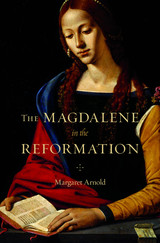 The Magdalene in the Reformation
Margaret Arnold
Harvard University Press, 2018 Prostitute, apostle, evangelist—the conversion of Mary Magdalene from sinner to saint is one of the Christian tradition’s most compelling stories, and one of the most controversial. The identity of the woman—or, more likely, women—represented by this iconic figure has been the subject of dispute since the Church’s earliest days. Much less appreciated is the critical role the Magdalene played in remaking modern Christianity.
In a vivid recreation of the Catholic and Protestant cultures that emerged in the sixteenth and seventeenth centuries, The Magdalene in the Reformation reveals that the Magdalene inspired a devoted following among those eager to find new ways to relate to God and the Church. In popular piety, liturgy, and preaching, as well as in education and the arts, the Magdalene tradition provided both Catholics and Protestants with the flexibility to address the growing need for reform. Margaret Arnold shows that as the medieval separation between clergy and laity weakened, the Magdalene represented a new kind of discipleship for men and women and offered alternative paths for practicing a Christian life.
Where many have seen two separate religious groups with conflicting preoccupations, Arnold sees Christians who were often engaged in a common dialogue about vocation, framed by the life of Mary Magdalene. Arnold disproves the idea that Protestants removed saints from their theology and teaching under reform. Rather, devotion to Mary Magdalene laid the foundation within Protestantism for the public ministry of women.
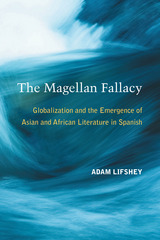 The Magellan Fallacy: Globalization and the Emergence of Asian and African Literature in Spanish
Adam Lifshey
University of Michigan Press, 2012 Winner of the 2015 A-Asia/ICAS Africa-Asia Book Prize, a global competition, for the best book in English, French, or Portuguese on any topic linking Asia and Africa.
The Magellan Fallacy argues that literature in Spanish from Asia and Africa, though virtually unknown, reimagines the supposed centers and peripheries of the modern world in fundamental ways. Through archival research and comparative readings, The Magellan Fallacy rethinks mainstream mappings of diverse cultures while advocating the creation of a new field of scholarship: global literature in Spanish. As the first attempt to analyze Asian and African literature in Spanish together, and doing so while ranging over all continents, The Magellan Fallacy crosses geopolitical and cultural borders without end. The implications of the book, therefore, extend far beyond the lands formerly ruled by the Spanish empire. The Magellan Fallacy shows that all theories of globalization, including those focused on the Americas and Europe, must be able to account for the varied significances of hispanophone Asia and Africa as well.
 Maggie Boylan
Michael Henson
Ohio University Press, 2018 Finalist, 2019 Weatherford Award (Fiction) • A Great Group Reads Selection for National Reading Group Month from The Women’s National Book Association Set in Appalachian Ohio amid an epidemic of prescription opiate abuse, Michael Henson’s linked collection tells of a woman’s search for her own peculiar kind of redemption, and brings the novel-in-stories form to new heights. Maggie Boylan is an addict, thief, liar, and hustler. But she is also a woman of deep compassion and resilience. The stories follow Maggie as she spirals through her addictive process, through the court system and treatment, and into a shaky new beginning. In these masterful stories, we rarely occupy Maggie’s perspective, but instead gain a multilayered portrait of a community as we see other people’s lives bump up against hers—and we witness her inserting herself into their spheres, refusing to be rebuffed. The result is a prismatic view of a community fighting to stay upright against the headwinds of a drug epidemic: always on edge, always human.
The Maghrib in Question: Essays in History and Historiography
Edited by Michel Le Gall and Kenneth Perkins
University of Texas Press, 1997 A wealth of historical writing dealing with the Maghrib (Morocco, Algeria, Tunisia, and Libya) has been published during the roughly forty years since European colonial control ended in the region. This book provides a "state of the field" survey of this postcolonial Maghribi historiography. The book contains thirteen essays by leading Maghribi and North American scholars. The first section surveys the Maghrib as a whole; the second focuses on individual countries of the Maghrib; and the third explores theoretical issues and case studies. Cutting across chronological categories, the book encompasses historiographical writing dealing with all eras, from the ancient Maghrib to the contemporary period.
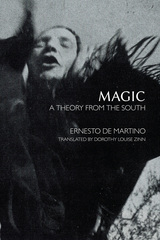 Magic: A Theory from the South
Ernesto de Martino
HAU, 2015 Though his work was little known outside Italian intellectual circles for most of the twentieth century, anthropologist and historian of religions Ernesto de Martino is now recognized as one of the most original thinkers in the field. This book is testament to de Martino’s innovation and engagement with Hegelian historicism and phenomenology—a work of ethnographic theory way ahead of its time. This new translation of Sud e Magia, his 1959 study of ceremonial magic and witchcraft in southern Italy, shows how De Martino is not interested in the question of whether magic is rational or irrational but rather in why it came to be perceived as a problem of knowledge in the first place. Setting his exploration within his wider, pathbreaking theorization of ritual, as well as in the context of his politically sensitive analysis of the global south’s historical encounters with Western science, he presents the development of magic and ritual in Enlightenment Naples as a paradigmatic example of the complex dynamics between dominant and subaltern cultures. Far ahead of its time, Magic is still relevant as anthropologists continue to wrestle with modernity’s relationship with magical thinking.
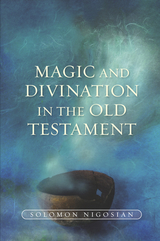 Magic and Divination in the Old Testament
Solomon Nigosian
Sussex Academic Press, 2022 Humans, since time immemorial, have tried to discover and influence the will of spirits and deities that they believed to be in charge of their lives. As a result, all cultures have produced certain special individuals thought to be closely in touch with the powers of the supernatural world. Was this true of ancient Israel? If so, who were the occult experts and what techniques were used by them? This study explores the many practices and rituals associated with magic and divination among the ancient Israelites as documented in the Old Testament. Seeking omens and consulting seers and diviners were widely practiced, though in the biblical text such activities are roundly condemned. Author Solomon Nigosian's scholarly work is written in language that makes it absorbing reading for both the biblical scholar and the layperson. Contents include: The Biblical View: A Survey . Magical Activities . Divinatory Techniques . Magicians Seers and Diviners . An Assessment . Bibliography . Index of Biblical References . Index of Authors . General Index.
 Magic and the Dignity of Man: Pico della Mirandola and His Oration in Modern Memory
Brian P. Copenhaver
Harvard University Press, 2019 “This book is nothing less than the definitive study of a text long considered central to understanding the Renaissance and its place in Western culture.”
—James Hankins, Harvard University
Pico della Mirandola died in 1494 at the age of thirty-one. During his brief and extraordinary life, he invented Christian Kabbalah in a book that was banned by the Catholic Church after he offered to debate his ideas on religion and philosophy with anyone who challenged him. Today he is best known for a short speech, the Oration on the Dignity of Man, written in 1486 but never delivered. Sometimes called a “Manifesto of the Renaissance,” this text has been regarded as the foundation of humanism and a triumph of secular rationality over medieval mysticism.
Brian Copenhaver upends our understanding of Pico’s masterwork by re-examining this key document of modernity. An eminent historian of philosophy, Copenhaver shows that the Oration is not about human dignity. In fact, Pico never wrote an Oration on the Dignity of Man and never heard of that title. Instead he promoted ascetic mysticism, insisting that Christians need help from Jews to find the path to heaven—a journey whose final stages are magic and Kabbalah. Through a rigorous philological reading of this much-studied text, Copenhaver transforms the history of the idea of dignity and reveals how Pico came to be misunderstood over the course of five centuries. Magic and the Dignity of Man is a seismic shift in the study of one of the most remarkable thinkers of the Renaissance.
 The Magic Bullet: A Locked Room Mystery
Larry Millett
University of Minnesota Press, 2020 St. Paul, Minnesota. October 1, 1917. High above the city, a renowned local financier named Artemis Dodge lies facedown on the floor of his armored penthouse sanctuary, a single bullet hole in his head. Thirty stories up, in the city’s tallest building, and not a shred of evidence or sign pointing to anyone having broken into the wealthy man’s fortress. It is—to all appearances—an impossible crime.
Enter Shadwell Rafferty: Irishman, St. Paul saloonkeeper, sometime detective, and old friend of the celebrated sleuth Sherlock Holmes. Summoned by Louis B. Hill—son of railroad magnate James J. Hill—to investigate, Rafferty descends into a world dominated by greedy tycoons and awash in political intrigue and wartime fearmongering. Suspects lurk in every corner of the city—including Dodge’s beautiful young widow, his slippery assistant, and a shadowy anarchist—and Rafferty pursues them from the streets of Ramsey Hill and the rooms of the Ryan Hotel to the labyrinthine caves under the Schmidt brewery. Matching wits with his foes at the police department and his unsavory rival, the St. Paul detective Mordecai Jones, Rafferty knows that in order to bring a killer to justice he must first unravel the riddle of a single bullet fired in a locked room, three hundred feet above the streets of St. Paul.
Set during a bitter streetcar strike and amid the clandestine activities of a ruthless commission charged with enforcing wartime patriotism, Larry Millett has created a classic and perfectly executed locked-room mystery in the great tradition of John Dickson Carr. From locked rooms and civil unrest to murder and wartime paranoia, The Magic Bullet presents Rafferty’s most challenging case, and its gripping conclusion—with a timely assist from Sherlock Holmes—finds both Rafferty and Millett at the top of their games.
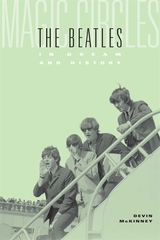 Magic Circles: The Beatles in Dream and History
Devin McKinney
Harvard University Press, 2003 No one expressed the heart and soul of the Sixties as powerfully as the Beatles did through the words, images, and rhythms of their music. In Magic Circles, Devin McKinney uncovers the secret history of a generation and a pivotal moment in twentieth-century culture. He reveals how the Beatles enacted the dream life of their time and shows how they embodied a kaleidoscope of desire and anguish for all who listened—hippies or reactionaries, teenage fans or harried parents, Bob Dylan or Charles Manson. The reader who dares to re-enter the vortex that was the Sixties will appreciate, perhaps for the first time, much of what lay beneath the social trauma of the day.
Delving into concerts and interviews, films and music, outtakes and bootlegs, Devin McKinney brings to bear the insights of history, aesthetics, sociology, psychology, and mythology to account for the depth and resonance of the Beatles’ impact. His book is also a uniquely multifaceted appreciation of the group’s artistic achievement, exploring their music as both timeless expression and visceral response to their historical moment. Starting in the cellars of Liverpool and Hamburg, and continuing through the triumph of Beatlemania, the groundbreaking studio albums, and the last brutal, sorrowful thrust of the White Album, Magic Circles captures both the dream and the reality of four extraordinary musicians and their substance as artists. At once an entrancing narrative and an analytical montage, the book follows the drama, comedy, mystery, irony, and curious off-ramps of investigation and inquiry that contributed to one of the most amazing odysseys in pop culture.
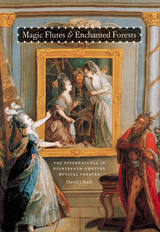 Magic Flutes and Enchanted Forests: The Supernatural in Eighteenth-Century Musical Theater
David J. Buch
University of Chicago Press, 2008 Drawing on hundreds of operas, singspiels, ballets, and plays with supernatural themes, Magic Flutes and Enchanted Forests argues that the tension between fantasy and Enlightenment-era rationality shaped some of the most important works of eighteenth-century musical theater and profoundly influenced how audiences and critics responded to them.
David J. Buch reveals that despite—and perhaps even because of—their fundamental irrationality, fantastic and exotic themes acquired extraordinary force and popularity during the period, pervading theatrical works with music in the French, German, and Italian mainstream. Considering prominent compositions by Gluck, Rameau, and Haydn, as well as many seminal contributions by lesser-known artists, Buch locates the origins of these magical elements in such historical sources as ancient mythology, European fairy tales, the Arabian Nights, and the occult. He concludes with a brilliant excavation of the supernatural roots of Mozart’s The Magic Flute and Don Giovanni, building a new foundation for our understanding of the magical themes that proliferated in Mozart’s wake.
 The Magic Hour: Film At Fin De Siecle
J. Hoberman
Temple University Press, 2003 The "magic hour" is the name film-makers give the pre-dusk late afternoon, when anything photographed can be bathed in a melancholy golden light. A similar mood characterized the movies of the 1990s, occasioned by cinema's 1995-96 centennial and the waning of the twentieth century, as well as the decline of cinephilia and the seemingly universal triumph of Hollywood.The Magic Hour: Film at Fin de Siècle anthologizes J. Hoberman's movie reviews, cultural criticism, and political essays, published in The Village Voice, Artforum, and elsewhere during the period bracketed by the fall of the Berlin Wall and the collapse of the World Trade Towers. Demonstrating Hoberman's range as a critic, this collection reflects on the influence of Fritz Lang, as well as Quentin Tarantino, on the end of the Western and representation of the Gulf War, the Hong Kong neo-wave and the "boomerography" manifest in the cycle of movies inspired by the reign of Bill Clinton. As in his previous anthology, Vulgar Modernism: Writings on Movies and Other Media (nominated for a National Book Critics Circle Award), Hoberman's overriding interest is the intersection of popular culture and political power at the point where the history of film merges with what Jean-Luc Godard called "the film of history."
 Magic in the Ancient World
Fritz Graf
Harvard University Press, 1997 Ancient Greeks and Romans often turned to magic to achieve personal goals. Magical rites were seen as a route for direct access to the gods, for material gains as well as spiritual satisfaction. In this fascinating survey of magical beliefs and practices from the sixth century B.C.E. through late antiquity, Fritz Graf sheds new light on ancient religion.
Evidence of widespread belief in the efficacy of magic is pervasive: the contemporaries of Plato and Aristotle placed voodoo dolls on graves in order to harm business rivals or attract lovers. The Twelve Tables of Roman Law forbids the magical transference of crops from one field to another. Graves, wells, and springs throughout the Mediterranean have yielded vast numbers of Greek and Latin curse tablets. And ancient literature abounds with scenes of magic, from necromancy to love spells. Graf explores the important types of magic in Greco-Roman antiquity, describing rites and explaining the theory behind them. And he characterizes the ancient magician: his training and initiation, social status, and presumed connections with the divine world. With trenchant analysis of underlying conceptions and vivid account of illustrative cases, Graf gives a full picture of the practice of magic and its implications. He concludes with an evaluation of the relation of magic to religion. Magic in the Ancient World offers an unusual look at ancient Greek and Roman thought and a new understanding of popular recourse to the supernatural.
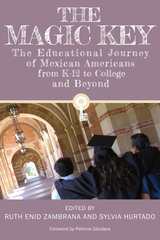 The Magic Key: The Educational Journey of Mexican Americans from K-12 to College and Beyond
Edited by Ruth Enid Zambrana and Sylvia Hurtado
University of Texas Press, 2015 Mexican Americans comprise the largest subgroup of Latina/os, and their path to education can be a difficult one. Yet just as this group is often marginalized, so are their stories, and relatively few studies have chronicled the educational trajectory of Mexican American men and women. In this interdisciplinary collection, editors Zambrana and Hurtado have brought together research studies that reveal new ways to understand how and why members of this subgroup have succeeded and how the facilitators of success in higher education have changed or remained the same. The Magic Key’s four sections explain the context of Mexican American higher education issues, provide conceptual understandings, explore contemporary college experiences, and offer implications for educational policy and future practices. Using historical and contemporary data as well as new conceptual apparatuses, the authors in this collection create a comparative, nuanced approach that brings Mexican Americans’ lived experiences into the dominant discourse of social science and education. This diverse set of studies presents both quantitative and qualitative data by gender to examine trends of generations of Mexican American college students, provides information on perceptions of welcoming university climates, and proffers insights on emergent issues in the field of higher education for this population. Professors and students across disciplines will find this volume indispensable for its insights on the Mexican American educational experience, both past and present.
The Magic Kingdom: Walt Disney and the American Way of Life
Steven Watts
University of Missouri Press, 2001 The Magic Kingdom sheds new light on the cultural icon of "Uncle Walt." Watts digs deeply into Disney's private life, investigating his roles as husband, father, and brother and providing fresh insight into his peculiar psyche-his genuine folksiness and warmth, his domineering treatment of colleagues and friends, his deepest prejudices and passions. Full of colorful sketches of daily life at the Disney Studio and tales about the creation of Disneyland and Disney World, The Magic Kingdom offers a definitive view of one of the most influential Americans of the twentieth century.
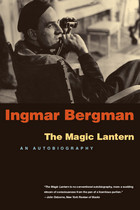 The Magic Lantern: An Autobiography
Ingmar Bergman
University of Chicago Press, 1988 “When a film is not a document, it is a dream. . . . At the editing table, when I run the strip of film through, frame by frame, I still feel that dizzy sense of magic of my childhood.” Bergman, who has conveyed this heady sense of wonder and vision to moviegoers for decades, traces his lifelong love affair with film in his breathtakingly visual autobiography, The Magic Lantern.
More grand mosaic than linear account, Bergman’s vignettes trace his life from a rural Swedish childhood through his work in theater to Hollywood’s golden age, and a tumultuous romantic history that includes five wives and more than a few mistresses. Throughout, Bergman recounts his life in a series of deeply personal flashbacks that document some of the most important moments in twentieth-century filmmaking as well as the private obsessions of the man behind them. Ambitious in scope yet sensitively wrought, The Magic Lantern is a window to the mind of one of our era’s great geniuses. “[Bergman] has found a way to show the soul’s landscape . . . . Many gripping revelations.”—New York Times Book Review “Joan Tate’s translation of this book has delicacy and true pitch . . . The Magic Lantern is as personal and penetrating as a Bergman film, wry, shadowy, austere.”—New Republic “[Bergman] keeps returning to his past, reassessing it, distilling its meaning, offering it to his audiences in dazzling new shapes.”—New York Times “What Bergman does relate, particularly his tangled relationships with his parents, is not only illuminating but quite moving. No ‘tell-all’ book this one, but revealing in ways that much longer and allegedly ‘franker’ books are not.”—Library Journal
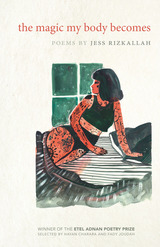 the magic my body becomes: Poems by
Jess Rizkallah
University of Arkansas Press, 2017 Winner, 2017 Etel Adnan Poetry Prize In the magic my body becomes, Jess Rizkallah seeks a vernacular for the inescapable middle ground of being Arab American—a space that she finds, at times, to be too Arab for America and too American for her Lebanese elders. These poems freely assert gender, sexuality, and religious beliefs while at the same time respecting a generational divide: the younger’s privilege gained by the sacrifice of the older, the impossibility of separating what is wholly hers from what is hers secondhand. In exploring family history, civil war, trauma, and Lebanon itself, Rizkallah draws from the spirits of canonical Arab and Middle Eastern poets. As a result of her conjuring, the reader feels these spirits begin to exorcise the grief of those who are still alive. Throughout, there is the body, a reclamation and pushback against cultures that simultaneously sexualize and shame women. And there is a softness as inherent as rage, a resisting of stereotypes that too often speak louder than the complexities of a resilient cultural identity. The magic my body becomes is an exciting new book from an exciting young poet, a love letter to a people as well as a fist in the air.
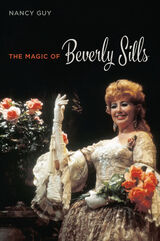 The Magic of Beverly Sills
Nancy Guy
University of Illinois Press, 2015 With her superb coloratura soprano, passion for the world of opera, and down-to-earth personality, Beverly Sills made high art accessible to millions from the time of her meteoric rise to stardom in 1966 until her death in 2007. An unlikely pop culture phenomenon, Sills was equally at ease on talk shows, on the stage, and in the role of arts advocate and administrator. Merging archival research with her own love of Sills's music, Nancy Guy examines the singer-actress's artistry alongside the ineffable aspects of performance that earned Sills a passionate fandom. Guy mines the memories of colleagues, critics, and aficionados to recover something of the spell Sills wove for people on both sides of the footlights during the hot moments of onstage performance. At the same time, she analyzes essential questions raised by Sills's art and celebrity. How did Sills challenge the divide between elite and mass culture and build a fan base that crossed generations and socio-economic lines? Above all, how did Sills capture the unnameable magic that joins the members of an audience to a performer--and to one-another? Intimate and revealing, The Magic of Beverly Sills explores the alchemy of art, magnetism, community, and emotion that produced an American icon.
 The Magic of Children's Gardens: Inspiring Through Creative Design
Lolly Tai
Temple University Press, 2017 Children’s gardens are magical places where kids can interact with plants, see where food and fibers grow, and experience the role of birds, butterflies, and bees in nature. These gardens do more than just expose youngsters to outdoor environments, they also provide marvelous teaching opportunities for them to visit a small plot, care for vegetables and flowers, and interact in creative spaces designed to stimulate all five senses. In The Magic of Children’s Gardens, landscape architect Lolly Tai provides the primary goals, concepts and key considerations for designing outdoor spaces that are attractive to and suitable for children especially in urban environments. Tai presents inspiring ideas for creating children’s green spaces by examining nearly twentycase studies, including the Chicago Botanic Gardens and Longwood Gardens in Kennett Square, PA. The Magic of Children’s Gardens features hundreds of comprehensive drawings and gorgeous photographs of successful children’s outdoor environments, detailed explanations of the design process, and the criteria needed to create attractive and pleasing gardens for children to augment their physical, mental, and emotional development. Exposing youth to well-planned outdoor environments promotes our next generation of environmental stewards. The Magic of Children's Gardens offers practitioners a guide to designing these valued spaces.
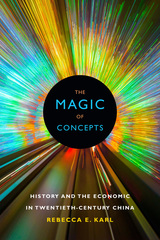 The Magic of Concepts: History and the Economic in Twentieth-Century China
Rebecca E. Karl
Duke University Press, 2017 In The Magic of Concepts Rebecca E. Karl interrogates "the economic" as concept and practice as it was construed historically in China in the 1930s and again in the 1980s and 1990s. Separated by the Chinese Revolution and Mao's socialist experiments, each era witnessed urgent discussions about how to think about economic concepts derived from capitalism in modern China. Both eras were highly cosmopolitan and each faced its own global crisis in economic and historical philosophy: in the 1930s, capitalism's failures suggested that socialism offered a plausible solution, while the abandonment of socialism five decades later provoked a rethinking of the relationship between history and the economic as social practice. Interweaving a critical historiography of modern China with the work of the Marxist-trained economist Wang Yanan, Karl shows how "magical concepts" based on dehistoricized Eurocentric and capitalist conceptions of historical activity that purport to exist outside lived experiences have erased much of the critical import of China's twentieth-century history. In this volume, Karl retrieves the economic to argue for a more nuanced and critical account of twentieth-century Chinese and global historical practice.
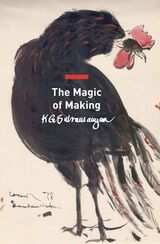 The Magic of Making: Essays on Art and Culture
K. G. Subramanyan
Seagull Books, 2025 Essays on the evolving aesthetic sensibilities of a globalized, rapidly changing world.
In this collection of essays, written by K. G. Subramanyan over twenty-five years, this artist delves into the evolving aesthetic sensibilities in a globalized world, offering profound reflections on art, aesthetics, tradition, and societal challenges. As one of India's most celebrated artists, Subramanyan provides invaluable insights into contemporary art and cultural dynamics
Covering a broad spectrum of topics including art, visual perception, creativity, craft practice, tradition, and societal issues, Subramanyan's essays offer a comprehensive exploration of the complexities shaping modern civilization. He critically examines the impact of globalization, industrialization, environmental degradation, and societal disparities on art, education, and society, urging readers to negotiate these challenges with insight and vigilance.
Subramanyan played a pivotal role in shaping India’s artistic identity after Independence. Mani-da, as he was fondly called, seamlessly blended elements of modernism with folk expression in his works, spanning paintings, murals, sculptures, prints, set designs, and toys. Beyond his visual artistry, his writings have laid a solid foundation for understanding the demands of art on the individual. In the year of his centenary, Seagull is proud to publish his writings in special new editions.
The Magic Screen: A History of Regent Street Cinema
Joost Hunningher, Rikki Morgan-Tamosunas, Guy Osborn and Ro Spankie
University of Westminster Press, 2015 The story of the (now restored) Regent Street Cinema is the fourth volume exploring the University of Westminster's long and diverse history. This multi-authored volume tells its history from architectural, educational, legal and cinematic perspectives and is richly illustrated throughout with images from the University of Westminster archive.
Magic Search
Rebecca S. American Library Association
American Library Association, 2009
 Magic Weapons: Aboriginal Writers Remaking Community after Residential School
Sam McKegney
University of Manitoba Press, 2007 The legacy of the residential school system ripples throughout Native Canada, its fingerprints on the domestic violence, poverty, alcoholism, drug abuse, and suicide rates that continue to cripple many Native communities. Magic Weapons is the first major survey of Indigenous writings on the residential school system, and provides groundbreaking readings of life writings by Rita Joe (Mi’kmaq) and Anthony Apakark Thrasher (Inuit) as well as in-depth critical studies of better known life writings by Basil Johnston (Ojibway) and Tomson Highway (Cree). Magic Weapons examines the ways in which Indigenous survivors of residential school mobilize narrative in their struggles for personal and communal empowerment in the shadow of attempted cultural genocide. By treating Indigenous life-writings as carefully crafted aesthetic creations and interrogating their relationship to more overtly politicized historical discourses, Sam McKegney argues that Indigenous life-writings are culturally generative in ways that go beyond disclosure and recompense, re-envisioning what it means to live and write as Indigenous individuals in post-residential school Canada.
The Magic World of Orson Welles
James Naremore
University of Illinois Press, 2015 Prodigy. Iconoclast. Genius. Exile. Orson Welles remains one of the most discussed figures in cinematic history. In the centenary year of Welles's birth, James Naremore presents a revised third edition of this incomparable study, including a new section on the unfinished film The Other Side of the Wind. Naremore analyzes the political and psychological implications of the films, Welles's idiosyncratic style, and the biographical details--both playful and vexing--that impacted each work. Itself a historic film study, The Magic World of Orson Welles unlocks the soaring art and quixotic methods of a master.
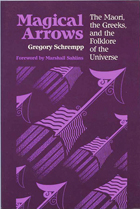 Magical Arrows: The Maori, The Greeks, And The Folklore Of The Universe
Gregory A. Schrempp
University of Wisconsin Press, 1992 A fascinating and sophisticated exploration of cosmology, Magical Arrows connects the Western philosophical tradition with the cosmological traditions of non-Western societies, particularly those of Polynesia. Using the mythology and philosophy of the Maori of New Zealand as a counterpoint to Western thought, Schrempp finds a philosophical common denominator in the thought of the pre-Socratic philosopher, Zeno of Elea. Schrempp suggests that the paradoxes of Zeno, together with the philosophical speculations that they have historically inspired, contain sophisticated insights which are nevertheless general enough to form the foundations of a comparative cosmology.
Schrempp suggests that perhaps the most noteworthy Zenoian insight is that paradox is intrinsic to cosmological speculation. But he points out that there are many other characteristics of Zeno’s approach, including the strategy of juxtaposing concrete images to mathematical forms of representation, that reappear persistently in Western intellectual history. Schrempp proceeds through a series of juxtapositions—between Zeno, Kant, Lovejoy, and Lévi-Strauss, and between Western cosmologists and those from other cultures—to highlight subtle similarities and differences among intellectual traditions and to examine the conceptual apparatus of Western social science.
Schrempp concludes that a meaningful comparative cosmology is possible and that the tradition of Zeno provides a propitious starting point for such a perspective.
The Magical Art of Virgil
E. K. Rand
Harvard University Press The purpose of this volume is threefold. It seeks to illustrate the poet’s magical art of moulding heterogeneous substances into a harmony; it traces the growth of the epic spirit in his works; and it lays before the reader an account of the Eclogues, the Georgics, and the Minor Poems attributed to Virgil, in which, as is not always done, the interpretation of the poet’s art is accompanied by such an exposition of the contents of his works that the reader may perceive the basis of the judgments given. In the case of the Aeneid, for which such an exposition is not so necessary, attention is centered on Virgil’s transformation of romance into tragedy, his infusion of tragedy into epic, and his magical art of making over modern places—the Palatine, the Sibyl’s cave at Cumae—to fit the demands of an epic of primitive times.
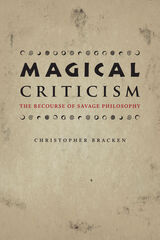 Magical Criticism: The Recourse of Savage Philosophy
Christopher Bracken
University of Chicago Press, 2007 During the Enlightenment, Western scholars racialized ideas, deeming knowledge based on reality superior to that based on ideality. Scholars labeled inquiries into ideality, such as animism and soul-migration, “savage philosophy,” a clear indicator of the racism motivating the distinction between the real and the ideal. In their view, the savage philosopher mistakes connections between signs for connections between real objects and believes that discourse can have physical effects—in other words, they believe in magic.
Christopher Bracken’s Magical Criticism brings the unacknowledged history of this racialization to light and shows how, even as we have rejected ethnocentric notions of “the savage,” they remain active today in everything from attacks on postmodernism to Native American land disputes. Here Bracken reveals that many of the most influential Western thinkers dabbled in savage philosophy, from Marx, Nietzsche, and Proust, to Freud, C. S. Peirce, and Walter Benjamin. For Bracken, this recourse to savage philosophy presents an opportunity to reclaim a magical criticism that can explain the very real effects created by the discourse of historians, anthropologists, philosophers, the media, and governments.
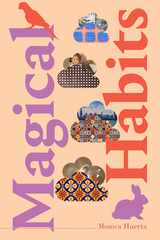 Magical Habits
Monica Huerta
Duke University Press, 2021 In Magical Habits Monica Huerta draws on her experiences growing up in her family's Mexican restaurants and her life as a scholar of literature and culture to meditate on how relationships among self, place, race, and storytelling contend with both the afterlives of history and racial capitalism. Whether dwelling on mundane aspects of everyday life, such as the smell of old kitchen grease, or grappling with the thorny, unsatisfying question of authenticity, Huerta stages a dynamic conversation among genres, voices, and archives: personal and critical essays exist alongside a fairy tale; photographs and restaurant menus complement fictional monologues based on her family's history. Developing a new mode of criticism through storytelling, Huerta takes readers through Cook County courtrooms, the Cristero Rebellion (in which her great-grandfather was martyred by the Mexican government), Japanese baths in San Francisco—and a little bit about Chaucer too. Ultimately, Huerta sketches out habits of living while thinking that allow us to consider what it means to live with and try to peer beyond history even as we are caught up in the middle of it.
Duke University Press Scholars of Color First Book Award recipient
Magical Marxism: Subversive Politics and the Imagination
Andy Merrifield
Pluto Press, 2011 Following his hugely popular book, The Wisdom of Donkeys, Andy Merrifield breathes new life into the Marxist tradition.
Magical Marxism demands something more of traditional Marxism - something more interesting and liberating. It asks that we imagine a Marxism that moves beyond debates about class, the role of the state and the dictatorship of the proletariat. In escaping the formalist straitjacket of orthodox Marxist critique, Merrifield argues for a reconsideration of Marxism and its potential, applying previously unexplored approaches to Marxist thinking that will reveal vital new modes of political activism and debate.
This book will provoke and inspire in equal measure. It gives us a Marxism for the 21st century, which offers dramatic new possibilities for political engagement.
|
|
